ZTE MC2718 CDMA2000 1X EV-DO Wireless Module User Manual
ZTE Corporation CDMA2000 1X EV-DO Wireless Module
ZTE >
User Manual
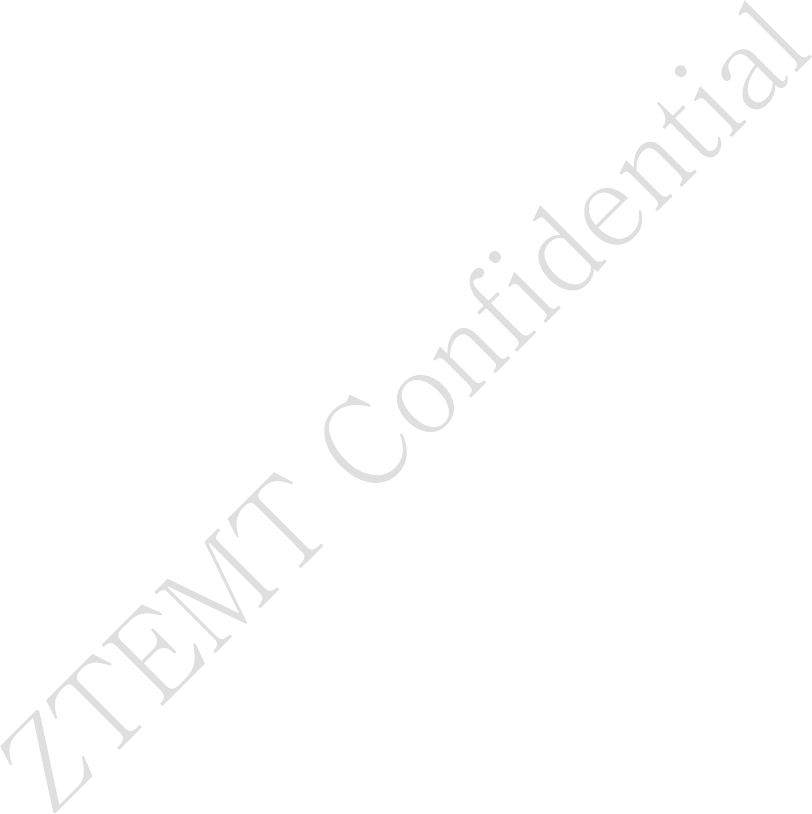
Open▲
Technology Document
MC2718 AT Command User Manual
Version:V1.1
SHEN ZHEN ZTE MOBILE TECH CO., LTD.
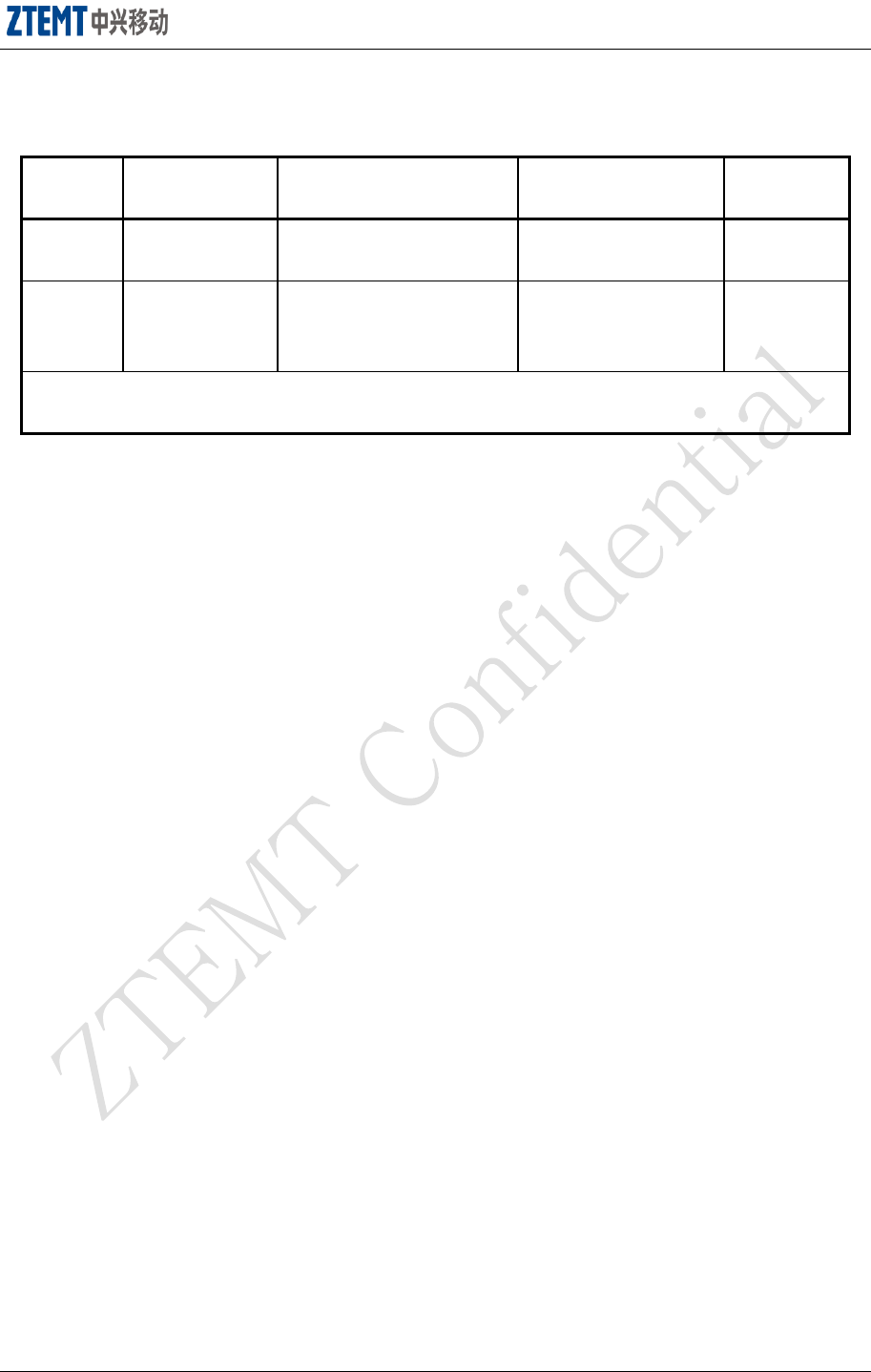
AT Command User Manual V1.1 Open▲
Page 2 of 52
Update History
Version
Update section
Type of Revision
author
Release
Date
V1.0
Lihongjun
Zhangxiaowei
03/10/2010
V1.1
Changed/added/replaced
many items
Wanghuan
Zhouxianghui
Zhangxiaowei
05/24/2010
Bak 1:The update history is added after this document is update.
Bak 2:This version only support sprint at command.
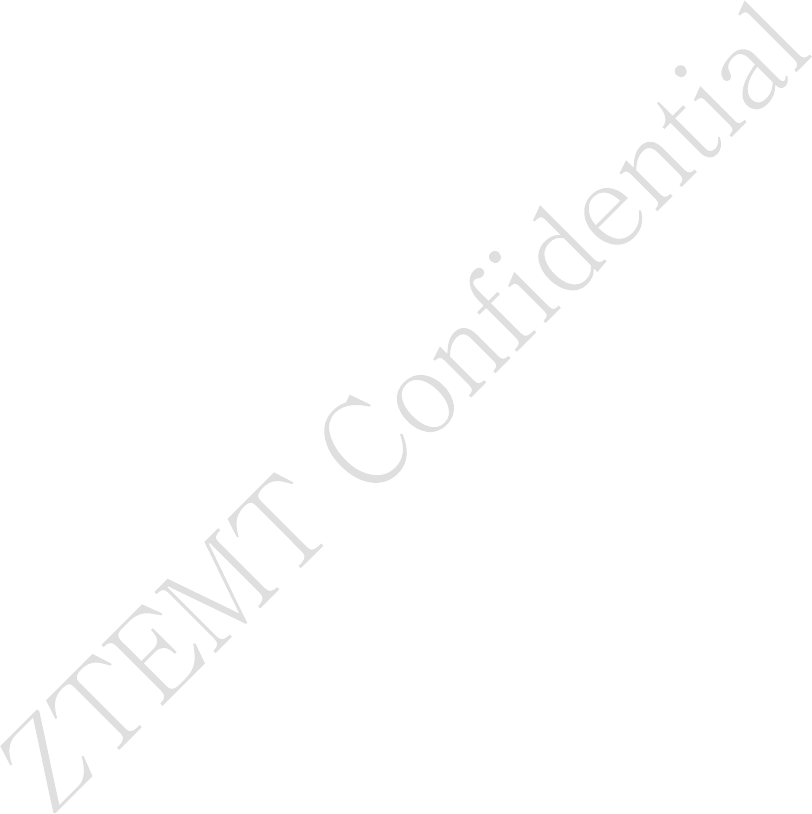
Open▲
Table of Contents
1 ZTE AT Commands ...................................................................................... 6
1.1 Proprietary Interface: Voice Call Interface(only support MC2718) ........................................ 6
1.1.1 +ZORIG: Call Originated ................................................................................................ 6
1.1.2 +ZCONN: Call Connected .............................................................................................. 6
1.1.3 +ZCEND: Call Ended ..................................................................................................... 6
1.1.4 +ZDTMF: Redial command ............................................................................................ 7
1.1.5 +ZCVOICE: Switch Audio Mode ................................................................................... 8
1.2 SMS Text Mode Command ..................................................................................................... 8
1.2.1 +CPMS: Preferred Message Storage ............................................................................... 9
1.2.2 +CMGF: Message Format ............................................................................................. 10
1.2.3 +CNMI: New Message Indications to TE ..................................................................... 10
1.2.4 +CMTI: Message Arrival Indication ............................................................................. 11
1.2.5 +CDSI: New Message Status Report ............................................................................. 12
1.2.6 +CMGD: Delete Messages ............................................................................................ 12
1.2.7 +CNMA: Acknowledge New Messages ........................................................................ 12
1.3 Proprietary Interface: SMS Interface ..................................................................................... 13
1.3.1 +ZSMMEMFULL: SMS Storage memory full ............................................................. 13
1.3.2 +ZCMT: Don‟t save newly received messages, and report to TE directly .................... 13
1.3.3 +ZCDS: New SMS Status Direct Report ...................................................................... 14
1.3.4 +ZCMGS: Send Message .............................................................................................. 14
1.3.5 +ZCMGW: Write Message to Memory ......................................................................... 16
1.3.6 +ZCMGL: List Messages .............................................................................................. 18
1.3.7 +ZCMGR: Read Message ............................................................................................. 19
1.3.8 +ZCMGSS: Message Sent Report ................................................................................. 20
1.3.9 +ZCMGSF: Message Unsent Report ............................................................................. 20
2 Basic AT Commands ................................................................................... 21
2.1.1 E: Turn off/on echo commands ..................................................................................... 21
2.1.2 Q: Enable/Disable return result codes ........................................................................... 21
2.1.3 V: Return result codes as numbers/words ...................................................................... 21
2.1.4 Z0: Reset the parameters to the default configuration ................................................... 22
2.1.5 &C: Set circuit 109 (CF) or Received Line Signal Detector (RLSD) ........................... 22
2.1.6 &D: Set DTR(Data Terminal Ready) Signal ................................................................. 22
2.1.7 A: Answer ...................................................................................................................... 23
2.1.8 RING: Incoming Call .................................................................................................... 23
3 Extended AT Configuration Commands ................................................... 23
3.1.1 +CDV: Dial .................................................................................................................... 23
3.1.2 +CHV: Hang up ............................................................................................................. 23
3.1.3 +GCAP: Return the list of all commands supported by the device ............................... 24
3.1.4 +GMI: Return the manufacturer name on a single line ................................................. 24
3.1.5 +GMM: Return the device model name and number .................................................... 24
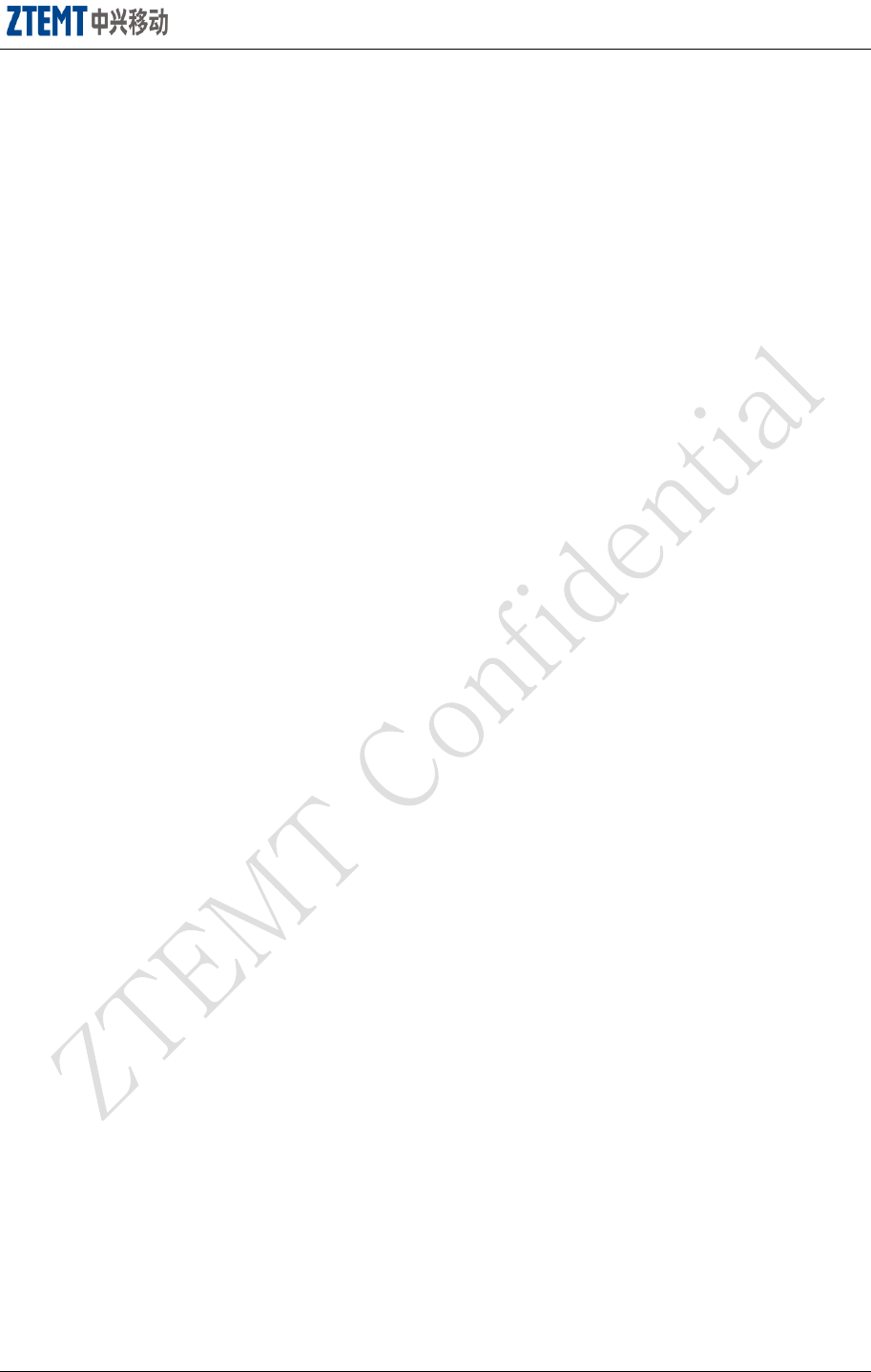
AT Command User Manual V1.1 Open▲
Page 4 of 52
3.1.6 +GMR: Return the current firmware version on a single line ....................................... 24
3.1.7 +GSN: Get the ESN of device ....................................................................................... 25
3.1.8 +ICF: Set the character framing .................................................................................... 25
3.1.9 +IFC: Control the local flow control ............................................................................. 26
3.1.10 +IPR: Set the Rm interface rate ..................................................................................... 27
3.1.11 +CAD: Return the type of service available .................................................................. 28
3.1.12 +CRM: Get he current numerical value of CRM .......................................................... 28
3.1.13 +CBC: The battery state and charge(not supported for modem) ................................... 28
3.1.14 +CMIP: IP address of the mobile station ....................................................................... 29
3.1.15 +CBIP: IP address of the base station............................................................................ 29
3.1.16 +CSS: The serving system band and SID ...................................................................... 29
3.1.17 +CSQ: Signal Quality Measure and the Frame Error Rate ............................................ 30
3.1.18 +CTA: The packet data inactivity timer ........................................................................ 30
3.1.19 +CPS: The service option to be used for packet data service(Not implemented) ......... 31
3.1.20 +CPSR: Disable/Enable the packet call state reporting(Not implemented) .................. 31
3.1.21 +CPTC: Request a traffic channel(Not implemented) ................................................... 32
3.1.22 +CPER: Disable/Enable the packet call event reporting(Not implemented) ................. 33
4 Qualcomm Proprietary AT Command Set ............................................... 33
4.1.1 $QCMIP: The current value of the Mobile IP behavior ................................................ 33
4.1.2 $QCMIPP: Return the current active Mobile IP profile ................................................ 34
4.1.3 $QCMIPT:The current value of the “RFC 2002bis authentication” flag ...................... 34
4.1.4 $QCMIPEP: Disable/Enable the active profile ............................................................. 34
4.1.5 $QCMIPGETP: The values of the specified profile ...................................................... 34
4.1.6 $QCMIPNAI: Set ASCII NAI string ............................................................................. 35
4.1.7 $QCMIPRT: Set user reverse tunneling flag ................................................................. 36
4.1.8 $QCMIPMASS: Set ASCII Mobile Node AAA shared secret string ............................ 36
4.1.9 $QCMIPMASSX: Set Hex Mobile Node AAA shared secret ....................................... 37
4.1.10 $QCMIPMHSS: Set ASCII Mobile Node Home Agent shared secret .......................... 38
4.1.11 $QCMIPMASSX: Set hex Mobile Node Home Agent shared secret ............................ 38
4.1.12 $QCMIPMASPI: Set Mobile Node AAA SPI integer value ......................................... 39
4.1.13 $QCMIPMHSPI: Set Mobile Node Home Agent SPI integer value ............................. 40
4.1.14 $QCMIPPHA: Set Primary Home Agent IP Address .................................................... 40
4.1.15 $QCMIPSHA: Set secondary Home Agent IP Address ................................................. 40
4.1.16 $QCMIPHA: Set Home Agent IP Address .................................................................... 41
5 Sprint Specific AT Commands ................................................................... 41
5.1 CDMA AT Commands .......................................................................................................... 41
5.1.1 ATD: Make a packet data call ....................................................................................... 41
5.1.2 $MDN: Return the 10 digit mobile directory number ................................................... 42
5.1.3 $MSID: Return Mobile Station ID ................................................................................ 42
5.1.4 $MIPERR: Return the last MIP error code received by the device ............................... 42
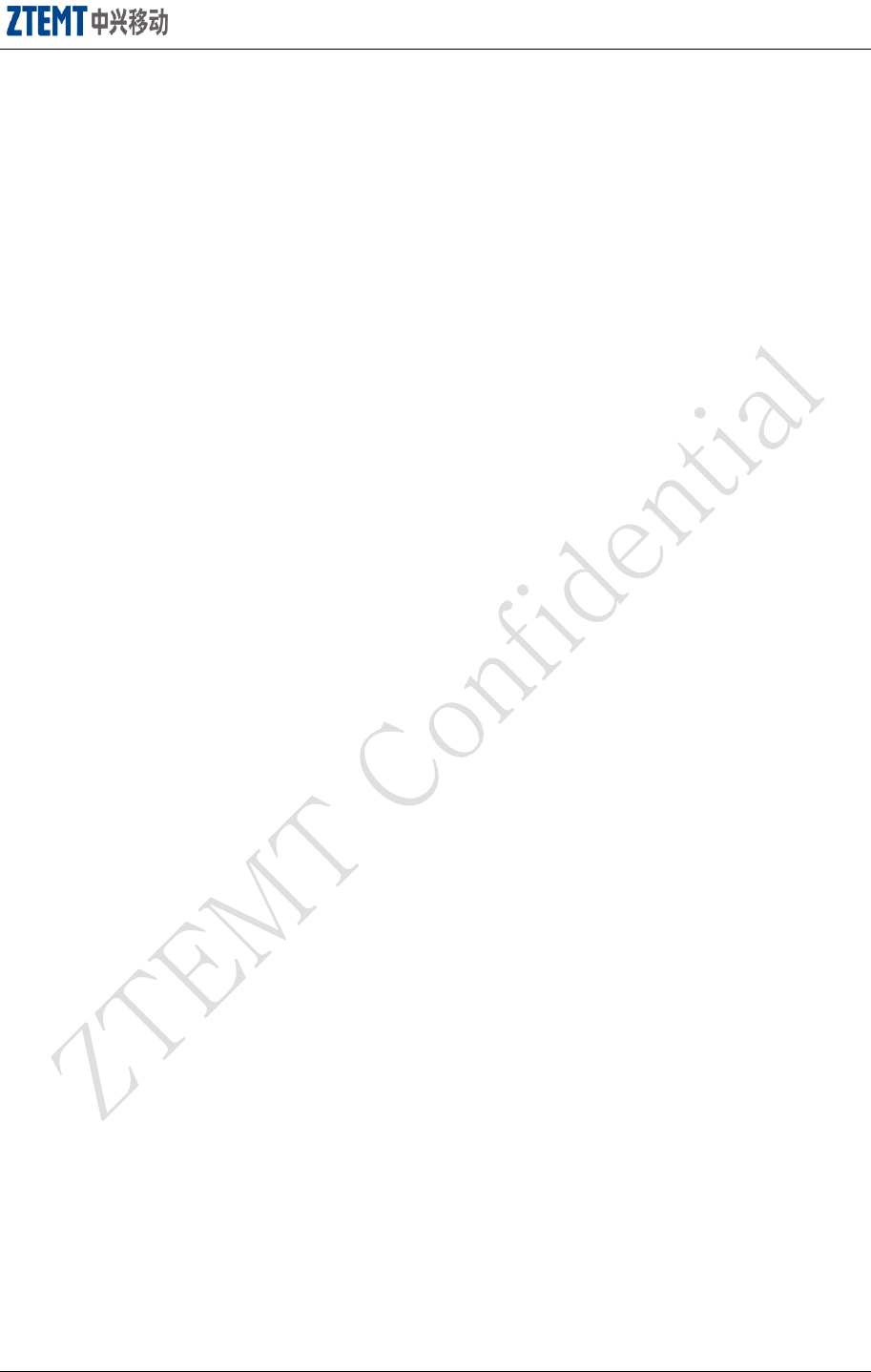
AT Command User Manual V1.1 Open▲
Page 5 of 52
5.1.5 $ERI: Return the current Enhanced Roaming Indicator value ...................................... 42
5.1.6 $ROAM: Set the device mode ....................................................................................... 43
5.1.7 $RMGUARD: Set roam guard(Not implemented) ........................................................ 43
5.2 OMA-DM commands ............................................................................................................ 43
5.2.1 +OMADM: Disable/Enable OMA-DM capabilities ..................................................... 43
5.2.2 +OMALOG: Disable/Enable OMA-DM client logging ................................................ 44
5.2.3 +FUMO: Disable/Enable FUMO capabilities ............................................................... 44
5.2.4 +PRL: Get CDMA PRL version of the device .............................................................. 45
5.3 Device reset commands ......................................................................................................... 45
5.3.1 $RTN: Set the device to factory defaults ....................................................................... 45
5.3.2 $RESET: Initiate a device power cycle ......................................................................... 46
5.4 LED commands ..................................................................................................................... 46
5.4.1 $LED: Disable/Enable all LEDs on the device(not supported) ..................................... 46
5.5 Debug commands .................................................................................................................. 46
5.5.1 +SERVICE: Return the integer index of data service.................................................... 46
5.5.2 $1XRXPWR: Return CDMA 1X channel, Pilot, and immediate RSSI ......................... 47
5.5.3 $DORXPWR: Return the EVDO channel, Pilot, and immediate RSSI ........................ 47
5.5.4 $1XECIO: Return the CDMA 1X Channel, Pilot, and immediate Ec/Io....................... 47
5.5.5 $DOECIO: Return EVDO channel, Pilot, and immediate RSSI ................................... 48
5.5.6 $DEBUG: Return the debug information ...................................................................... 48
5.6 Location commands(only support MC2718) ......................................................................... 48
5.6.1 $LOCATION: Enable/Disable the location service ....................................................... 48
5.6.2 $PDE: Set PDE Server IP and Port................................................................................ 48
5.6.3 $GETLOCATION: Get the device current location in the specified format ................. 49
5.6.4 $LOCMODE: Set the GPS location mode .................................................................... 50
5.6.5 $NMEA: Enable/Disable the NMEA 183 standard stream ........................................... 51
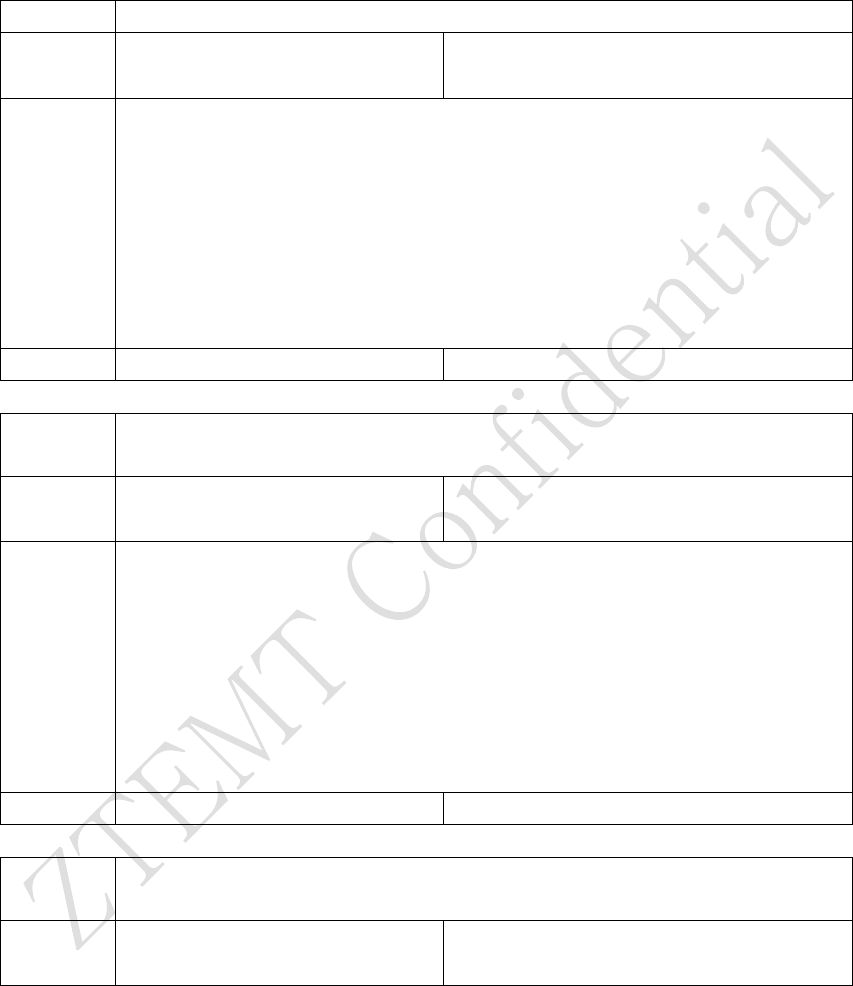
Open▲
1 ZTE AT Commands
1.1 Proprietary Interface: Voice Call Interface(only support MC2718)
1.1.1 +ZORIG: Call Originated
description
Indicating MT for originating a call
format
<CR><LF>+ZORIG: <call_x>,<call_type>
<CR><LF>
parameter
<call_x>
Call ID, ranging from 1~6.
<call_type>
Take the value as below:
0: voice call
7: OTA call (standard OTASP numbers)
8: OTA call (none standard OTASP numbers)
9: Emergency call
example
+ZORIG:0,0
1.1.2 +ZCONN: Call Connected
description
When the call is connected, MT will report it to TE, indicating the current status has
already become to call status
format
<CR><LF>+ZCONN: <call_x>,<call_type>
<CR><LF>
parameter
<call_x>
Call ID, ranging from 1~6
<call_type>
Take the value as below:
0: voice call
7: OTA call (standard OTASP numbers)
8: OTA call (none standard OTASP numbers)
9: Emergency call
example
+ZCONN: 0,0
1.1.3 +ZCEND: Call Ended
description
When the call is ended, MT will report it to TE, inform TE the reason of ending the
call and the talk duration
format
<CR><LF>+ZCEND: <call_x>,<duration>,
<end_status><CR><LF>
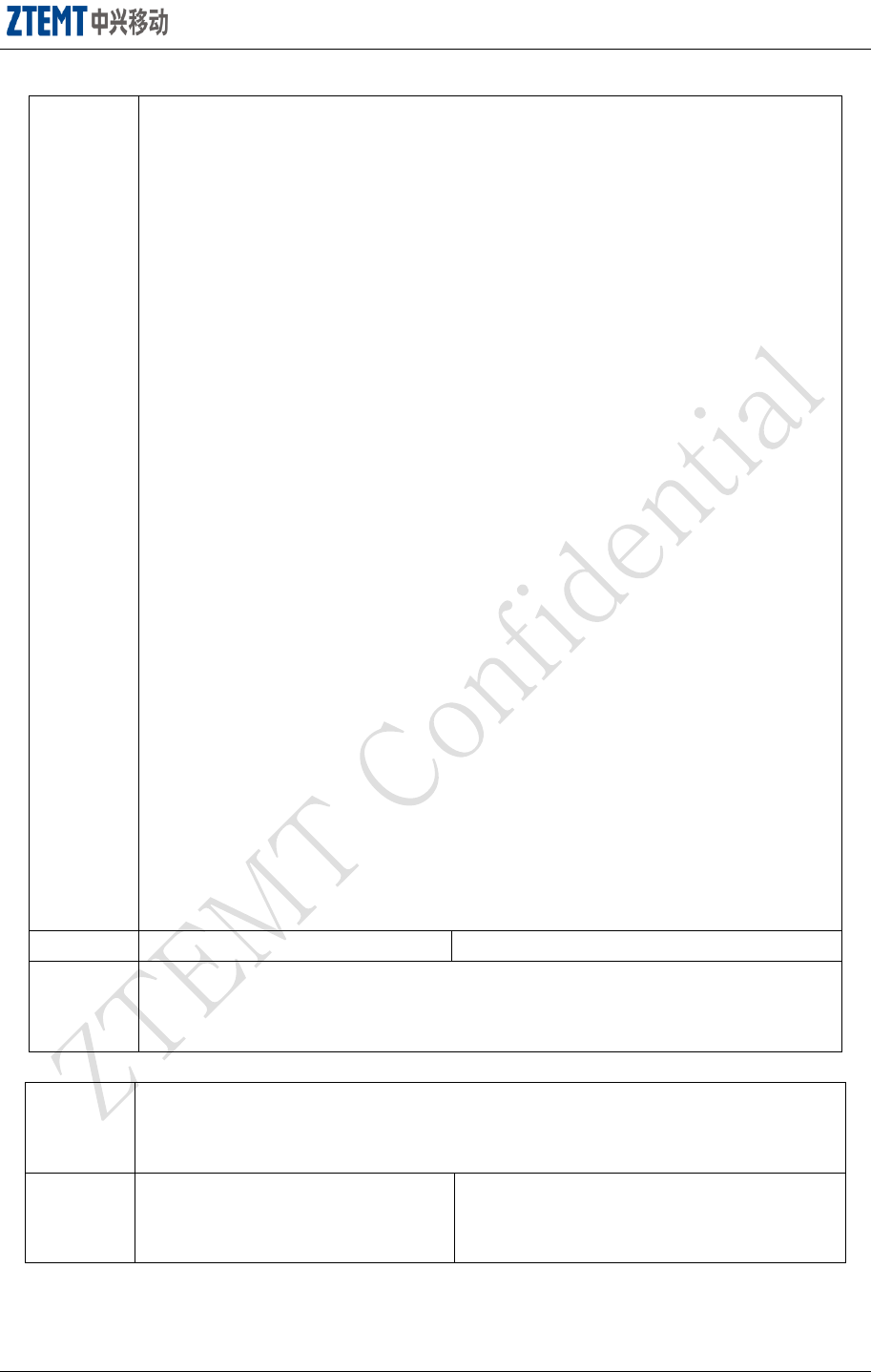
AT Command User Manual V1.1 Open▲
Page 7 of 52
parameter
<call_x>
Call ID,ranging from 0-6
<duration>
talk duration, unit: s
<end_status>:call ended reason
CM_CALL_END_OFFLINE=0, single board at OFFLINE
CM_CALL_END_NO_SRV=21, single board no service
CM_CALL_END_FADE=22, ended normally
CM_CALL_END_INTERCEPT=23, intercepted by BS during the calling
CM_CALL_END_REORDER=24, receive the recorder from BS during the calling
CM_CALL_END_REL_NORMAL=25, call released by BS
CM_CALL_END_REL_SO_REJ=26, current SO rejected by BS
CM_CALL_END_INCOM_CALL=27, receive the call from BS
CM_CALL_END_ALERT_STOP=28, receive the signal of stopping ringer upon
incoming call
CM_CALL_END_CLIENT_END=29, client end ended normally
CM_CALL_END_ACTIVATION=30, activation ended upon OTASP call
CM_CALL_END_MC_ABORT=31, MC stops originating a call or conversation
CM_CALL_END_RUIM_NOT_PRESENT=34, RUIM does not exist
CM_CALL_END_NDSS_FAIL=99, NDSS error
CM_CALL_END_LL_CAUSE=100, release from bottom layer
CM_CALL_END_CONF_FAILED=101, network response failed after call
originating
CM_CALL_END_INCOM_REJ=102, rejected as called.
CM_CALL_END_SETUP_REJ=103, rejected during the call connecting
CM_CALL_END_NETWORK_END=104, release due to network
CM_CALL_END_NO_FUNDS=105, No funds
CM_CALL_END_NO_GW_SRV=106, Not in service area
example
+ZCEND: 0,10,25,17
note
If call is ended due to network side, the string <cc_cause> will be reported; if the
local call is ended before responded by the network side, the string <cc_cause> will
not be reported
1.1.4 +ZDTMF: Redial command
description
Under talk status, send DTMF value to network side through the signal, and at the
same time play DTMF tone at the single board side. The back-end software notifies
the single board to press down and release the keys through AT command.
format
AT+ZDTMF=<call_x>,<dtmf_digit>
[,<on_length>[,<off_length>] ]
<CR><LF>OK<CR><LF>
otherwise:
+CMS ERROR: <err>
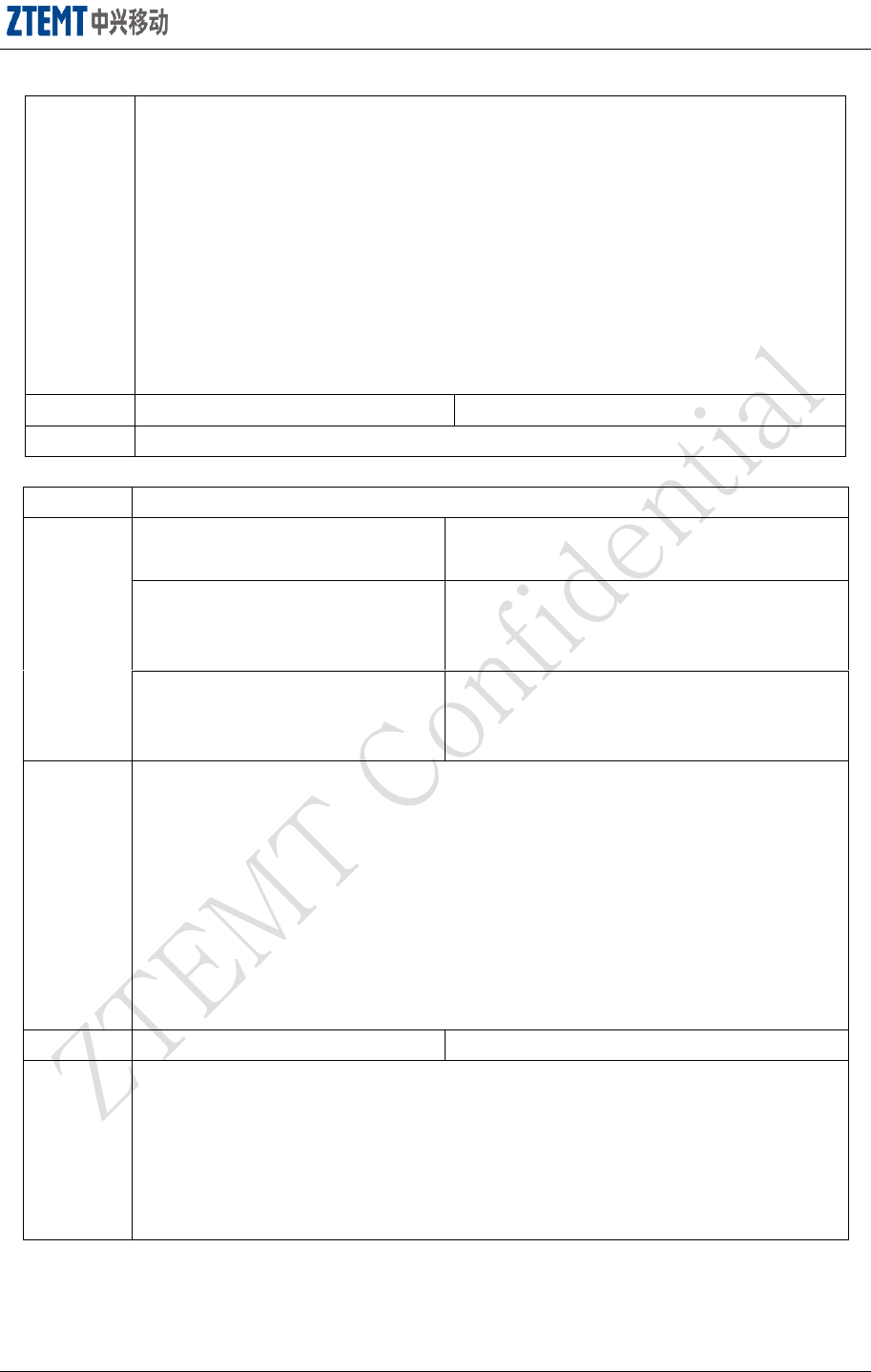
AT Command User Manual V1.1 Open▲
Page 8 of 52
parameter
<call_x>
call ID
<dtmf_digit>
DTMF value, ASCII code, the legal characters only include: „0„~„9„, „*„ , „#„
<on_length>
1: key pressed down
0: key released up
95,150,200,250,300,350 is DTMF time length, unit: ms
<off_length>
under burst, DTMF interval, unit: ms, reserved temporarily
example
AT+ZDTMF=0,0,1
OK
note
1.1.5 +ZCVOICE: Switch Audio Mode
description
Switch audio mode
format
AT+ZCVOICE=<mode>
<CR><LF>OK<CR><LF>
AT+ZCVOICE?
<CR><LF>+ZCVOICE: <mode >
[,<sampling_rate>,<data_bit>,<frame_period>]
<CR><LF><CR><LF>OK<CR><LF>
AT+ZCVOICE=?
<CR><LF>+ZCVOICE: (list of supported
<mode >s) <CR><LF><CR><LF>OK
<CR><LF>
parameter
<mode>
audio mode
0: PC audio mode
<sampling _rate>
sampling rate,
<data_bit>
data bit
<frame_period>
frame period, unit: ms
example
AT+ZCVOICE=1
OK
note
READ command is used to read current audio mode. The data frame from PC audio
adopts PCM coding and returns the sampling rate, data bit and frame period of PCM
data frame (default setting must support PCM frame format with 8000Hz sampling
rate, 16-bit data and 20ms frame period).
TEST command is used to return the value range for audio mode
MC2718 only supports PC audio mode
1.2 SMS Text Mode Command
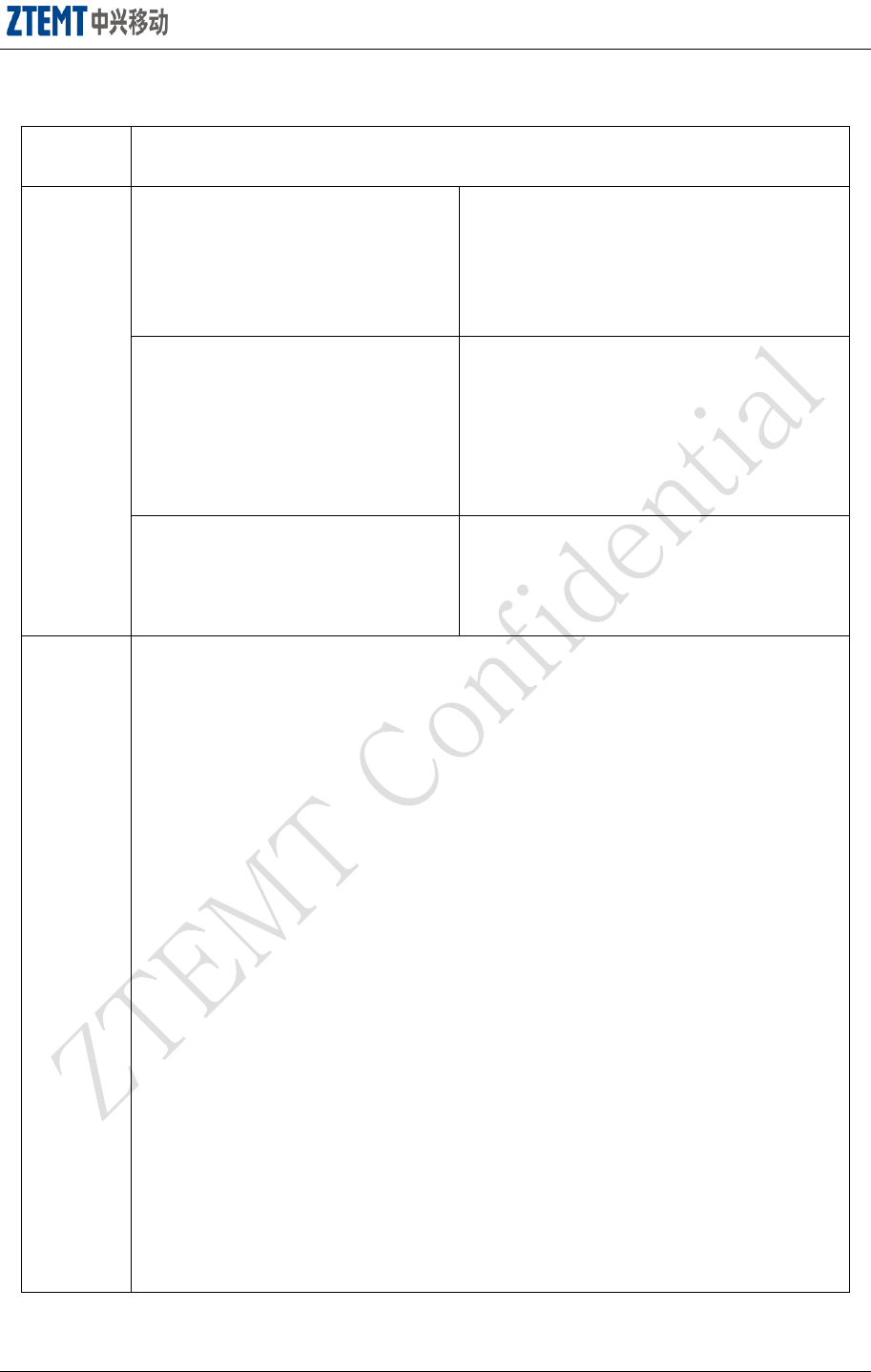
AT Command User Manual V1.1 Open▲
Page 9 of 52
1.2.1 +CPMS: Preferred Message Storage
description
SET command is used to set the corresponding SMS storage media and return the
current using information of selected storage media
format
AT+CPMS=<mem1>
[,<mem2>[,<mem3>]]
<CR><LF>+CPMS: <used1>,<total1>,
<used2>,<total2>,<used3>,<total3>
<CR><LF><CR><LF>OK<CR><LF>
otherwise:
+CMS ERROR: <err>
AT+CPMS?
+CPMS: <mem1>,<used1>,<total1>,
<mem2>,<used2>,<total2>,<mem3>,
<used3>,<total3><CR><LF><CR>
<LF>OK<CR><LF>
otherwise:
+CMS ERROR: <err>
AT+CPMS=?
+CPMS: (list of supported <mem1>s),
(list of supported <mem2>s),
(list of supported <mem3>s)
<CR><LF><CR><LF>OK<CR><LF>
parameter
<mem1>
Value of character string, indicating the storage media for reading/deleting SMS; the
optional value can be:
“ME”: indicating NV
<mem2>
Value of character string, indicating the storage media for writing/sending SMS; the
optional value is the same as <mem1>.
<mem3>
Value of character string, indicating the storage media for receiving SMS; the optional
value is the same as <mem1>
<total1>
Value of integral number, indicating the total number of messages saved in <mem1>
<total2>
Value of integral number, indicating the total number of messages saved in <mem2>
<total3>
Value of integral number, indicating the total number of messages saved in <mem3>
<used1>
Value of integral number, indicating the current number of messages in <mem1>
<used2>
Value of integral number, indicating the current number of messages in <mem2>
<used3>
Value of integral number, indicating the current number of messages in <mem3>
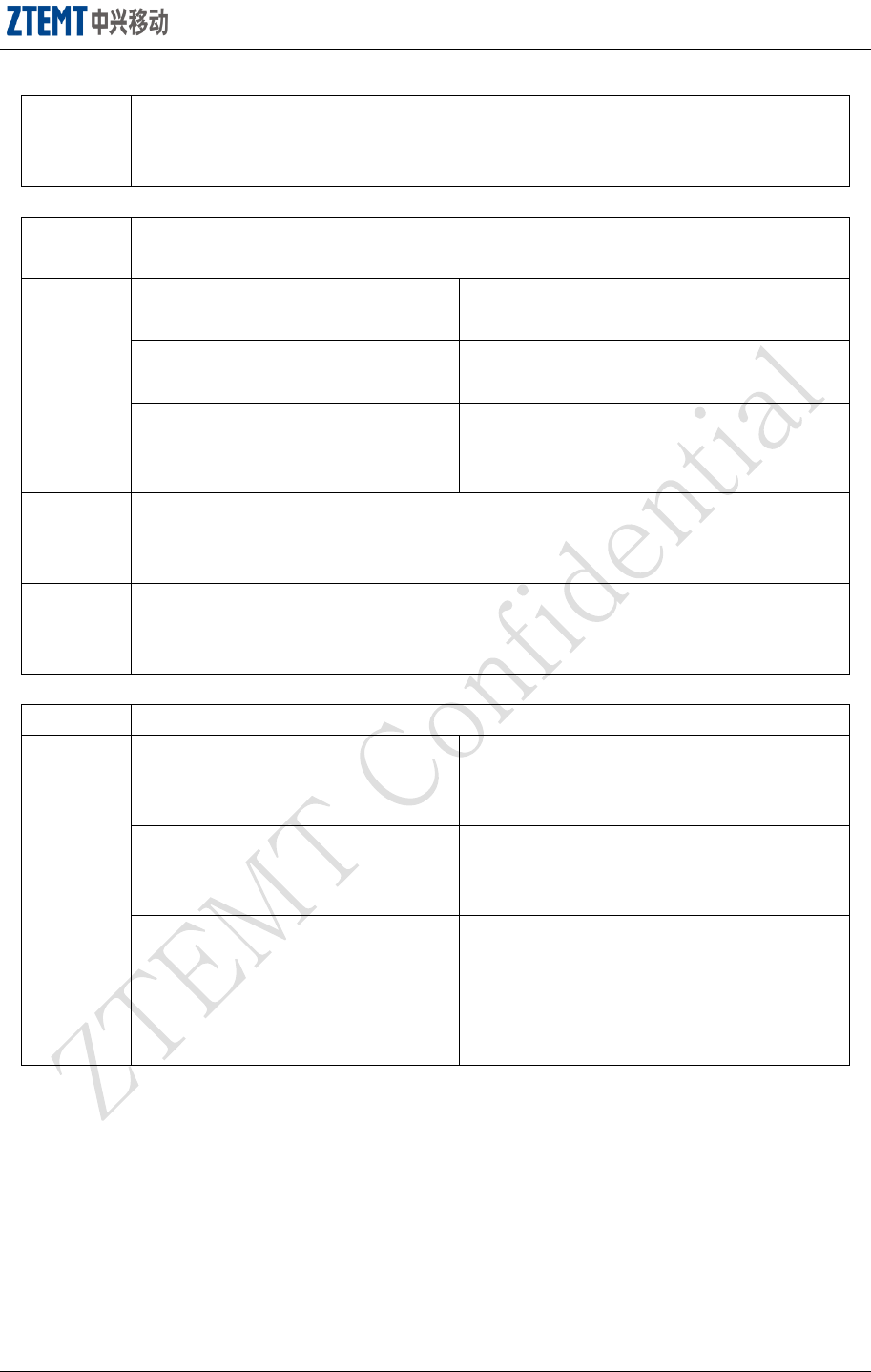
AT Command User Manual V1.1 Open▲
Page 10 of 52
note
READ command is used to return the name and using information of current selected
storage media. TEST command is used to return all types of storage media MT
supports
1.2.2 +CMGF: Message Format
description
SET command is used to set the message format. There are two kinds of modes,
determined by <mode> parameter. It only adopts TEXT mode currently.
format
AT+CMGF[=<mode>]
<CR><LF>OK<CR><LF>
AT+CMGF?
<CR><LF>+CMGF: <mode><CR><LF>
<CR><LF>OK<CR><LF>
AT+CMGF=?
<CR><LF>+CMGF: (list of supported
<mode>s)<CR><LF><CR><LF> OK
<CR><LF>
parameter
<mode>
0: PDU mode (default when implemented)
1: text mode
note
READ command is used to return current the mode selection
TEST command is used to return <mode > value
Now we support text mode only
1.2.3 +CNMI: New Message Indications to TE
description
Set command is used to set the procedure that new messages are reported to TE.
format
AT+CNMI=[<mode>[,<mt>[,<bm>
[,<ds>[,<bfr>]]]]]
<CR><LF>OK<CR><LF>
otherwise:
+CMS ERROR: <err>
AT+CNMI?
<CR><LF>+CNMI:
<mode>,<mt>,<bm>,<ds>,<bfr>
<CR><LF><CR><LF>OK<CR><LF>
AT+CNMI=?
<CR><LF>+CNMI: (list of supported
<mode>s),(list of supported <mt>s),(list of
supported <bm>s),(list of supported
<ds>s),(list of supported <bfr>s)
<CR><LF><CR><LF>OK<CR><LF>
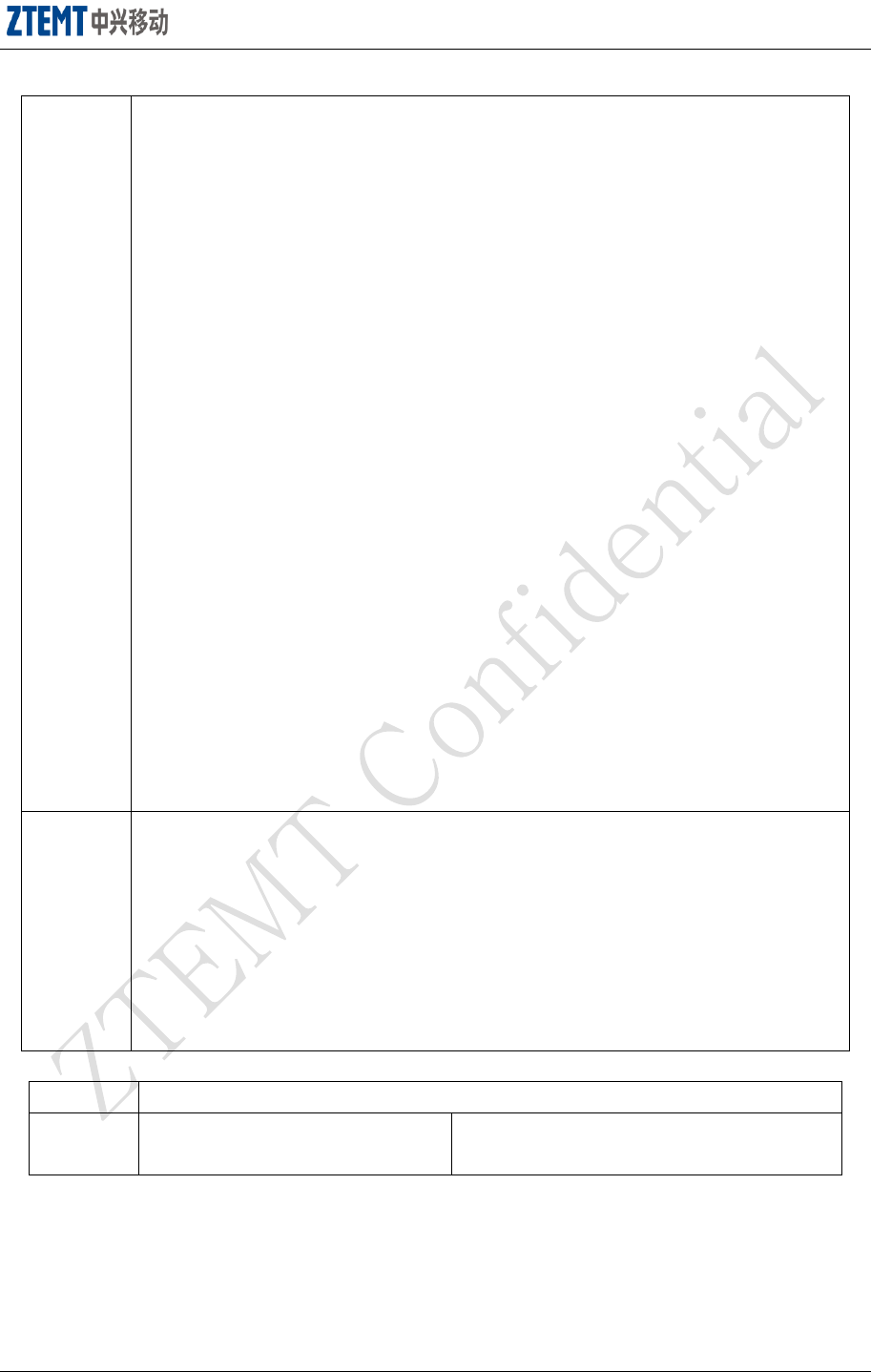
AT Command User Manual V1.1 Open▲
Page 11 of 52
parameter
<mode>: set the message notice method (currently support mode=1).
0: cache the message notice in ME. If ME‟s cache memory is full, new notice will
cover the older one
1: directly send the message notice to TE. When it is unable to send (e.g.. under online
data mode), give up the notice.
2: directly send the message notice and message status report to TE. When it is unable
to send (e.g.. under online data mode), cache the message notice into ME, and send to
TE at a time
Note: Message notice will be cached in volatile memory. If MT is powered off before
sending, the message could lose. Therefore, as <mode>=0 or 2, can‟t use the message
to directly forward (<mt>=2 and 3).
<mt>: used to set the message storage and notice rules
<bm>: used to set cell broadcast information, do not temporarily support
<ds>: used to set the message receipt
0: do not send the message receipt to TE
1: do not save the message receipt to MT, but send to TE
+ZCDS:<callerID>,<year>,<month>,<day>,<hour>,<minute>,<second>,<lang>,
<format>, <length>, <prt>, <prv>,<type>,<tag><CR><LF><msg> <CTRL+Z>
2: save the message receipt to MT, and send a notice to TE through +CDSI to show the
storage location
+CDSI: <mem>,<index>
<bfr>: used to set the cache processing from <mode>=0 to <mode>=1, 2
0: after entering <mode>1-2, send unsolicited result code to TE at a time
1: after entering <mode>1-2, clear unsolicited result code
note
<mode> and <bfr> are used to set new message alert(including +CMTI, +ZCMT,
+CDSI, +ZCDS)
<mt> is used to set directly report to TE or save in MT and report the storage location
when receiving new message
<bm> do not use it temporarily
<ds> is used to set whether or not report SMS status report(+CDSI, +ZCDS)
Default:
+CNMI=1,1,0,2,0
1.2.4 +CMTI: Message Arrival Indication
description
Indicates new messages are received (or new message report)
format
<CR><LF>+CMTI: <mem>,<index>
<CR><LF>
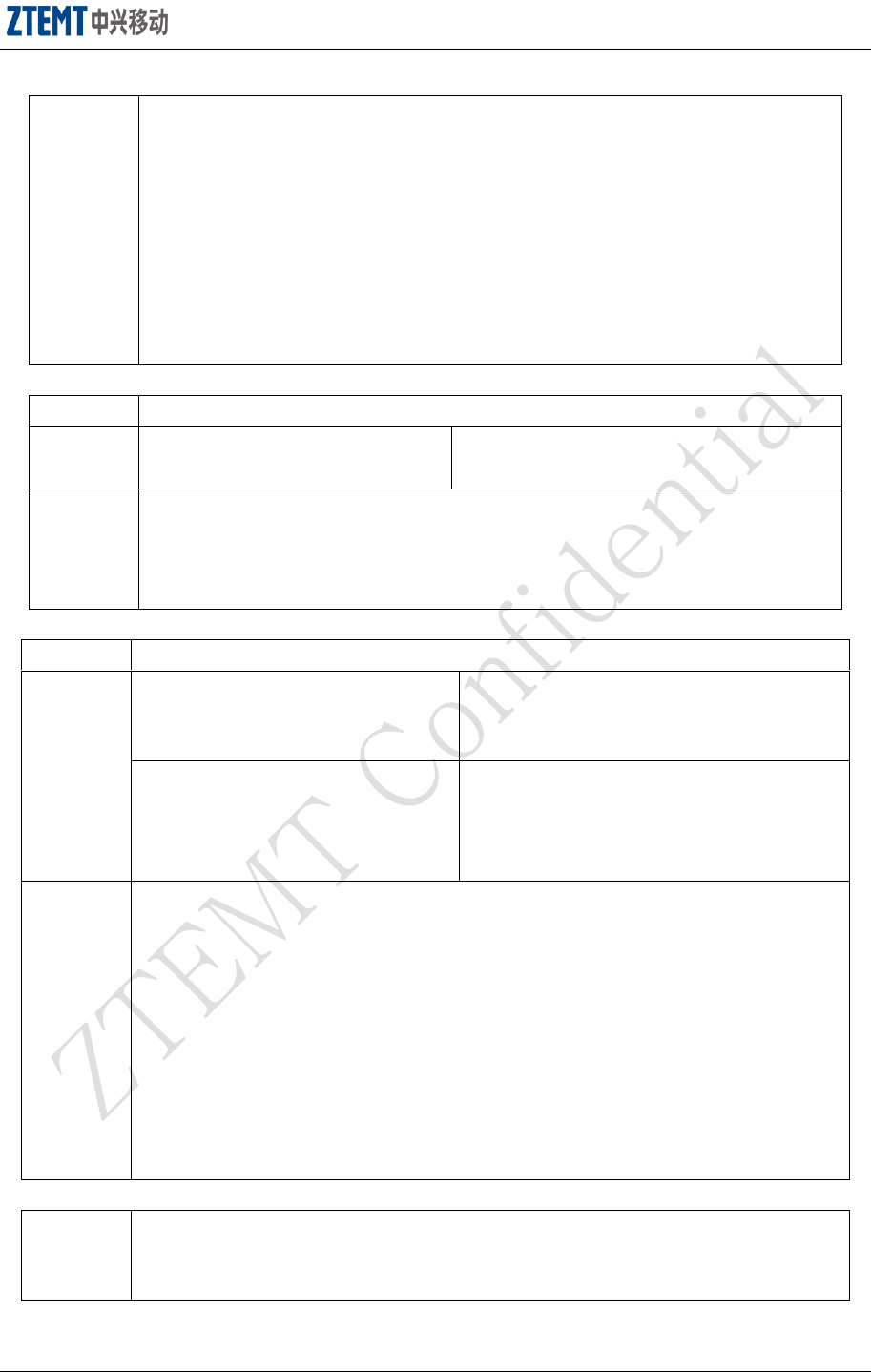
AT Command User Manual V1.1 Open▲
Page 12 of 52
parameter
<mem>
type of memory, currently support "ME" only, other memory optional.
"BM": broadcast message memory.
"ME": ME message memory
"MT": memory relating to ME
"TA": TA message memory
"SR": status report memory
<index>
value of integral type, the location in memory
1.2.5 +CDSI: New Message Status Report
description
Indicates new message status report is received and show the storage location.
format
<CR><LF>+CDSI: <mem>,<index>
<CR><LF>
parameter
<mem>: message memory
"ME":ROM message memory
<index>
value of integral type, location in memory
1.2.6 +CMGD: Delete Messages
description
Execution command is used to delete the messages at <index> in <mem1>
format
AT+CMGD=<index>[,<delflag>]
<CR><LF>OK<CR><LF>
otherwise:
+CMS ERROR: <err>
AT+CMGD=?
<CR><LF>+CMGD:
(list of supported <index>s)[,(list of
supported <delflag>s)]
<CR><LF><CR><LF>OK<CR><LF>
parameter
<index>: the messages storage location.
<delflag>
0: (or default) delete the messages designated by <index>.
1: delete all read messages in first prior memory, save unread messages, sent messages
and unsent messages
2: delete all read and sent messages in first prior memory, save unread messages and
unsent messages
3: delete all read, sent and unsent messages in first prior memory, save unread
messages
4: delete all messages including unread messages in first prior memory
1.2.7 +CNMA: Acknowledge New Messages
description
Execution command is used to acknowledge the receipt of new message directly sent
to TE. For the use of this command, please refer to the descriptions of +CNMI
command
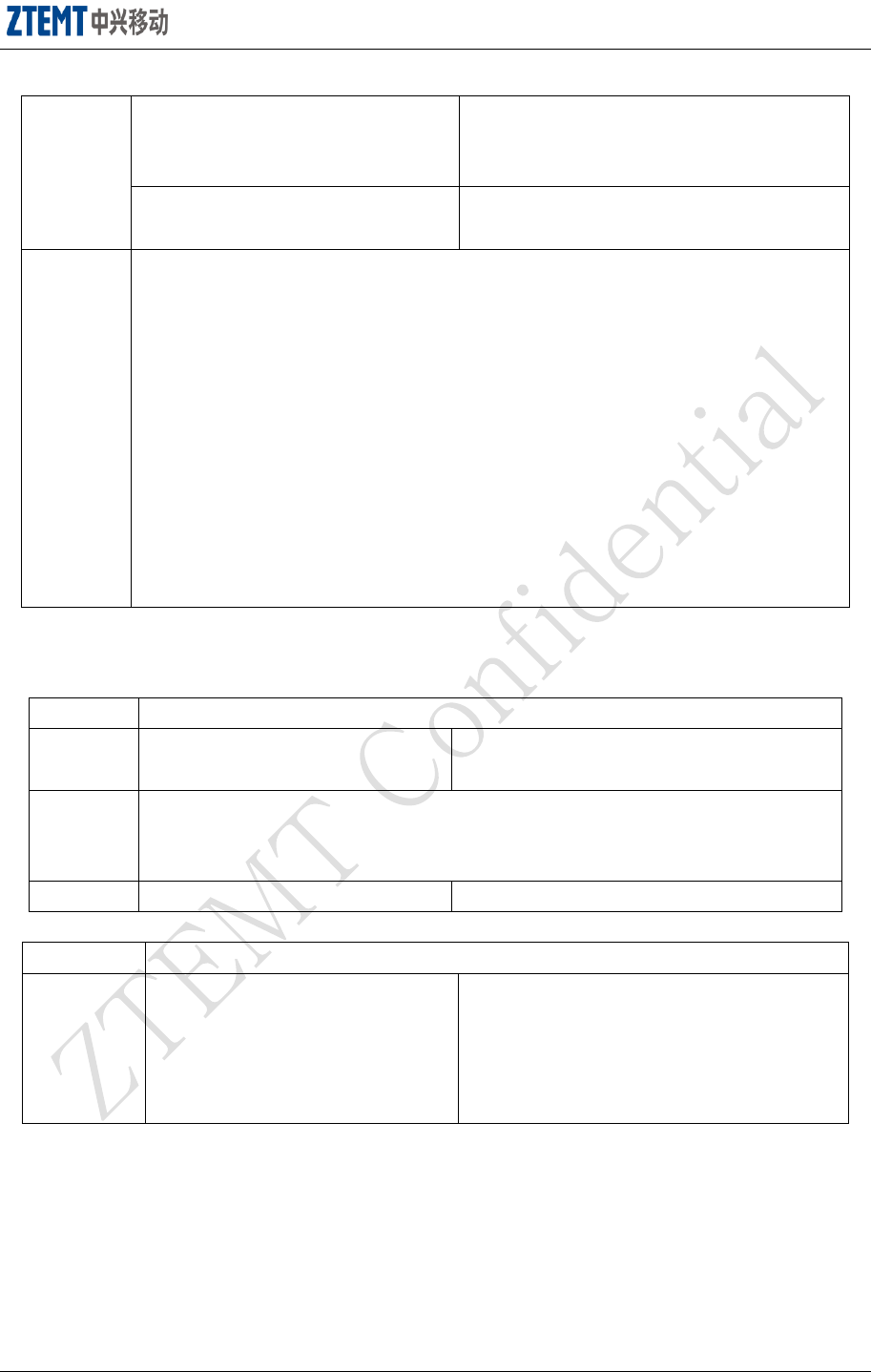
AT Command User Manual V1.1 Open▲
Page 13 of 52
format
AT+CNMA
<CR><LF>OK<CR><LF>
if there is any error regarding message:
<CR><LF>+CMS ERROR:<err><CR><LF>
AT+CNMA=?
<CR><LF>OK<CR><LF>
note
Before the acknowledge of previous message, MT would not sent TE another +CMT
or +CDS result code.
If MT doesn‟t obtain the acknowledge in specified period of time (network timeout),
MT would send RP-ERROR to network and automatically set the parameter <mt> and
<ds> of +CNMI command as 0. It would forbid sending message notice to TE. If it
requires MT to report the message notice again, you need set <mt> & <ds> again
If the command is executed, but the message is not acknowledged, return with +CMS
ERROR: <err>
Test command is used to <n> value supported by the command. If it supports 0 only, it
means the command doesn‟t support send by TPDU
Mandatory when <service> value 1 of command Select Message Service +CSMS is
supported
1.3 Proprietary Interface: SMS Interface
1.3.1 +ZSMMEMFULL: SMS Storage memory full
description
When SMS storage memory is full, it will report the message
format
<CR><LF>+ZSMMEMFULL:<mem_type>
<CR><LF>
parameter
<mem_type>
value of character string, indicating the type of full storage memory
“ME”: indicating NV
example
+ZSMMEMFULL: “ME”
1.3.2 +ZCMT: Don’t save newly received messages, and report to TE directly
description
Don‟t save newly received messages, and report to TE directly
format
<CR><LF>+ZCMT: <call ID>,
<year>, <month>, <day>, <hour>, <minute>,
<second>,<lang>, <format>, <length>, <prt>,
<prv>,<type>,<tag><CR><LF><msg>
<CTRL+Z><CR><LF>
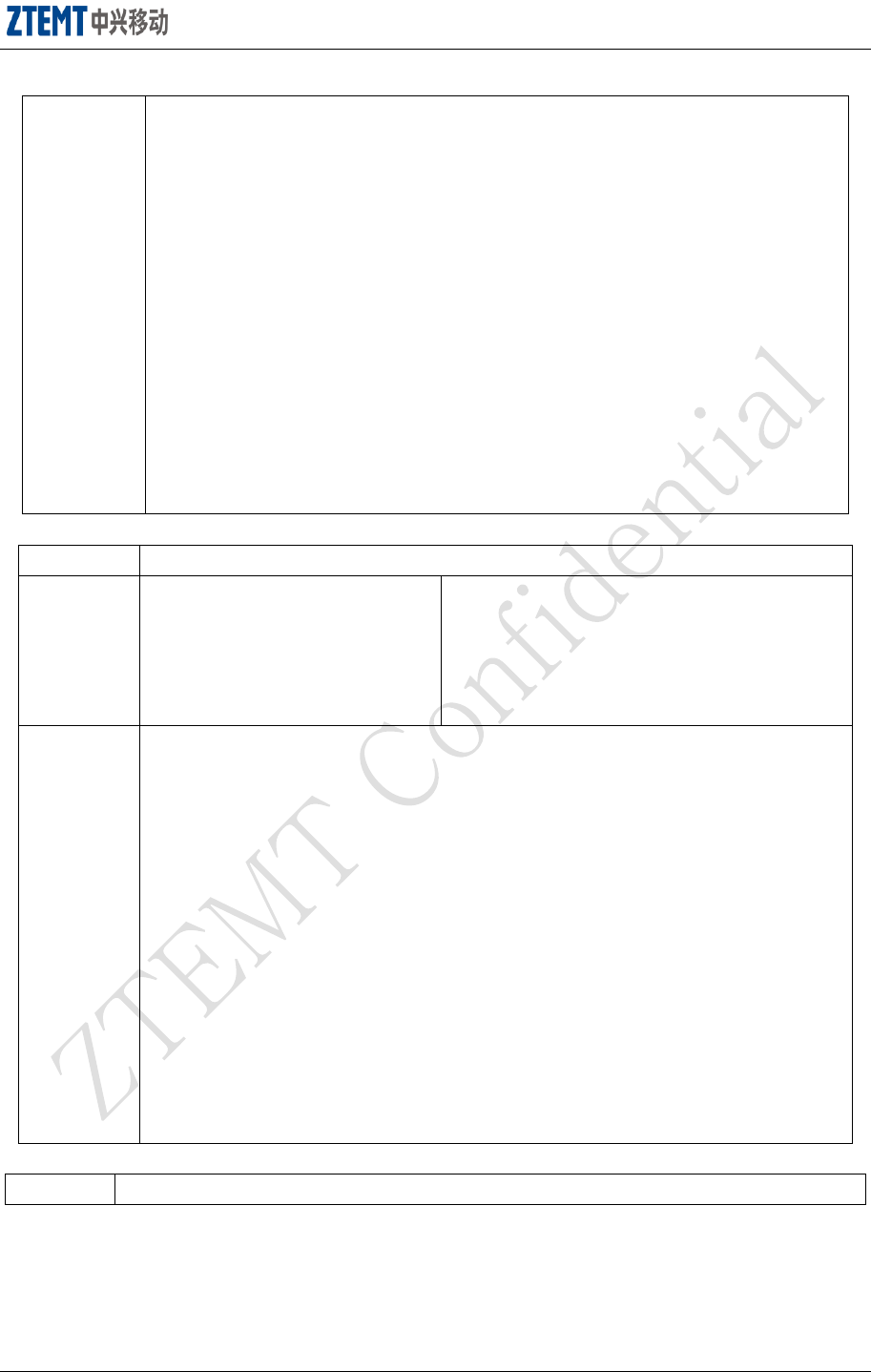
AT Command User Manual V1.1 Open▲
Page 14 of 52
parameter
<callerID>: number of message sender
<year, month, day, hour, minute, second>: year, month, day, hour, minute, second
when received SMS
<lang>: language, refer to +ZCMGW to take the value
<format>: indicating the coding format of the message, refer to +ZCMGW to take
the value
<Length>: the length of received message. <prt>: message priority level, refer to
+ZCMGW to take the value
<Prv>: Privacy level, refer to +ZCMGR to take the value
<type>: type of message, refer to +ZCMGR to take the value
<tag>: value of integral number, SMS status, refer to +ZCMGR to take the value
<Msg>: received SMS. Control characters
<ctrl-Z>: indicating the ending of one message, character:'0x1A'(Unicode: '0x001A')
<ESC>: cancel the sending of the message,character: '0x1B'(Unicode: '0x001B')
1.3.3 +ZCDS: New SMS Status Direct Report
description
Don‟t save newly received messages, and directly report to TE
format
<CR><LF>+ZCDS:
<callerID>,<year>,<month>,
<day>,<hour>,<minute>,<second>
<lang>,<format>,<length>,<prt>,<prv>,<type>,
<tag><CR><LF><msg><CTRL+Z><CR><LF>
parameter
<callerID>: number of message sender
<year, month, day, hour, minute, second>
year, month, day, hour, minute, second when received SMS
<lang>: language, refer to +ZCMGW to take the value:
<format>
indicating the coding format of the message, refer to +ZCMGW to take the value
<Length>: the length of received message
<prt>: message priority level, refer to +ZCMGW to take the value
<Prv>: Privacy level, refer to +ZCMGR to take the value
<type>: type of message, refer to +ZCMGR to take the value
<tag>: value of integral number, SMS status, refer to +ZCMGR to take the value
<Msg>: received SMS. Control characters
<ctrl-Z>: indicating the ending of one message, character: '0x1A'(Unicode: '0x001A')
<ESC>: cancel the sending of the message,character: '0x1B'(Unicode: '0x001B')
1.3.4 +ZCMGS: Send Message
description
Send a message to network side. It takes two steps to save a message
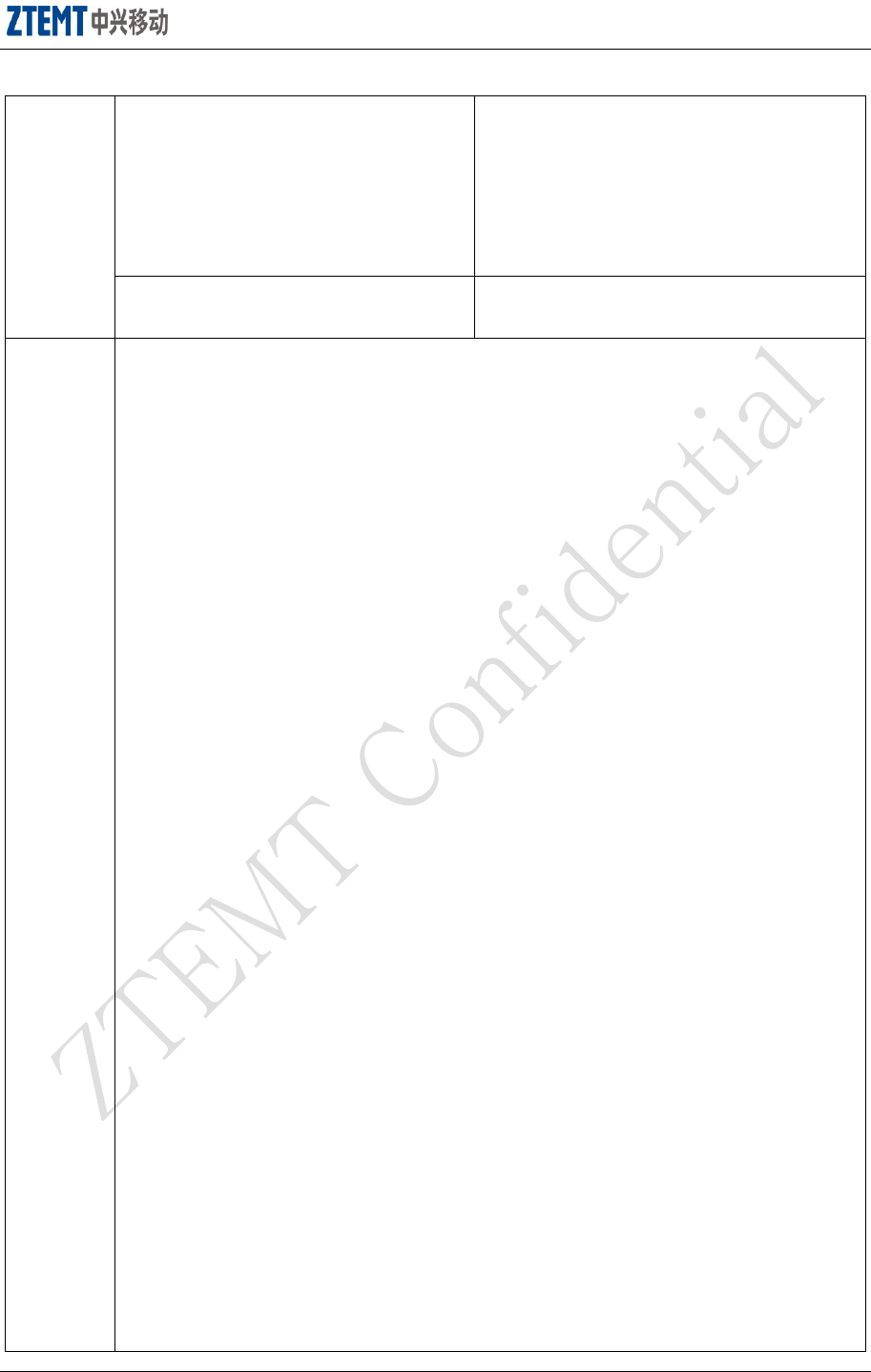
AT Command User Manual V1.1 Open▲
Page 15 of 52
format
AT+ZCMGS="<da>",<language>,
<encode>,<ack>,<priority>,<tele id>,
<length>,"<cbn>",<total_num>,
<seq_num>,<msg_ref>,<display_mode>,
<validity_period><CR><data>
<ctrl-Z/ESC>
<CR><LF>+ZCMGS:
<mr><CR><LF><CR><LF>OK<CR><LF>
otherwise:
+CMS ERROR: <err>
AT+ZCMGS=?
<CR><LF>OK<CR><LF>
parameter
TEXT mode:
When GSM 7 BIT or UNICODE is used, the value of text character is shown. For
example: the UCS2 value for the character “会” is 4E1A, then, the text should be
„0x4E1A„ rather than “4E1A”
<da>: number of message recipient. Take the value from 0~9,*, #, up to 20 digits.
< language >
language, take the value as below:
0: UNSPECIFIED
1: ENGLISH
2: FRENCH
3: SPANISH
4: JAPANESE
5: KOREAN
6: CHINESE
7: HEBREW
<encode>: indicating the coding method of the message, take the value as below:
0: GSM 7 BIT
1: ASCII code (coding range<=7F). Send the original characters in ASCII coding, for
example, the ASCII code for the letter A is 0x41, then the character to be transmitted is
“A”
2: IA5 (optional)
3: OCTET (optional)
4: LATIN (optional)
5: LATIN_HEBREW (optional)
6: UNICODE (coding range>7F). Send the original value in UNICODE coding. For
example, the UNICODE for the Chinese character “一” is 0x4E00, then the character to
be transmitted is „0x4E00„
7: Other coding method
<ack>
0: no ack
1: need ack
<ptriority>
value of integral type, indicating the priority level of the message, take the value as below:
0: Normal
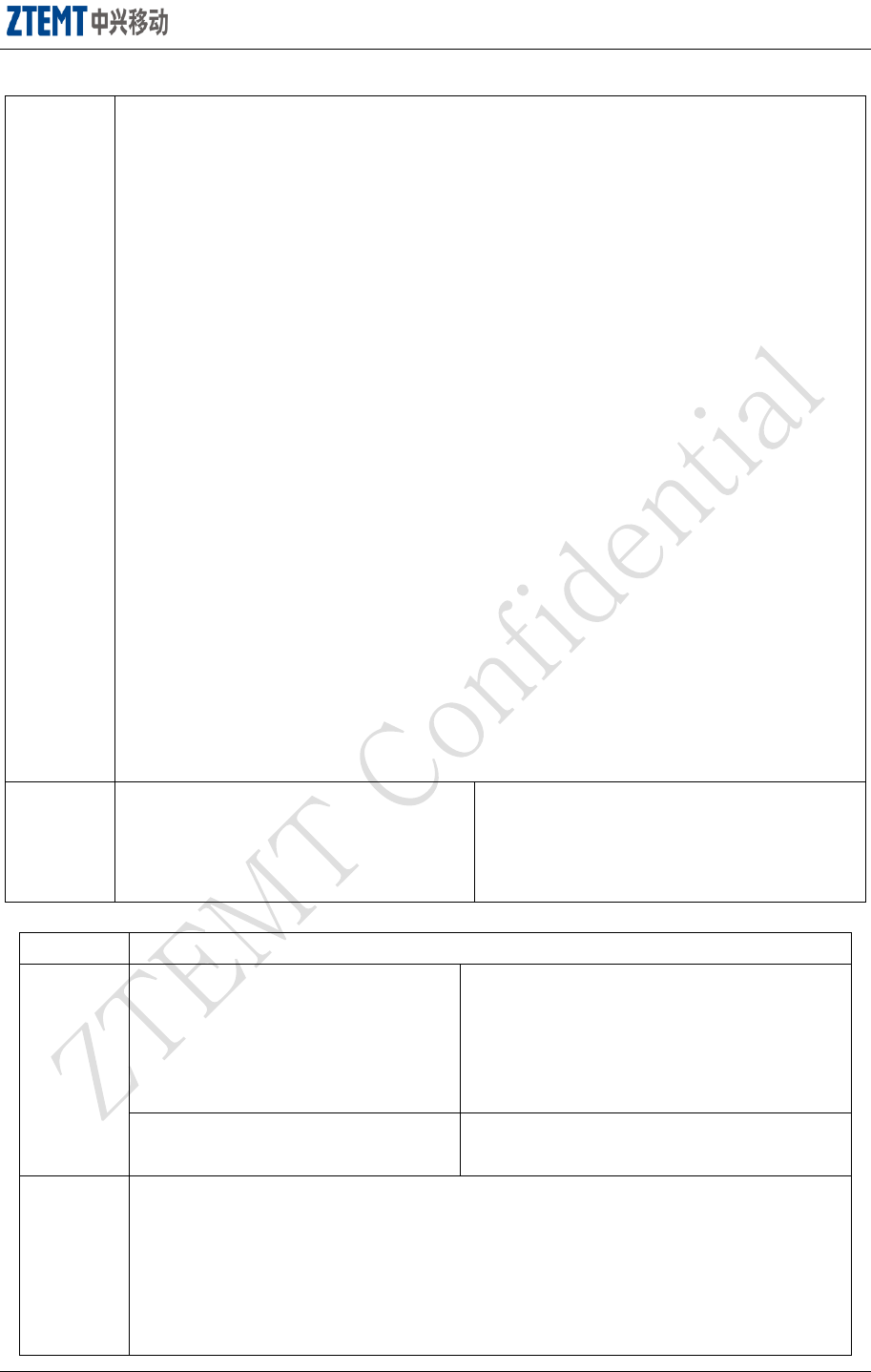
AT Command User Manual V1.1 Open▲
Page 16 of 52
1: Interactive
2: Urgent
3: Emergency
<tele id>
4097:Paging
4098:Short Message, Push Mail
4099:Voice Mail
4100:Java Mail
<length>: the message data length
<cbn>call back number
<total_num>:the split total num of long message
<seq_num>:sequence number of long message
<msg_ref>:long message reference number number
<display_mode>: display directly or not
0: display directly
1,2,3: not display directly
<validity_period>:message validity date
<data>: message date
<mr>: message symbol
<ctrl-Z>: indicating the ending of one message. Under non-UNICOD:'0x1A'; under
UNICOD:'0x001A'
<ESC>: Cancel the sending of the message. Under non-UNICOD: '0x1B', under
UNICOD:'0x001B'
example
AT+ZCMGS=13554890280,1,1,1,0,4098,
,,,,,,<CR>414243<ctrl-Z>
+ZCMGS:4
OK
1.3.5 +ZCMGW: Write Message to Memory
description
Save message into <mem2> through +CPMS command, and you could save it into ME
format
AT+ZCMGW=<oa/da>[,<tooa/toda>],
<stat>,<ptr>,<type>,<format>,
<lang>[,<year>,<month>,<day>,
<hour>,<minute>,<second>]
<CR><text><ctrl-Z/ESC>
+ZCMGW: <index>
otherwise:
+CMS ERROR: <err>
AT+ZCMGW=?
<CR><LF>OK<CR><LF>
parameter
<oa/da>
number of message sender/recipient. Take the value from 0~9,*, #, up to 20 digits
< tooa/toda>
address coding method. The number of one byte, this parameters works as the address
coding is 8bit. Now 4bit coding is used, therefore this parameter doesn‟t work. The
value is fixed to be 0
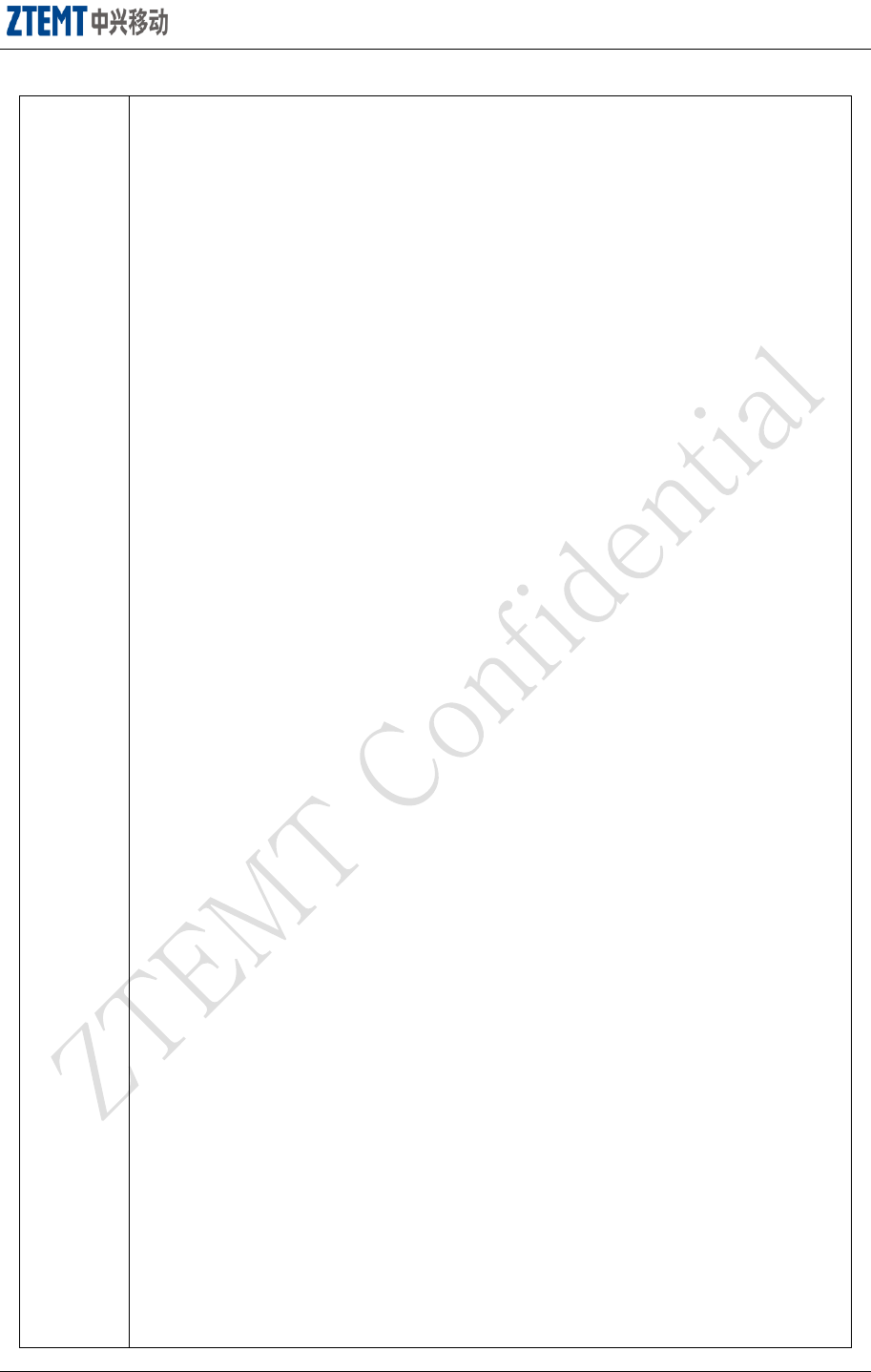
AT Command User Manual V1.1 Open▲
Page 17 of 52
The higher four digits is number type:
0: UNKNOWN
1: INTERNATIONAL
The lower four digits is number plan:
0: UNKNOWN
1: TELEPHONY
<stat>
value of integral type, indicating the storage status of SMS, take the value as below:
0: received unread messages
1: received read messages
2: saved unsent messages
3: saved sent messages
4: all messages (the value is only applicable for +CMGL command)
<lang>
language take the value as below:
0: UNSPECIFIED
1: ENGLISH
2: FRENCH
3: SPANISH
4: JAPANESE
5: KOREAN
6: CHINESE
7: HEBREW
<ptr>
value of integral type, indicating the priority level of the message, take the value as
below:
0: Normal
1: Interactive
2: Urgent
3: Emergency
<year>,<month>,<day>,<hour>,<minute>,<second>: year, month, day, hour, minute,
second when received SMS.
<index>: the location number in memory, take a decimal from 0~9, and the value
ranges from 0 to the max. capacity of the memory.
<format>: indicating the coding method of the message, take the value as below:
0: GSM 7 BIT
1: ASCII code (coding range<=7F). Send the original characters in ASCII coding, for
example, the ASCII code for the letter A is 0x41, then the character to be transmitted is
“A”
2: IA5 (optional)
3: OCTET (optional)
4: LATIN (optional)
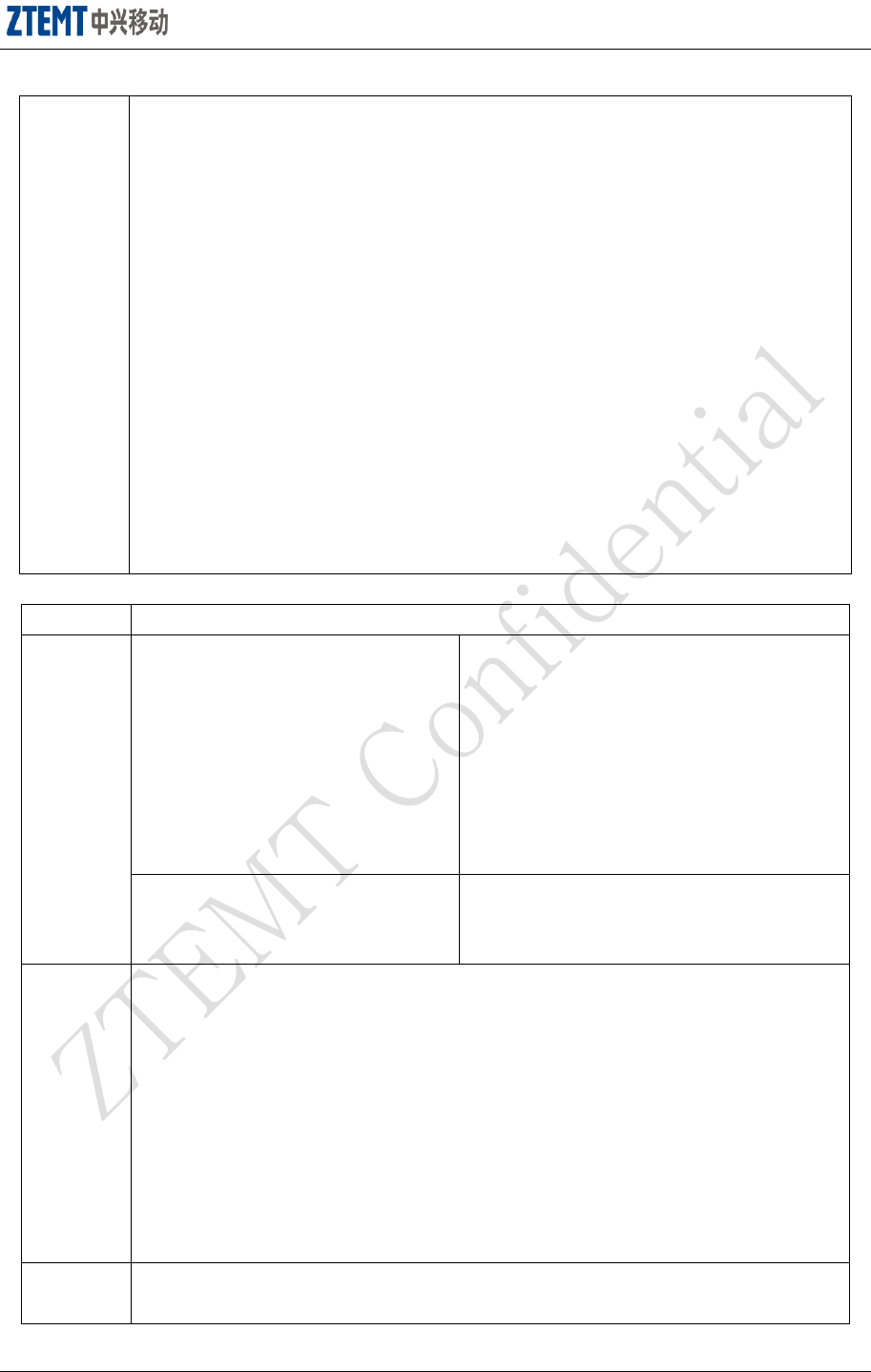
AT Command User Manual V1.1 Open▲
Page 18 of 52
5: LATIN_HEBREW (optional)
6: UNICODE (coding range>7F). Send the original value in UNICODE coding. For
example, the UNICODE for the Chinese character “-” is 0x4E00, then the character
to be transmitted is „0x4E00„
7: Other coding method
<type>: type of message
0: Normal
1: CPT (Optional)
2: Voice Mail
3: SMS Report
<text>: message text
<CR>: command ending mark, indicating the ending of one command.
<ctrl-Z>: indicating the ending of one message. Under non-UNICOD:'0x1A', and
under UNICOD:'0x001A'
<ESC>: Cancel the sending of the message. Under non-UNICOD:'0x1B', and under
UNICOD:'0x001B'
1.3.6 +ZCMGL: List Messages
description
Return all SMS index designated by <stat> from <mem1>
format
AT+ZCMGL=<stat>
Under text mode, the command is
successfully executed:
<CR><LF>+ZCMGL: <index1>,
<tag1><CR><LF> <CR><LF>+ZCMGL:
<index2>, <tag2><CR><LF> ……
<CR><LF>OK<CR><LF>
otherwise:
+CMS ERROR: <err>
AT+ZCMGL=?
<CR><LF>+ZCMGL: (list of supported
<stat>s) <CR><LF><CR><LF>OK
<CR><LF>
parameter
<stat>
type of message, the default value is 0:
0: received unread message
1: received read message
2: saved unsent message
3: saved messages in Sent Messages
4: all sms
<index>: value of integral type, location in memory
<tag>: value of integral number, SMS status, please refer to +ZCMGR to take the
value
note
The SMS status report will be processed as a common received message.
TEST command is used to return all stat values
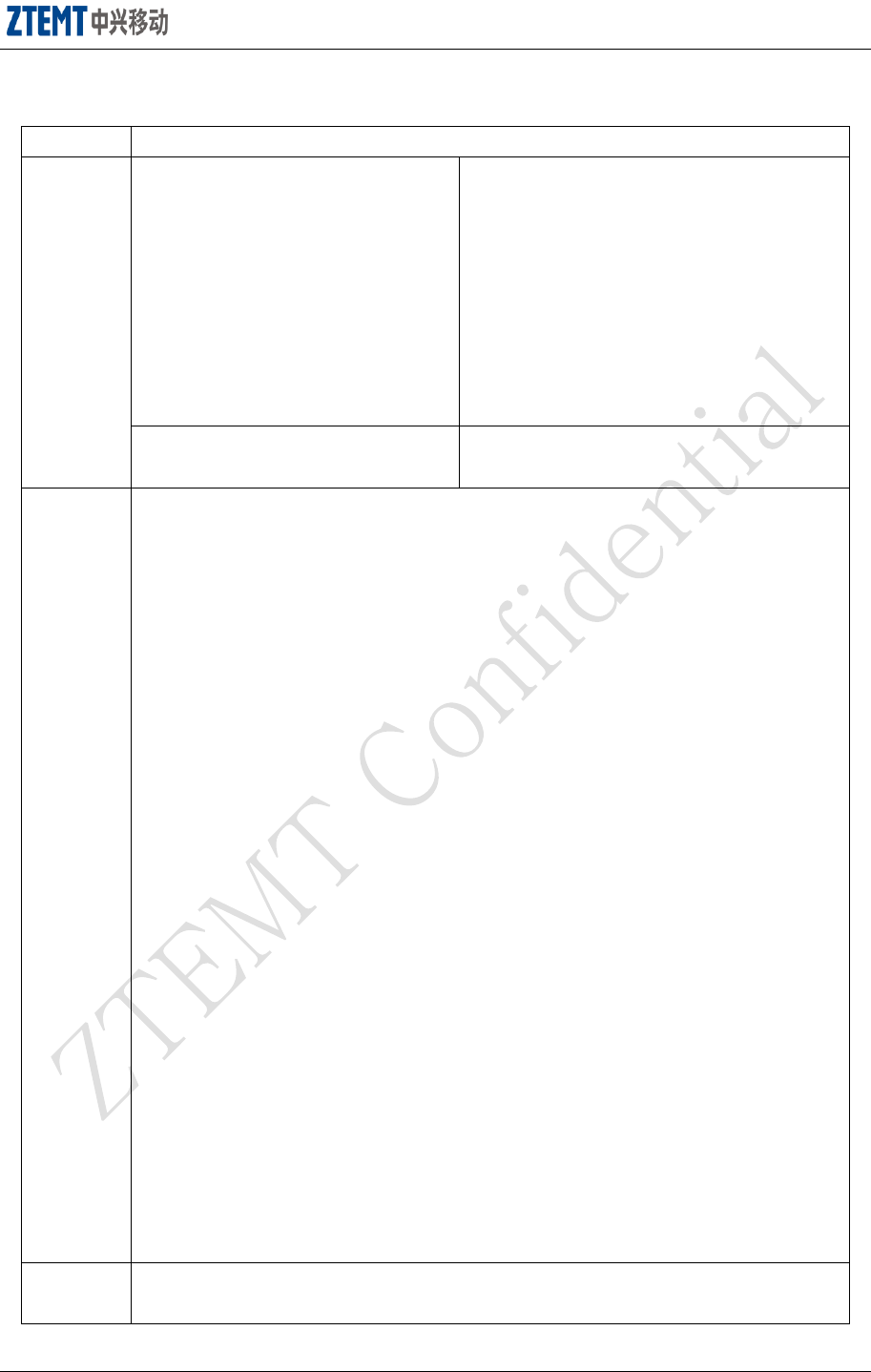
AT Command User Manual V1.1 Open▲
Page 19 of 52
1.3.7 +ZCMGR: Read Message
description
EXECUTION command is used to return the message saved at index from <mem1>
format
AT+ZCMGR=<index>[,<mode>]
Under text mode, the command is
successfully executed: <CR><LF>+ZCMGR:
<callerID>, <year>, <month>, <day>,
<hour>, <minute>, <second>, <lang>,
<format>, <length>, <prt>, <prv>,<type>,
<stat><CR><LF><msg><CTRL+Z>
<CR><LF>OK<CR><LF>
otherwise:
+CMS ERROR: <err>
AT+ZCMGR=?
<CR><LF>OK<CR><LF>
parameter
<index>: value of integral type, location in memory
<mode>: SMS status modifying mode:
0: change to READ status
1: Do not change the status
<callerID>: number of message sender
<format>: indicating the coding format of the message, refer to +ZCMGW to take the
value;
<year, month, day, hour, minute,second>: year, month, day, hour, minute, second when
received SMS.
<Length>: the length of received message.
<lang>: language, refer to +ZCMGW to take the value:
<prt>: message priority level, refer to +ZCMGW to take the value:
<Prv>: Privacy level
0: Normal
1: Restricted
2: Confidential
3: Secret
<type>: type of message
0: Normal
1: CPT
2: Voice Mail
3: SMS Report
<stat>: type of message, refer to +ZCMGW to take the value:
<Msg>: received messages
<ctrl-Z>: indicating the ending of one message. Under non-UNICOD: '0x1A'; under
UNICOD:'0x001A'
note
The SMS status will be revised by single board or back end according to the value of
<mode>.
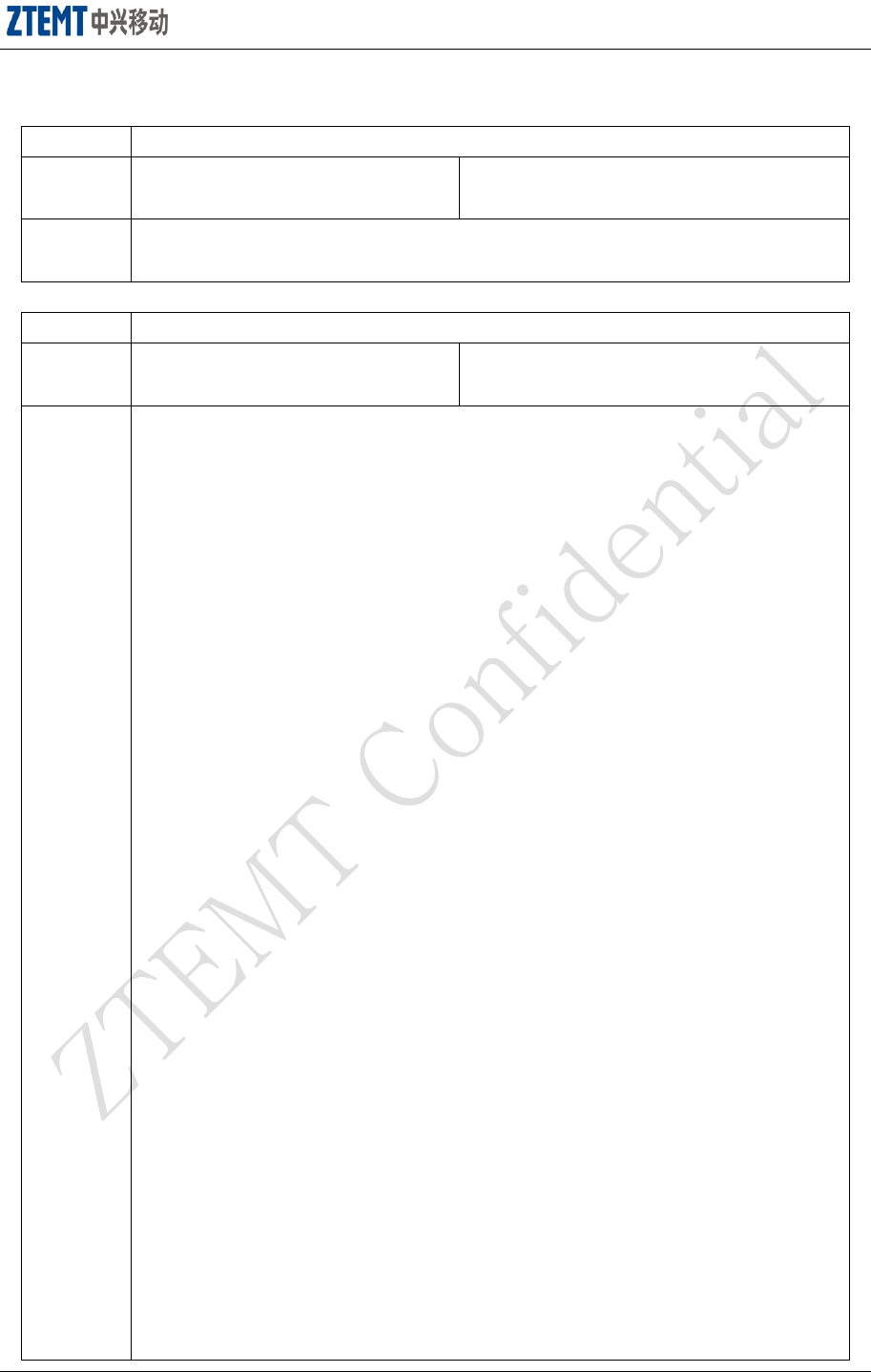
AT Command User Manual V1.1 Open▲
Page 20 of 52
1.3.8 +ZCMGSS: Message Sent Report
description
If the message is sent successfully, report to TE through this command.
format
<CR><LF>+ZCMGSS: <mr><CR><LF>
parameter
<mr>
the message‟s mark, take a decimal from 0~9, and the value ranges from 0~65535.
1.3.9 +ZCMGSF: Message Unsent Report
description
If the message is unsent, report to TE through this command
format
<CR><LF>+ZCMGSF:<err code>
<CR><LF>
parameter
<err code>
take the value of the error code as below as the message is unsent:
0 WMS_ADDRESS_VACANT_S
1 WMS_ADDRESS_TRANSLATION_FAILURE_S
2 WMS_NETWORK_RESOURCE_SHORTAGE_S
3 WMS_NETWORK_FAILURE_S
4 WMS_INVALID_TELESERVICE_ID_S
5 WMS_OTHER_NETWORK_PROBLEM_S
6 WMS_OTHER_NETWORK_PROBLEM_MORE_FIRST_S
31 WMS_OTHER_NETWORK_PROBLEM_MORE_LAST_S
32 WMS_NO_PAGE_RESPONSE_S
33 WMS_DESTINATION_BUSY_S
34 WMS_NO_ACK_S
35 WMS_DESTINATION_RESOURCE_SHORTAGE_S
36 WMS_SMS_DELIVERY_POSTPONED_S
37 WMS_DESTINATION_OUT_OF_SERVICE_S
38 WMS_DESTINATION_NO_LONGER_AT_THIS_ADDRESS_S
39 WMS_OTHER_TERMINAL_PROBLEM_S
40 WMS_OTHER_TERMINAL_PROBLEM_MORE_FIRST_S
47 WMS_OTHER_TERMINAL_PROBLEM_MORE_LAST_S
48 WMS_SMS_DELIVERY_POSTPONED_MORE_FIRST_S
49 WMS_SMS_DELIVERY_POSTPONED_MORE_LAST_S
64 WMS_RADIO_IF_RESOURCE_SHORTAGE_S
65 WMS_RADIO_IF_INCOMPATIBLE_S
66 WMS_OTHER_RADIO_IF_PROBLEM_S
67 WMS_OTHER_RADIO_IF_PROBLEM_MORE_FIRST_S
95 WMS_OTHER_RADIO_IF_PROBLEM_MORE_LAST_S
96 WMS_UNEXPECTED_PARM_SIZE_S
97 WMS_SMS_ORIGINATION_DENIED_S
98 WMS_SMS_TERMINATION_DENIED_S
99 WMS_SUPPL_SERVICE_NOT_SUPPORTED
100 WMS_SMS_NOT_SUPPORTED_S
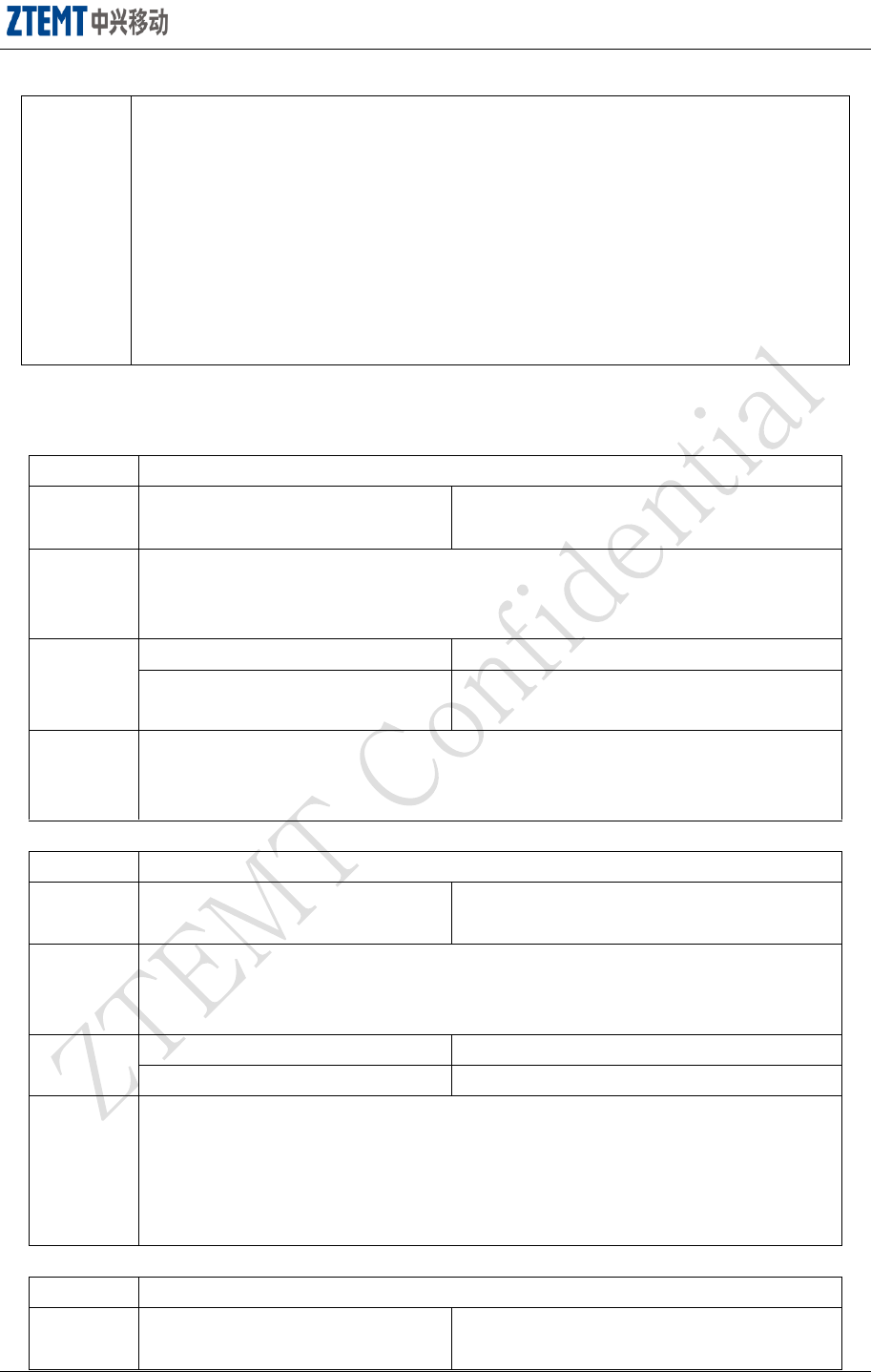
AT Command User Manual V1.1 Open▲
Page 21 of 52
101 WMS_RESERVED_101_S
102 WMS_MISSING_EXPECTED_PARM_S
103 WMS_MISSING_MANDATORY_PARM_S
104 WMS_UNRECOGNIZED_PARM_VALUE_S
105 WMS_UNEXPECTED_PARM_VALUE_S
106 WMS_USER_DATA_SIZE_ERROR_S
107 WMS_OTHER_GENERAL_PROBLEMS_S
108 WMS_OTHER_GENERAL_PROBLEMS_MORE_FIRST_S
109 WMS_OTHER_GENERAL_PROBLEMS_MORE_LAST_S
2 Basic AT Commands
2.1.1 E: Turn off/on echo commands
description
Turn off/on echo commands
format
ATE<value>
<CR><LF>OK<CR><LF>
parameter
<value>
0: turn off echo
1: turn on echo
example
ATE0
OK
ATE1
ATE1
OK
note
CE MUST support the parameter E0 which will turn off echo commands
CE MUST support the parameter E1 which will turn on echo commands
CE MUST set the E parameter to E1 as default
2.1.2 Q: Enable/Disable return result codes
description
Enable /Disable return result codes
format
ATQ<value>
<CR><LF>OK<CR><LF>
parameter
<value>
0: enable
1: disable
example
ATQ0
OK
ATQ1
OK
note
CE MUST support the parameter Q0 which will cause the device to return result
codes
CE MUST support the parameter Q1 which will cause the device to NOT return
result codes
CE MUST set the Q parameter to Q0 as default
2.1.3 V: Return result codes as numbers/words
description
Return result codes as numbers/words
format
ATV<value>
<CR><LF>OK<CR><LF>
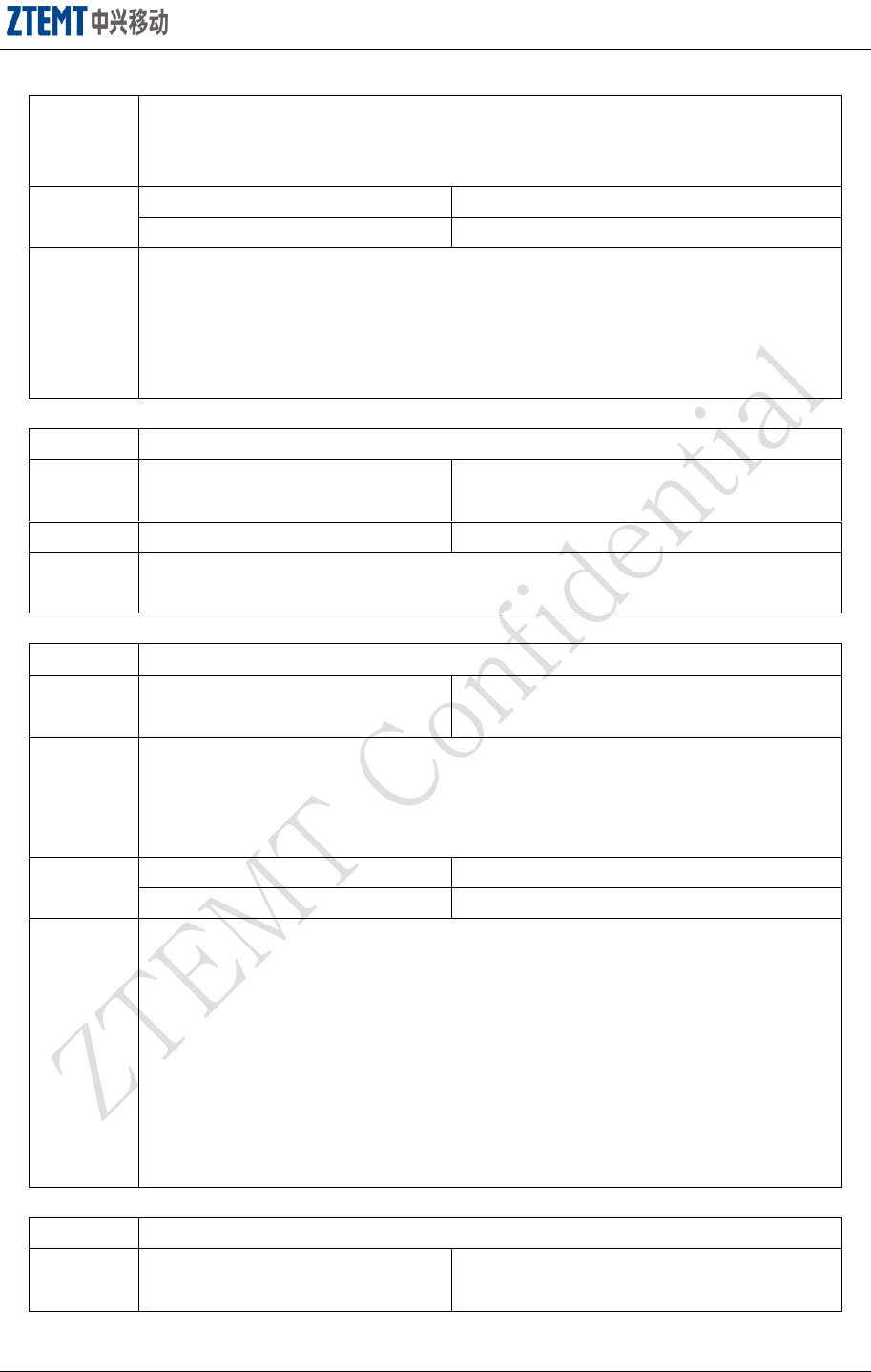
AT Command User Manual V1.1 Open▲
Page 22 of 52
parameter
<value>
0: result codes as numbers
1: result codes as words
example
ATV0
0
ATV1
OK
note
CE MUST support the parameter V0 which will cause the device to return result
codes as numbers
CE MUST support the parameter V1 which will cause the device to return result
codes as words
CE MUST set the V parameter to V1 as default
2.1.4 Z0: Reset the parameters to the default configuration
description
Reset the parameters to the default configuration
format
ATZ0
<CR><LF>OK<CR><LF>
example
ATZ0
OK
note
CE MUST support the parameter Z0 which will cause the device to reset the
parameters to the default configuration
2.1.5 &C: Set circuit 109 (CF) or Received Line Signal Detector (RLSD)
description
Set circuit 109 (CF) or Received Line Signal Detector (RLSD)
format
AT&C<value>
<CR><LF>OK<CR><LF>
parameter
<value>
0: set circuit 109 (CF) or Received Line Signal Detector (RLSD) always on
1: set circuit 109 (CF) or Received Line Signal Detector (RLSD) on in accordance
with the specified service
example
AT&C0
OK
AT&C1
OK
note
CE MUST support the parameter &C0 (Data Carrier Detect) which will set circuit
109 (CF) or Received Line Signal Detector (RLSD) always on
Note: Circuit 109 is generally used for serial communications. Most Sprint devices
use the USB interface and this is not required for general use of the device. It may be
needed for specific applications or unusual use cases.
CE MUST support the parameter &C1 (Data Carrier Detect) which will set circuit
109 (CF) or Received Line Signal Detector (RLSD) on in accordance with the
specified service
CE MUST set the C parameter (Data Carrier Detect) to C1 as default
2.1.6 &D: Set DTR(Data Terminal Ready) Signal
description
Set DTR(Data Terminal Ready) Signal
format
AT&D<value>
<CR><LF>OK<CR><LF>
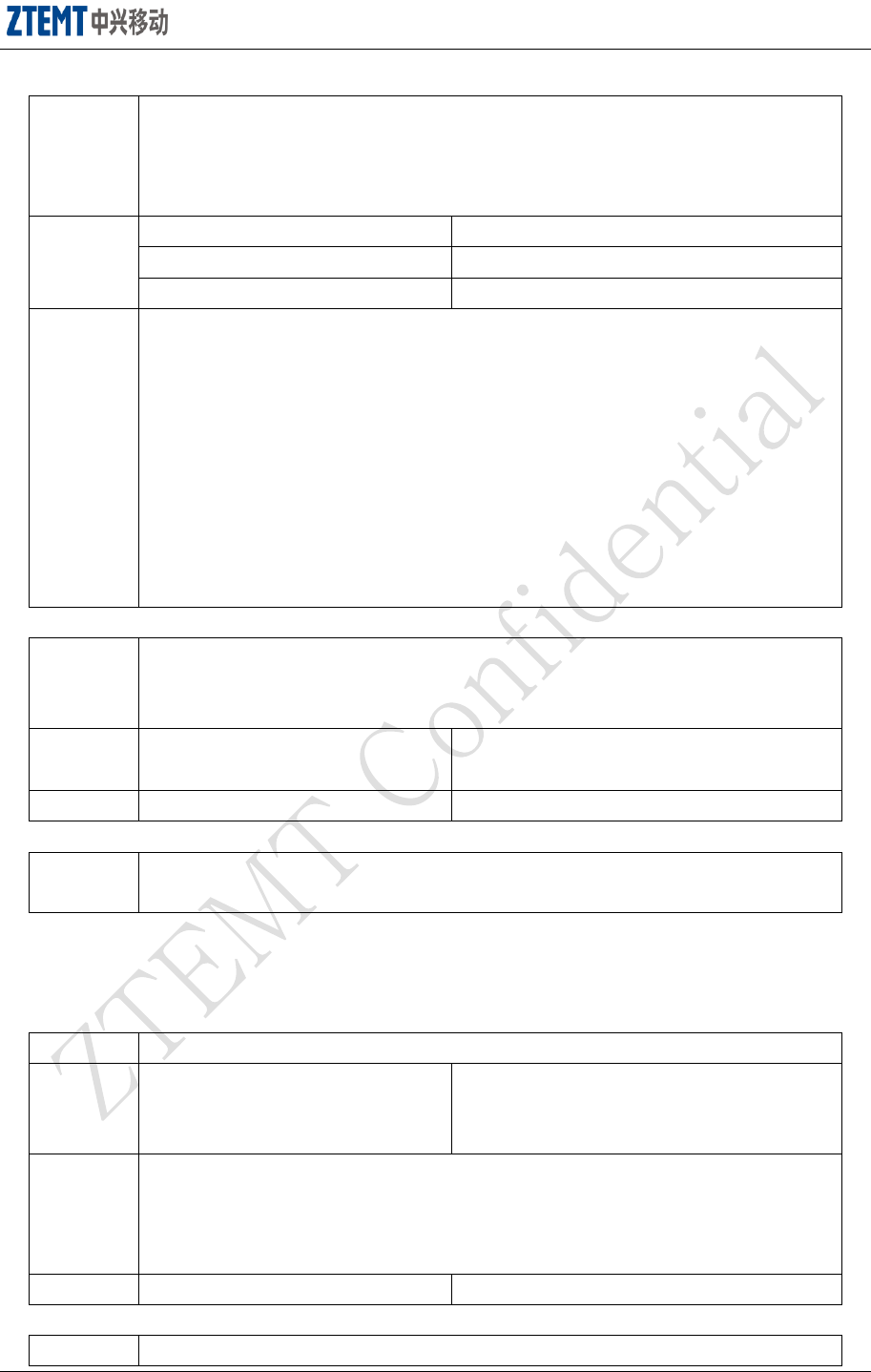
AT Command User Manual V1.1 Open▲
Page 23 of 52
parameter
<value>
0: ignore circuit 108/2
1: enter online command state following ON-to-OFF transition of circuit 108/2
2: enter command state following On to Off transition of circuit 108/2
example
AT&D0
OK
AT&D1
OK
AT&D2
OK
note
CE MUST support the parameter &D0 (Data Terminal Ready) which will ignore
circuit 108/2 (CD)
Note: Circuit 108 is generally used for serial communications. Most Sprint devices
use the USB interface and this is not required for general use of the device. It may be
needed for specific applications or unusual use cases
CE MUST support the parameter &D1 (Data Terminal Ready) which will enter
online command state following ON-to-OFF transition of circuit 108/2
CE MUST support the parameter &D2 (Data Terminal Ready) which will enter
command state following On to Off transition of circuit 108/2
CE MUST set the D parameter (Data Terminal Ready) to D0 as default
2.1.7 A: Answer
description
When there is an incoming call, TE informs MS to answer the call through this
command; if there is a second incoming call, this command can still be used to
answer the call
format
ATA
<CR><LF>OK<CR><LF>
example
ATA
OK
2.1.8 RING: Incoming Call
description
As the mobile terminal has an incoming call, MT will report the indication to TE
periodically (period: T=5s)
3 Extended AT Configuration Commands
3.1.1 +CDV: Dial
description
The interface is used for TE to originate a voice call to network side through MT
format
AT+CDV[digits]
<CR><LF>OK<CR><LF>
otherwise:
+CMS ERROR: <err>
parameter
<digits>
telephone number called, ASCII character, the legal characters only include: „0„- „9„,
„*„, „# ‟, „+„. „+„ can only appear in front of the number and the length of the number
cannot exceed 24 (not including „+‟)
example
AT+CDV13512345678
OK
3.1.2 +CHV: Hang up
description
The interface is used in CDMA system to hang up voice call
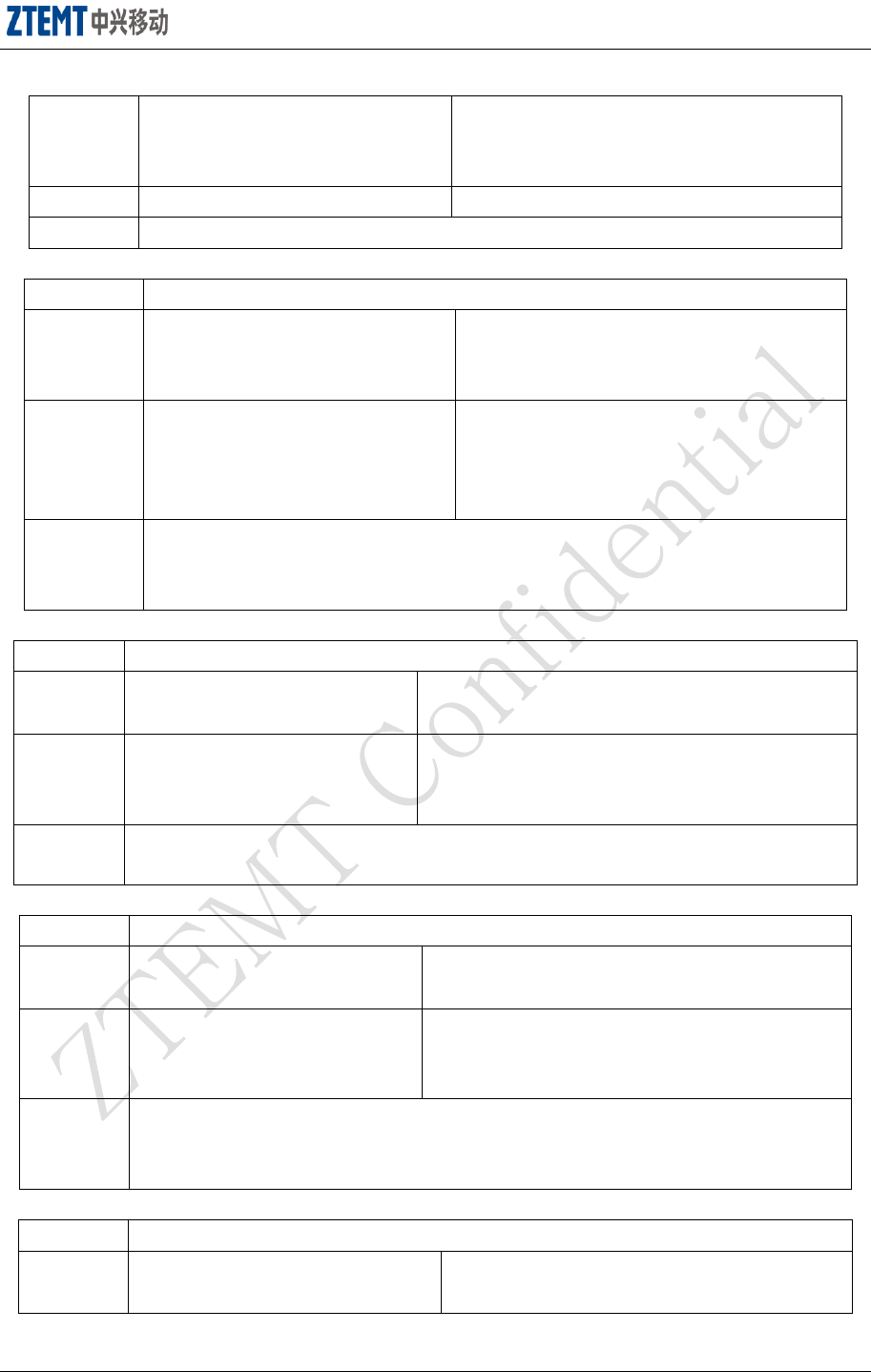
AT Command User Manual V1.1 Open▲
Page 24 of 52
format
AT+CHV
<CR><LF>OK<CR><LF>
otherwise:
+CMS ERROR: <err>
example
AT+CHV
OK
note
Only can be used in CDMA system
3.1.3 +GCAP: Return the list of all commands supported by the device
description
Return the list of all commands supported by the device
format
AT+GCAP
<CR><LF>+GCAP: +CIS707-A,CIS-856,
+MS, +ES, +DS, +FCLASS<CR><LF>
<CR><LF>OK<CR><LF>
example
AT+GCAP
+GCAP: +CIS707-A,+MS,+ES,+DS,
+FCLASS
OK
note
CE MUST support “AT+GCAP” which will return the list of all commands
supported by the device
CE MUST return “ERROR” for any other AT+GCAP string
3.1.4 +GMI: Return the manufacturer name on a single line
description
Return the manufacturer name on a single line
format
AT+GMI
<CR><LF>+GMI: ×××CO,.LTD
<CR><LF><CR><LF><CR><LF>OK<CR><LF>
example
AT+GMI
+GMI: ZTE CO,.LTD
OK
note
CE MUST support “AT+GMI” which will return the manufacturer name on a single line
CE MUST return “ERROR” for any other AT+GMI string
3.1.5 +GMM: Return the device model name and number
description
Return the device model name and number
format
AT+GMM
<CR><LF>+GMM: <name><CR><LF>
<CR><LF>OK<CR><LF>
example
AT+GMM
+GMM: MC2716
OK
note
CE MUST support “AT+GMM” which will return the device model name and number
as defined by the OEM and approved by Sprint on a single line
CE MUST return “ERROR” for any other AT+GMM string
3.1.6 +GMR: Return the current firmware version on a single line
description
Return the current firmware version on a single line
format
AT+GMR
<CR><LF>+GMR: <firmware version>
<CR><LF><CR><LF>OK<CR><LF>
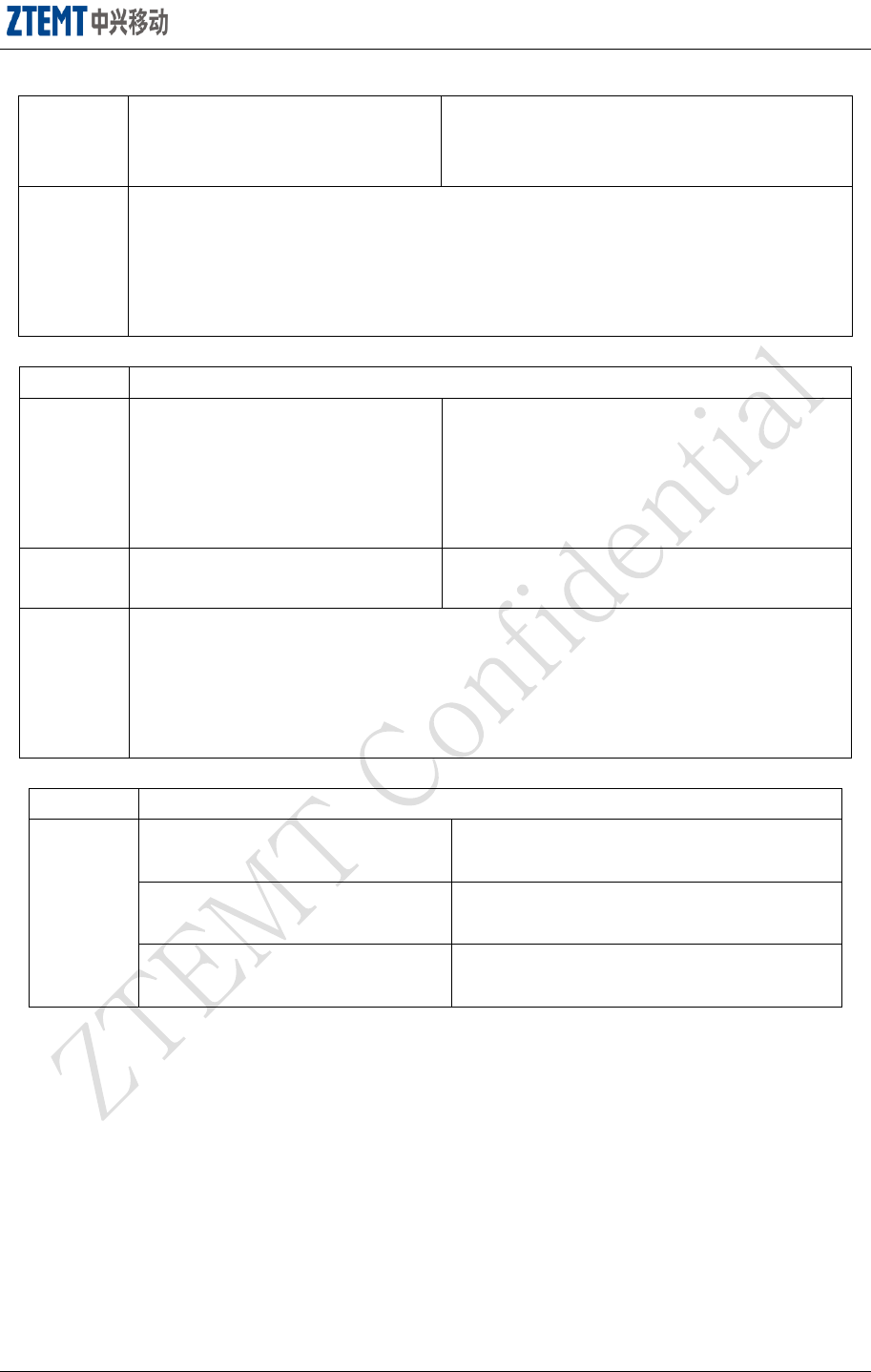
AT Command User Manual V1.1 Open▲
Page 25 of 52
example
AT+GMR
+GMR: <firmware version>
OK
note
CE MUST support “AT+GMR” which will return the current firmware version on a
single line
“AT+GMR” MUST return the firmware of each processor on a separate line in the
format of “<firmware version>”
CE MUST return “ERROR” for any other AT+GMR string
3.1.7 +GSN: Get the ESN of device
description
Return the “<ESN>” or the “<MEID>:<pseudo ESN>” of the device
format
AT+GSN
<CR><LF>+GSN: <ESN><CR><LF >
<CR><LF>OK<CR><LF>
or
<CR><LF> +GSN: <MEID>:<pseudo ESN>
<CR><LF><CR><LF>OK<CR><LF>
example
AT+GSN
+GSN: 0x11111111
OK
note
CE MUST support “AT+GSN” which will return the “<ESN>” or the
“<MEID>:<pseudo ESN>” of the device
CE MUST return the decimal value on the first line and the hexadecimal value on the
second line for “AT+GSN”
CE MUST return “ERROR” for any other AT+GSN string
3.1.8 +ICF: Set the character framing
description
Set the character framing between the device and a connected terminal
format
AT+ICF=<format>,<parity>
<CR><LF>OK<CR><LF>
AT+ICF?
<CR><LF>+ICF: <format>,<parity><CR>
<LF><CR><LF>OK<CR><LF>
AT+ICF=?
<CR><LF>+ICF: (),()
<CR><LF><CR><LF>OK<CR><LF>
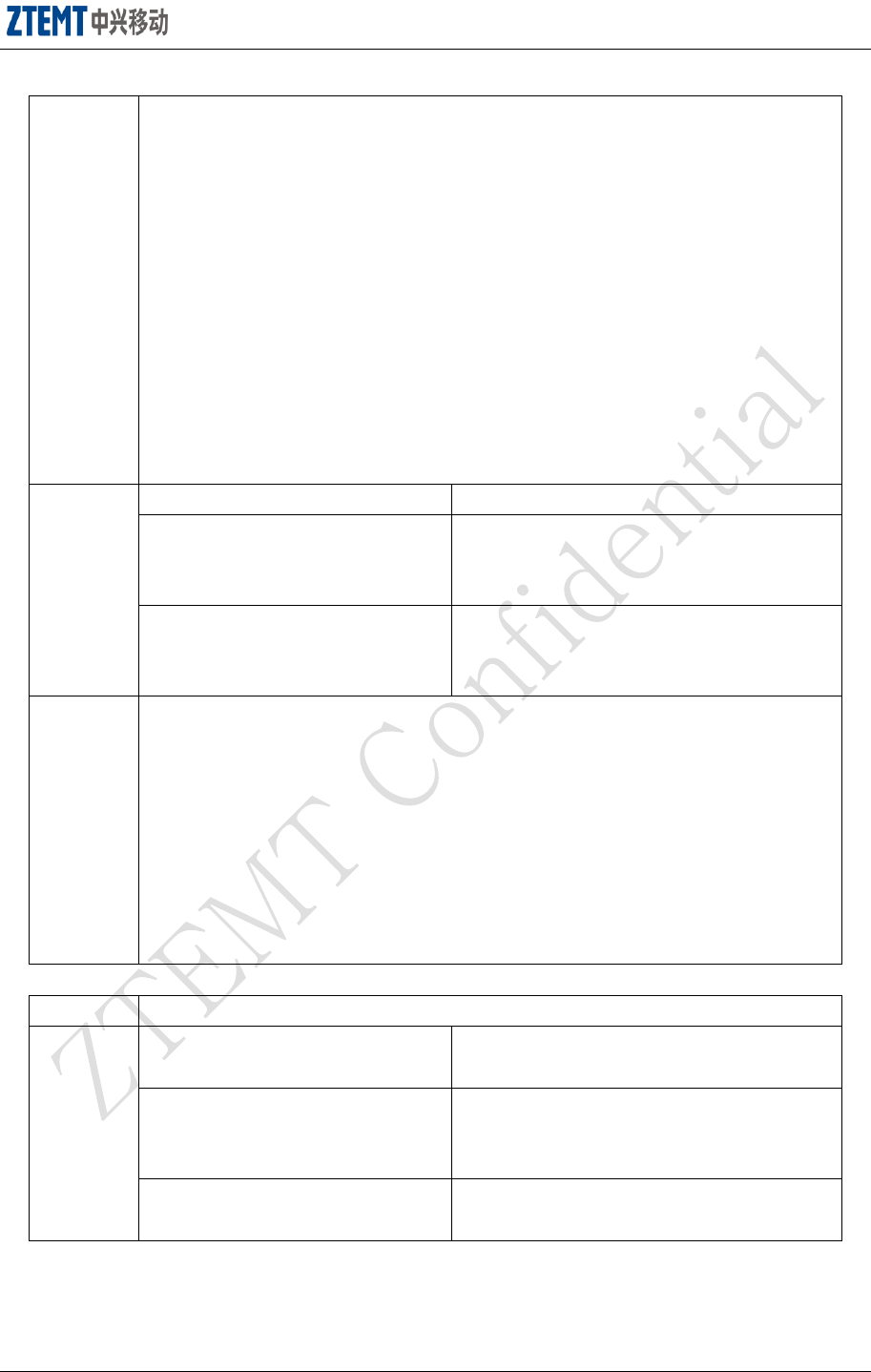
AT Command User Manual V1.1 Open▲
Page 26 of 52
parameter
<format>
0: Auto Detect
1: 8 Data 2 Stop
2: 8 Data 1 Parity 1 Stop
3: 8 Data 1 Stop
4: 7 Data 2 Stop
5: 7 Data 1 Parity 1 Stop
6: 7 Data
<parity>
0: Odd
1: Even
2: Mark
3: Space
example
AT+ICF=0,0
OK
AT+ICF?
+ICF: 2,2
OK
AT+ICF=?
+ICF: (0-6),(0-3)
OK
note
CE MUST support “AT+ICF=<format>,<parity>” which will set the character
framing between the device and a connected terminal
CE MUST set the default value of ICF to auto detect
CE MUST support “AT+ICF?” which will return the current setting in the format
“<format>,<parity>
CE MUST support “AT+ICF=?” which will return the list of supported format and
parity values in the format “<format>:<comment>” with each setting on a separate
line followed by “<parity>:<comment>” with each setting on a separate line
CE MUST return “ERROR” for any other AT+ICF string
3.1.9 +IFC: Control the local flow control
description
Control the local flow control
format
AT+IFC=<DCE_by_DTE>,
<DTE_by_DCE>
<CR><LF>OK<CR><LF>
AT+IFC?
<CR><LF>+IFC: <DCE_by_DTE>,
<DTE_by_DCE><CR><LF><CR><LF>
OK<CR><LF>
AT+IFC=?
<CR><LF>+IFC: (),()
<CR><LF><CR><LF>OK<CR><LF>
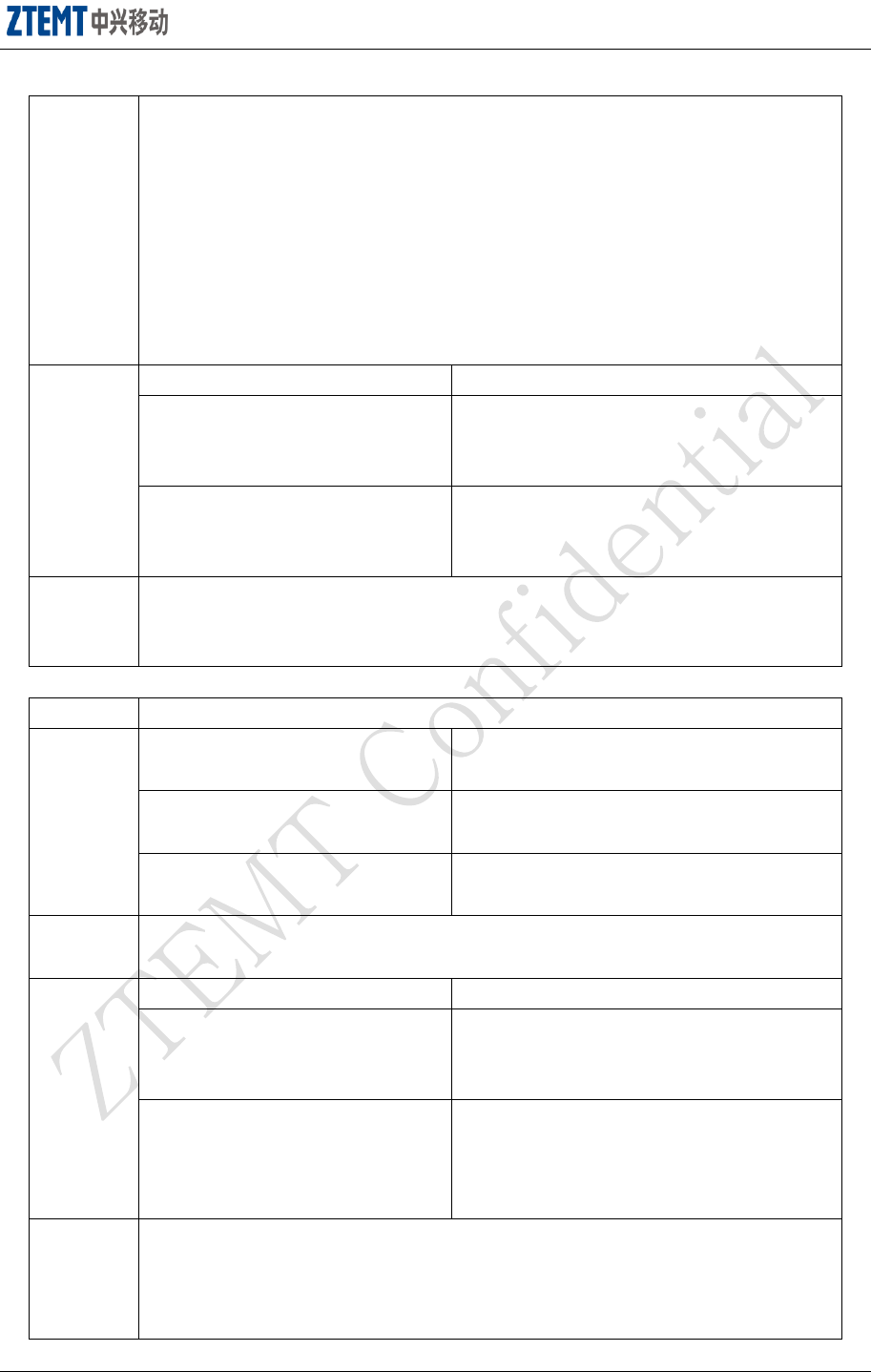
AT Command User Manual V1.1 Open▲
Page 27 of 52
parameter
<DCE_by_DTE>
0: None
1: DC1/DC3 (in band- X-On/X-Off) on circuit 103 (TD); do not pass DC1/DC3
characters to the remote modem
2: Circuit 133 (Ready for Receiving)
<DTE_by_DCE>
0: None
1: DC1/DC3 (in band- X-On/X-Off) on circuit 104 (RD
2: Circuit 106 (Clear to Send/Ready for Sending)
example
AT+IFC=0,0
OK
AT+IFC?
+IFC: 2,2
OK
AT+IFC=?
+IFC: (0-2),(0-2)
OK
note
CE MUST set the default value of IFC to none for DCE_by_DTE and
DTE_by_DCE
CE MUST return “ERROR” for any other AT+IFC string
3.1.10 +IPR: Set the Rm interface rate
description
Set the Rm interface rate to the specified rate
format
AT+IPR=<rate>
<CR><LF>OK<CR><LF>
AT+IPR?
<CR><LF>+IPR: <rate><CR><LF>
<CR><LF>OK<CR><LF>
AT+IPR=?
<CR><LF>+IPR: (),<rate><CR><LF>
<CR><LF>OK<CR><LF>
parameter
<rate>
(300,1200,2400,4800,9600,19200,38400,57600,115200,230400)
example
AT+IPR=115200
OK
AT+IPR?
+IPR: 115200
OK
AT+IPR=?
+IPR: (),(300,600,1200,2400,4800,9600,
19200,38400,57600,115200,230400)
OK
note
CE MUST return “ERROR” for any rate that is not supported by the device
CE MUST set the IPR value to 0 by default which will enable auto detect of the Rm
Interface rate
CE MUST return “ERROR” for any other AT+IPR string
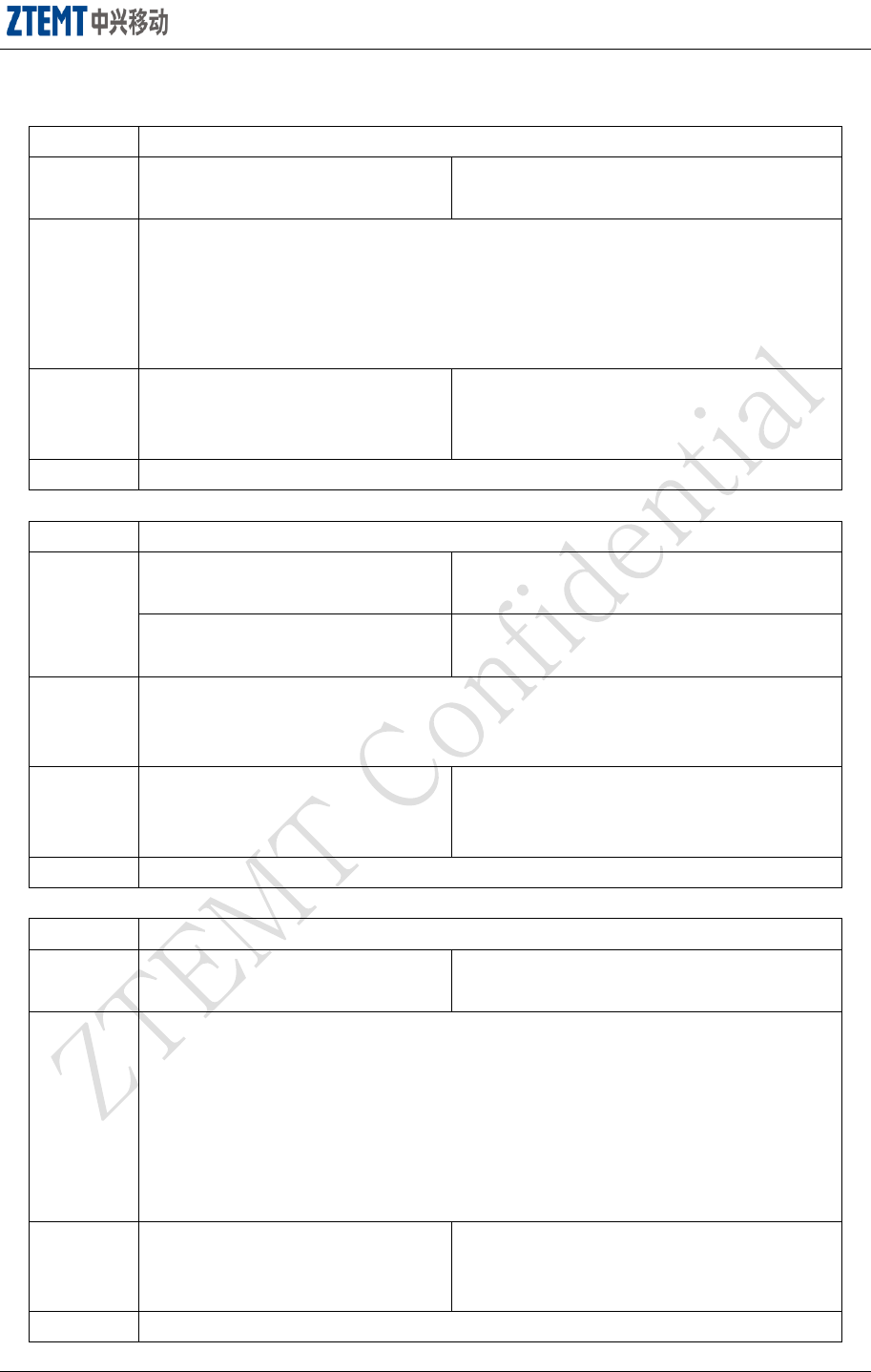
AT Command User Manual V1.1 Open▲
Page 28 of 52
3.1.11 +CAD: Return the type of service available
description
The type of service available
format
AT+CAD?
<CR><LF>+CAD: <num><CR><LF>
<CR><LF>OK<CR><LF>
parameter
<num>
0: no service is available
1: CDMA Digital service available
2: TDMA Digital service available
3: Analog service is available
example
AT+CAD?
+CAD: 0
OK
note
CE MUST return “ERROR” for any other AT+CAD string.
3.1.12 +CRM: Get he current numerical value of CRM
description
Get the current numerical value of CRM
format
AT+CRM=<value>
<CR><LF>OK<CR><LF>
AT+CRM?
<CR><LF>+CRM: <value><CR><LF>
<CR><LF>OK<CR><LF>
parameter
<value>
1: Relay Layer Packet Data Service
2: PPP Network Layer Packet Data Service
AT+CRM?
+CRM: 0
OK
note
CE MUST return “ERROR” for any other AT+CRM string
3.1.13 +CBC: The battery state and charge(not supported for modem)
description
The battery state and charge
format
AT+CBC?
<CR><LF><BCS>,<BCL>
<CR><LF><CR><LF>OK<CR><LF>
parameter
<BCS>
0: Powered by battery only
1: Connected to an external source
2: Battery status not available
3: Power fault
<BCL>
the number if battery bars the UI is currently displaying
example
AT+CBC?
0,0
OK
note
CE MUST return “ERROR” for any other AT+CBC string
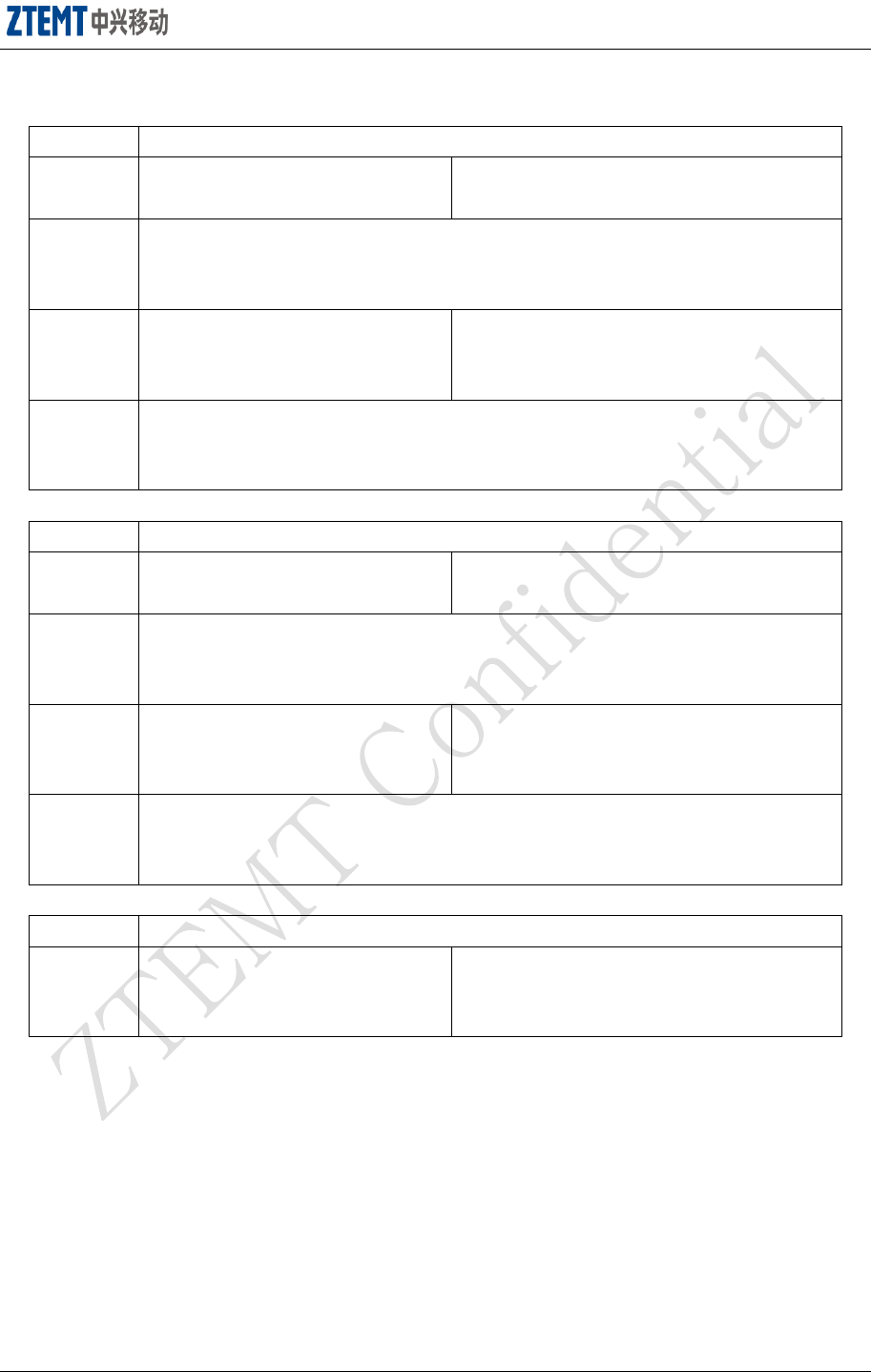
AT Command User Manual V1.1 Open▲
Page 29 of 52
3.1.14 +CMIP: IP address of the mobile station
description
IP address of the mobile station
format
AT+CMIP?
<CR><LF><address> <CR><LF>
<CR><LF>OK<CR><LF>
parameter
<address>
the IP address will be the IP address assigned by the network in PPP IPCP for SIP or
in the MIP Registration Reply for Mobile IP
example
AT+CMIP?
0.0.0.0
OK
note
CE MUST return “0.0.0.0” for “AT+CMIP?” if there is currently no IP session
established
CE MUST return “ERROR” for any other AT+CMIP string
3.1.15 +CBIP: IP address of the base station
description
IP address of the base station
format
AT+CBIP?
<CR><LF><address>
<CR><LF><CR><LF>OK<CR><LF>
parameter
<address>
the IP address will be the source IP address in the Router Advertisement message
that the device receives from the network
example
AT+CBIP?
0.0.0.0
OK
note
CE MUST return “0.0.0.0” for “AT+CBIP?” if there is currently no IP session
established
CE MUST return “ERROR” for any other AT+CBIP string
3.1.16 +CSS: The serving system band and SID
description
The serving system band and SID
format
AT+CSS?
<CR><LF>+CSS: <Channel>,<Band>,
<SID><CR><LF><CR><LF>OK
<CR><LF>
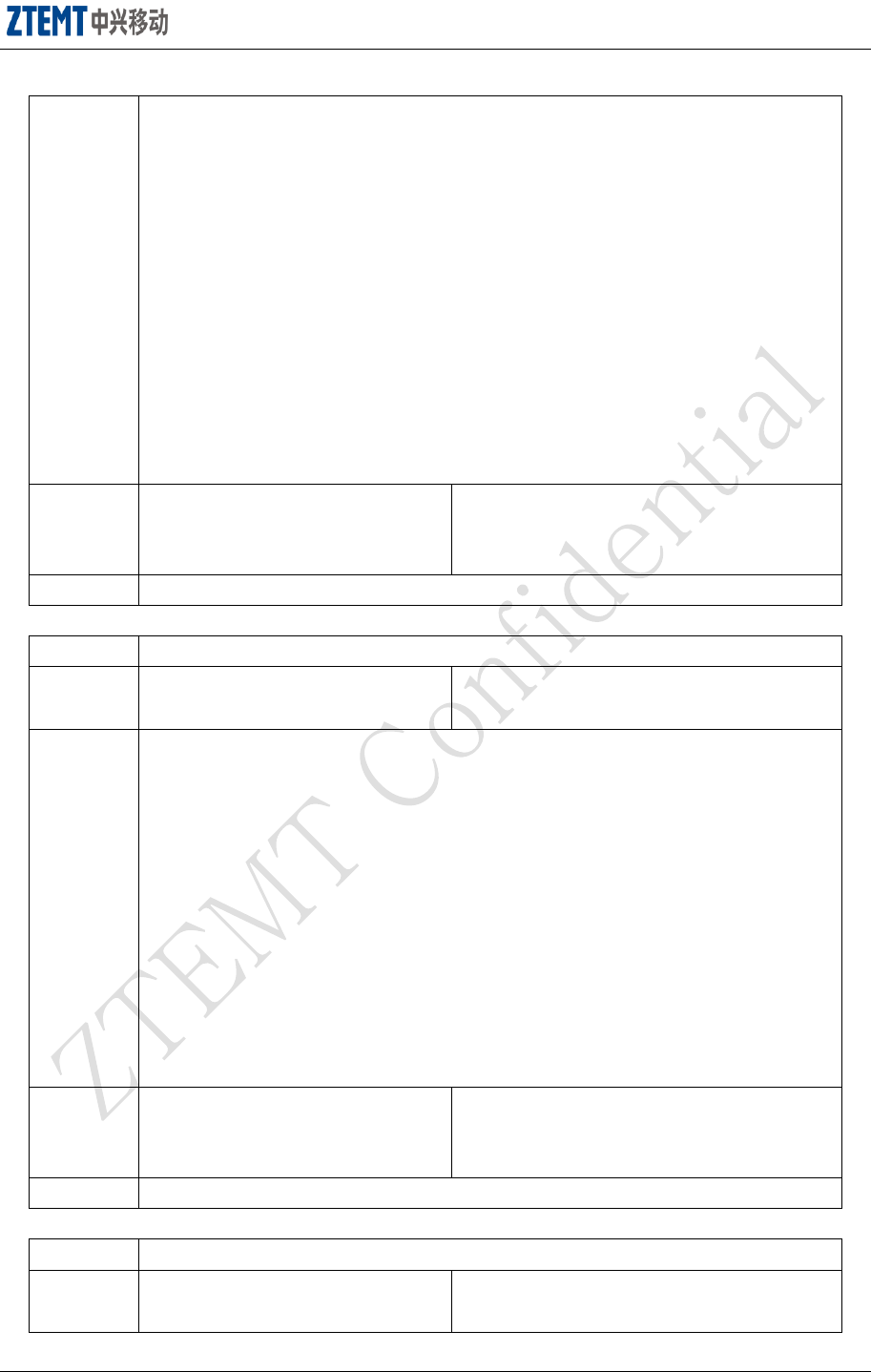
AT Command User Manual V1.1 Open▲
Page 30 of 52
parameter
<Channel>
Channel will be the channel that the device is currently talking or listening to
<Band>
A: Device is operating in the A block
B: Device is operating in the B block
C: Device is operating in the C block
D: Device is operating in the D block
E: Device is operating in the E block
F: Device is operating in the F block
G: Device is operating in the G block
Z: Device is not registered
<SID>
SID will be the numerical value of the SID or 999999 if the mobile is not registered
example
AT+CSS?
+CSS: 0,0,0
OK
note
CE MUST return “ERROR” for any other AT+CSS string
3.1.17 +CSQ: Signal Quality Measure and the Frame Error Rate
description
Signal Quality Measure and the Frame Error Rate
format
AT+CSQ?
<CR><LF>+CSQ: <SEQ>,<FER>
<CR><LF><CR><LF>OK<CR><LF>
parameter
<SEQ>
the measured RSSI value
<FER>
0: less than 0.01%
1: 0.01% to less than 0.1%
2: 0.1% to less than 1.0%
3: 0.5% to less than 1.0%
4: 1.0% to less than 2.0%
5: 2.0% to less than 4.0%
6: 4.0% to less than 8.0%
7: greater than 8.0%
99: FER is unknown
example
AT+CSQ?
+CSQ: 31,99
OK
note
CE MUST return “ERROR” for any other AT+CSQ string
3.1.18 +CTA: The packet data inactivity timer
description
The packet data inactivity timer
format
AT+CTA?
<CR><LF>+CTA: <value>
<CR><LF><CR><LF>OK<CR><LF>
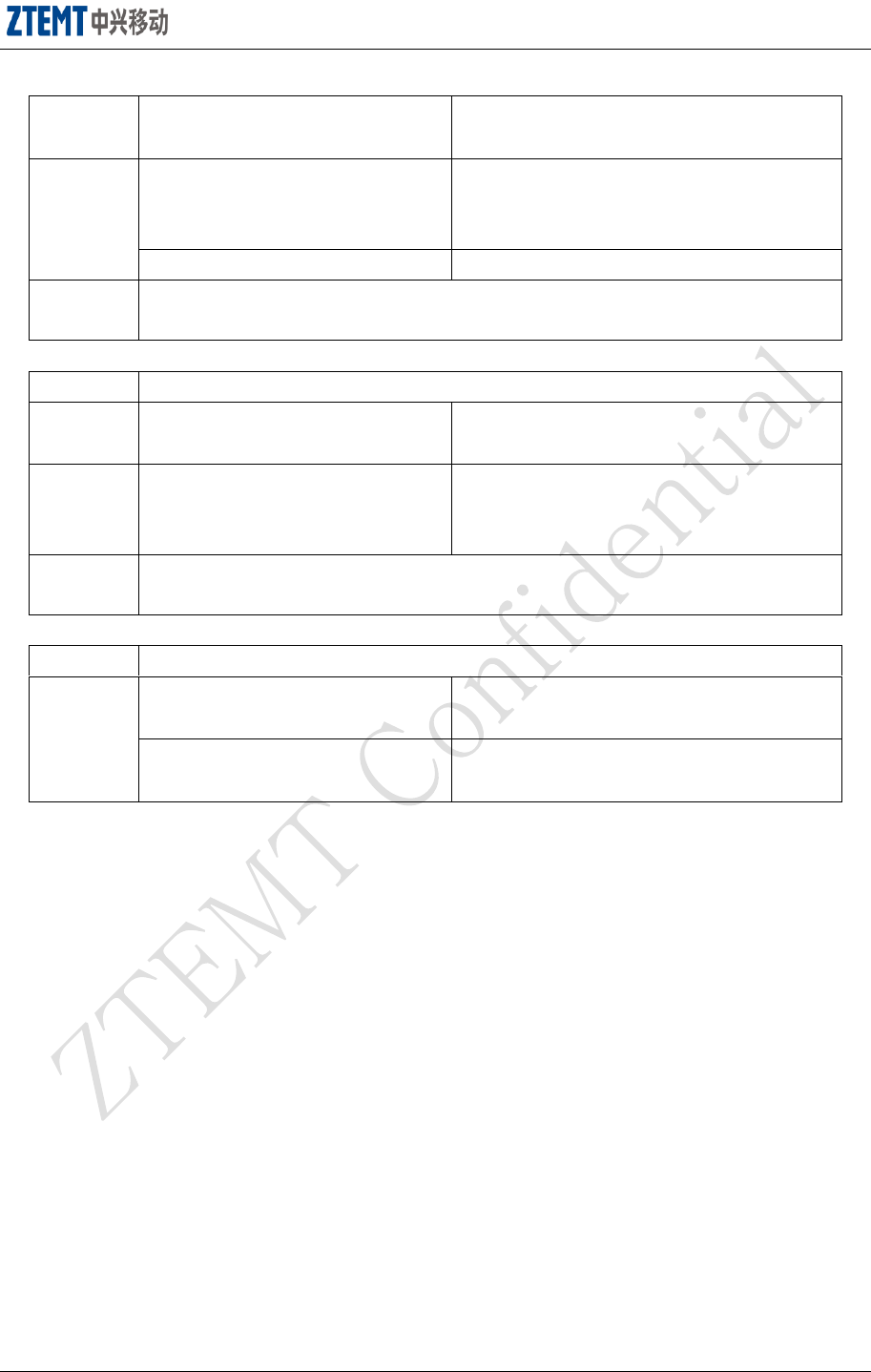
AT Command User Manual V1.1 Open▲
Page 31 of 52
AT+CTA=<value>
<CR><LF>OK<CR><LF>
example
AT+CTA?
+CTA: 30
OK
AT+CTA=1
OK
note
CE MUST NOT support “AT+CTA=<value>”
CE MUST return “ERROR” for any other AT+CTA string
3.1.19 +CPS: The service option to be used for packet data service(Not implemented)
description
The service option to be used for packet data service
format
AT+CPS?
<CR><LF>+CPS: <value><CR><LF>
<CR><LF>OK<CR><LF>
example
AT+CPS?
+CPS: 1
OK
note
CE MUST NOT support “AT+CPS =<value>”
CE MUST return “ERROR” for any other AT+CPS string
3.1.20 +CPSR: Disable/Enable the packet call state reporting(Not implemented)
description
Disable/Enable the packet call state reporting
format
AT+CPSR?
<CR><LF>+CPSR: <value><CR><LF>
<CR><LF>OK<CR><LF>
AT+ CPSR=<value>
<CR><LF><CR><LF>OK<CR><LF>
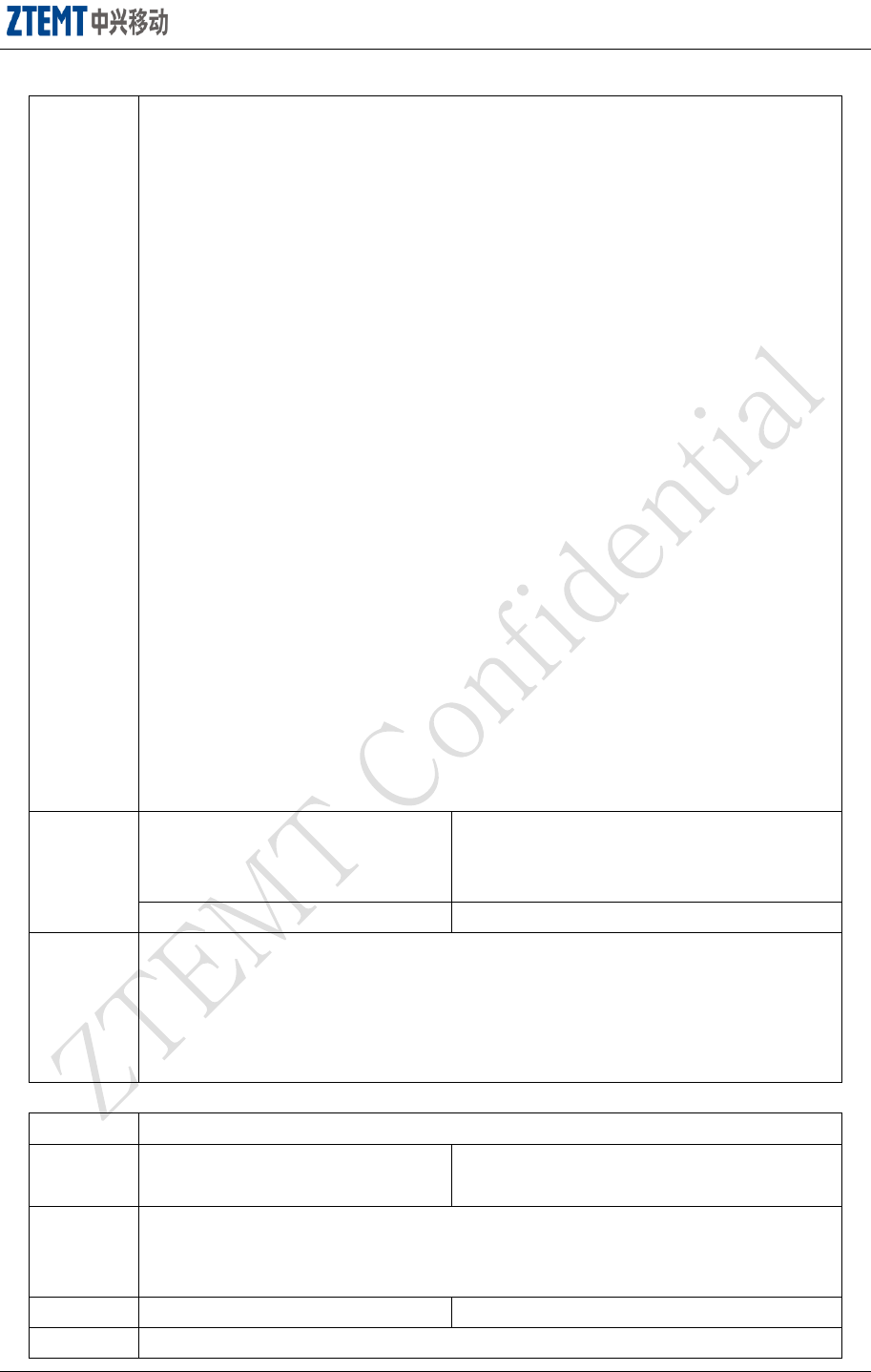
AT Command User Manual V1.1 Open▲
Page 32 of 52
parameter
<value>
0: disable
1: enable
Note: enabling packet call state reporting will cause the device to autonomously
send the following information
0: Packet data service is in the Inactive State
1: Packet data service is in the Active State, and the call control function is in the
Initialization/Idle State
2: Packet data service is in the Active State, and the call control function is in the
Initialization/Traffic State
3: Packet data service is in the Active State, the
call control function is in the Connected State, and the packet data service option is
using primary traffic
4: Packet data service is in the Active State, the
call control function is in the Connected State, and the packet data service option is
using secondary traffic
5: Packet data service is in the Active State, and the call control function is in the
Dormant/Idle State
6: Packet data service is in the Active State, and the call control function is in the
Dormant/Traffic State
7: Packet data service is in the Active State, and the call control function is in the
Reconnect/Idle State
8: Packet data service is in the Active State, and the call control function is in the
Reconnect/Traffic State
example
AT+CPSR?
+CPSR: 1
OK
AT+CPSR=1
OK
note
CE MUST set the packet call state reporting to disable as they default
CE MUST set the packet call state reporting to disable when the Rm Interface is torn
down
Note: this could be due to the data cable being removed or the device power cycling.
CE MUST return “ERROR” for any other AT+CPSR string
3.1.21 +CPTC: Request a traffic channel(Not implemented)
description
Request a traffic channel
format
AT+CPTC=<value>
<CR><LF><CR><LF>OK<CR><LF>
parameter
<value>
0: release the traffic channel
1: originate a traffic channel
example
AT+CPTC=0
OK
note
CE MUST return “ERROR” for any other AT+CPTC string
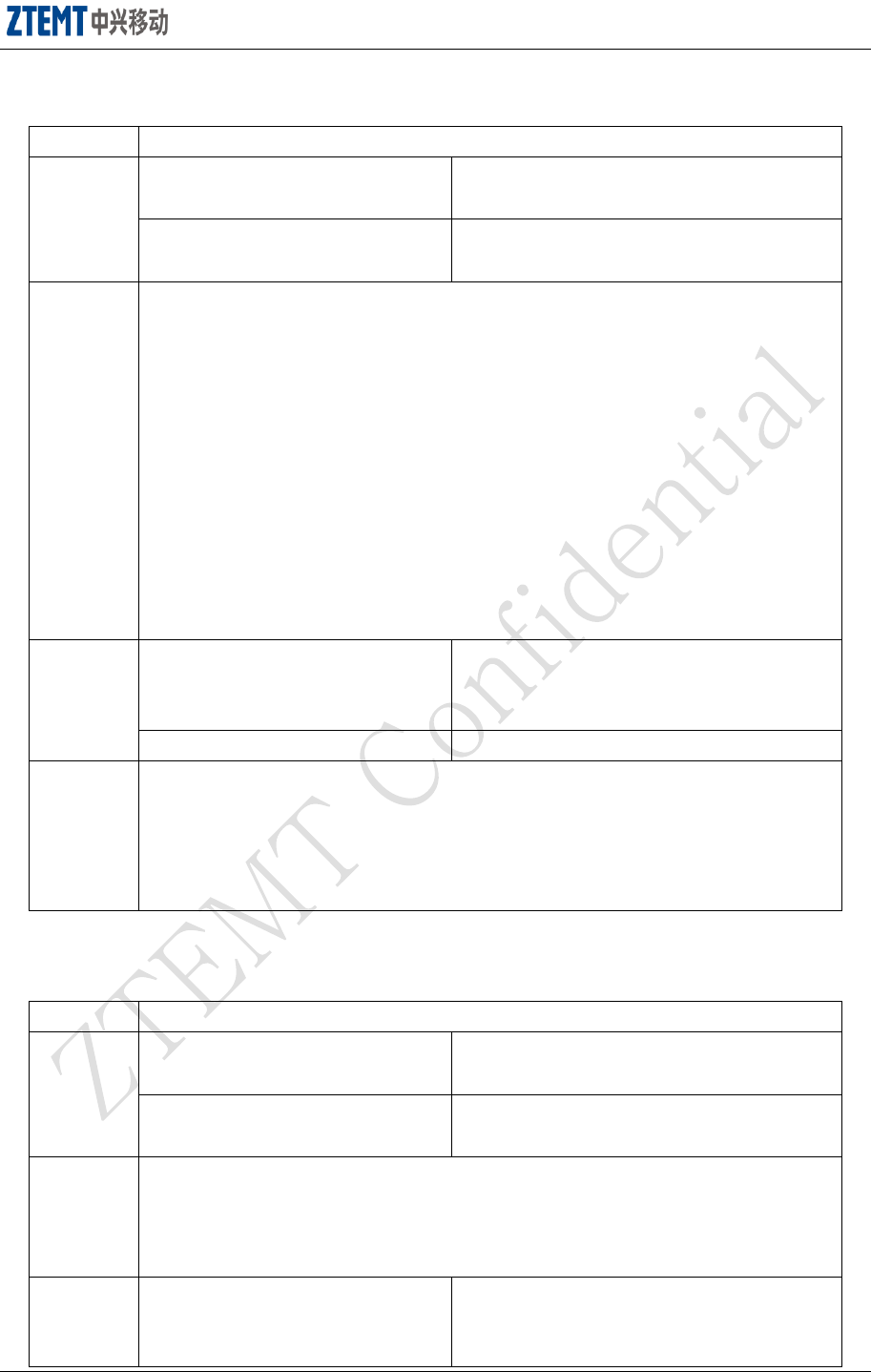
AT Command User Manual V1.1 Open▲
Page 33 of 52
3.1.22 +CPER: Disable/Enable the packet call event reporting(Not implemented)
description
Disable/Enable the packet call event reporting
format
AT+CPER?
<CR><LF>+CPER: <value><CR><LF>
<CR><LF>OK<CR><LF>
AT+CPER=<value>
<CR><LF><CR><LF>OK<CR><LF>
parameter
<value>
0: disable
1: enable
Note: enabling packet call event reporting will cause the device to autonomously
send the following information
0: Enter Idle State
1: Idle handoff, same system
2: Idle handoff, new system
3: Page received
4: Origination sent
5: Traffic Channel assigned
6: Hard handoff
example
AT+CPER?
+CPER: 1
OK
AT+CPER=1
OK
note
CE MUST set the packet call event reporting to disable as they default.
CE MUST set the packet call event reporting to disable when the Rm Interface is
torn down.
Note: this could be due to the data cable being removed or the device power cycling.
ATCMD-089 CE MUST return “ERROR” for any other AT+CPER string
4 Qualcomm Proprietary AT Command Set
4.1.1 $QCMIP: The current value of the Mobile IP behavior
description
The current value of the Mobile IP behavior
format
AT$QCMIP?
<CR><LF>$QCMIP: <value><CR><LF>
<CR><LF>OK<CR><LF>
AT$QCMIP=<value>
<CR><LF><CR><LF>OK<CR><LF>
parameter
<value>
0: the Mobile IP behavior to Simple IP only
1: the Mobile IP behavior to MIP preferred with SIP fallback
2: the Mobile IP behavior to MIP only
example
AT$QCMIP?
$QCMIP: 1
OK
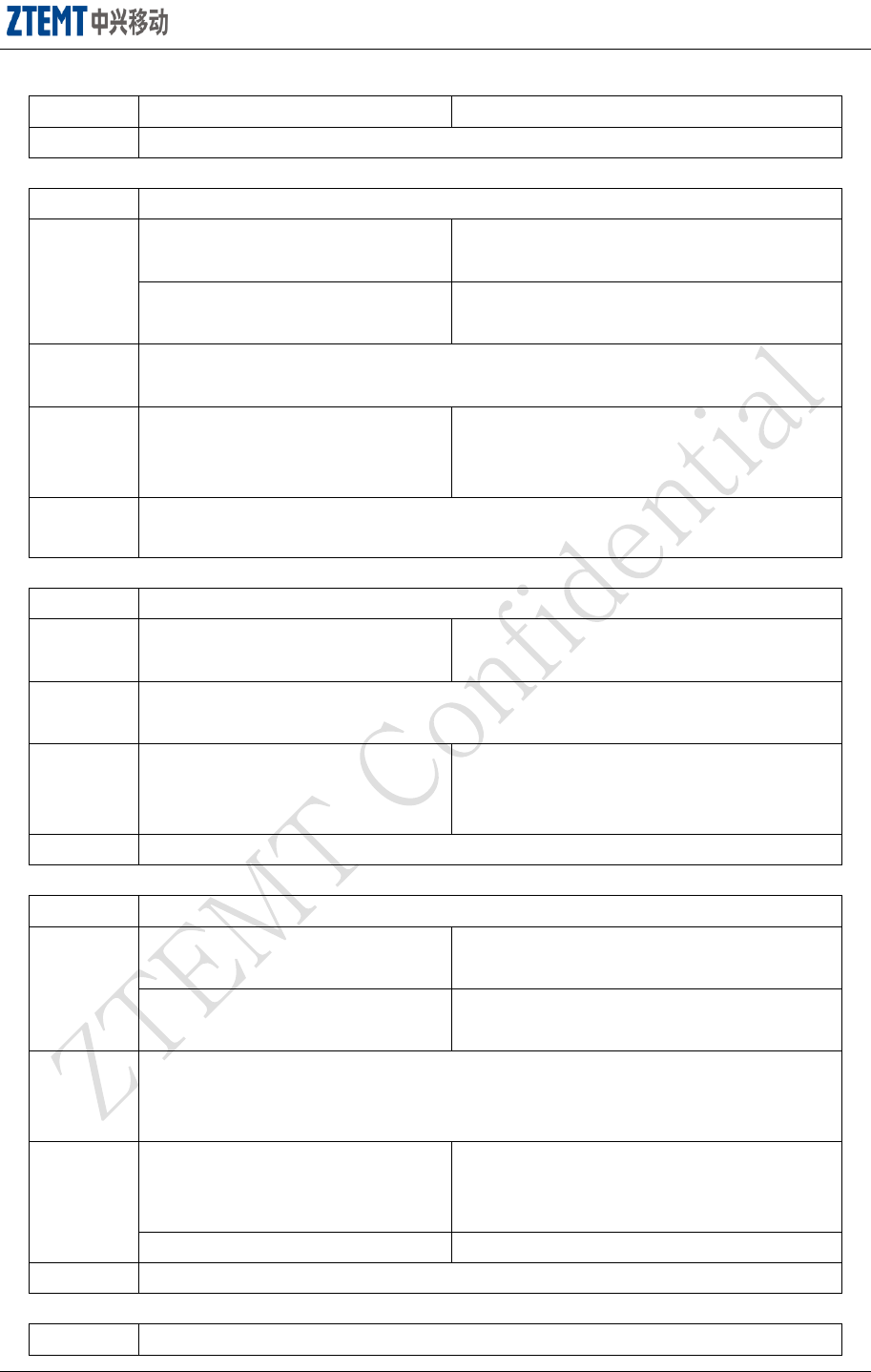
AT Command User Manual V1.1 Open▲
Page 34 of 52
AT$QCMIP=1
OK
note
CE MUST return “ERROR” for any other AT$QCMIP string
4.1.2 $QCMIPP: Return the current active Mobile IP profile
description
Return the current active Mobile IP profile
format
AT$QCMIPP?
<CR><LF>$QCMIPP: <X><CR><LF>
<CR><LF>OK<CR><LF>
AT$QCMIPP=<X>
<CR><LF>OK<CR><LF>
parameter
<X>
0 ~ 5
example
AT$QCMIPP?
$QCMIPP: 1
OK
note
CE MUST support “AT$QCMIPP=X” where X is an integer between 0 and 5
CE MUST return “ERROR” for any other AT$QCMIPP string
4.1.3 $QCMIPT:The current value of the “RFC 2002bis authentication” flag
description
The current value of the “RFC 2002bis authentication” flag
format
AT$QCMIPT?
<CR><LF>$QCMIPT: <value><CR><LF>
<CR><LF>OK<CR><LF>
parameter
<value>
the valid return values for this command are 0, 1
example
AT$QCMIPT?
$QCMIPT: 1
OK
note
CE MUST return “ERROR” for any other AT$QCMIPT string
4.1.4 $QCMIPEP: Disable/Enable the active profile
description
Disable/Enable the active profile
format
AT$QCMIPEP?
<CR><LF>$QCMIPEP: <value><CR><LF>
<CR><LF>OK<CR><LF>
AT$QCMIPEP=<value>
<CR><LF><CR><LF>OK<CR><LF>
parameter
<value>
0: disable the active profile
1: enable the active profile
example
AT$QCMIPEP?
$QCMIPEP: 1
OK
AT$QCMIPEP=1
OK
note
CE MUST return “ERROR” for any other AT$QCMIPEP string
4.1.5 $QCMIPGETP: The values of the specified profile
description
The values of the specified profile
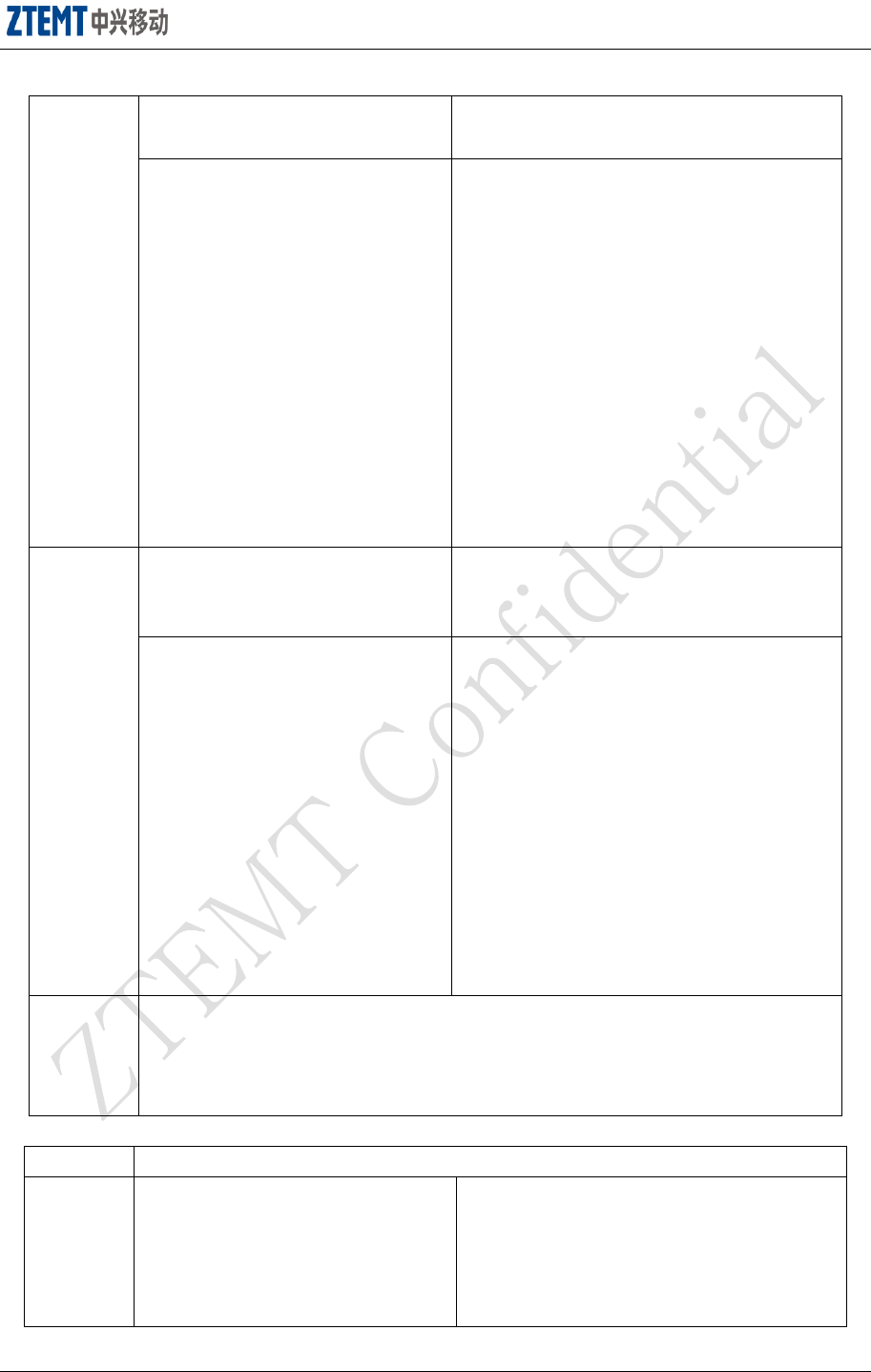
AT Command User Manual V1.1 Open▲
Page 35 of 52
format
AT$QCMIPGETP?
<CR><LF>$QCMIPGETP: <X>
<CR><LF><CR><LF>OK<CR><LF>
AT$QCMIPGETP=<X>
<CR><LF>
Profile <X> (Enabled | Disabled)
NAI:
Home Address:
Primary HA:
Secondary HA:
MN-AAA SPI:
MN-HA SPI:
Reverse Tunneling: (0 for off | 1 for on)
RFC 2002bis: (0 for off | 1 for on)
MN-AAA SS: (set | unset)
NA-HA SS: (set | unset)
<CR><LF><CR><LF>OK<CR><LF>
example
AT$QCMIPGETP?
$QCMIPGETP: 0
OK
AT$QCMIPGETP=0
Profile:0 Enabled
NAI:Unset
Home Addr:0.0.0.0
Primary HA:255.255.255.255
Secondary HA:0.0.0.0
MN-AAA SPI:2
MN-HA SPI:3
Rev Tun:0
MN-AAA SS:Unset
MN-HA SS:Unset
OK
note
CE MUST separate each line of the profile with exactly one carriage return and line
feed
CE MUST NOT display the SS (Shared Secret)
CE MUST return “ERROR” for any other AT$QCMIPGETP string
4.1.6 $QCMIPNAI: Set ASCII NAI string
description
Set ASCII NAI string
format
AT$QCMIPNAI?
<CR><LF>< NAI ><Y><CR><LF>
<CR><LF>OK<CR><LF>
or
<CR><LF>$QCMIPNAI: Unset<CR><LF>
<CR><LF>OK<CR><LF>
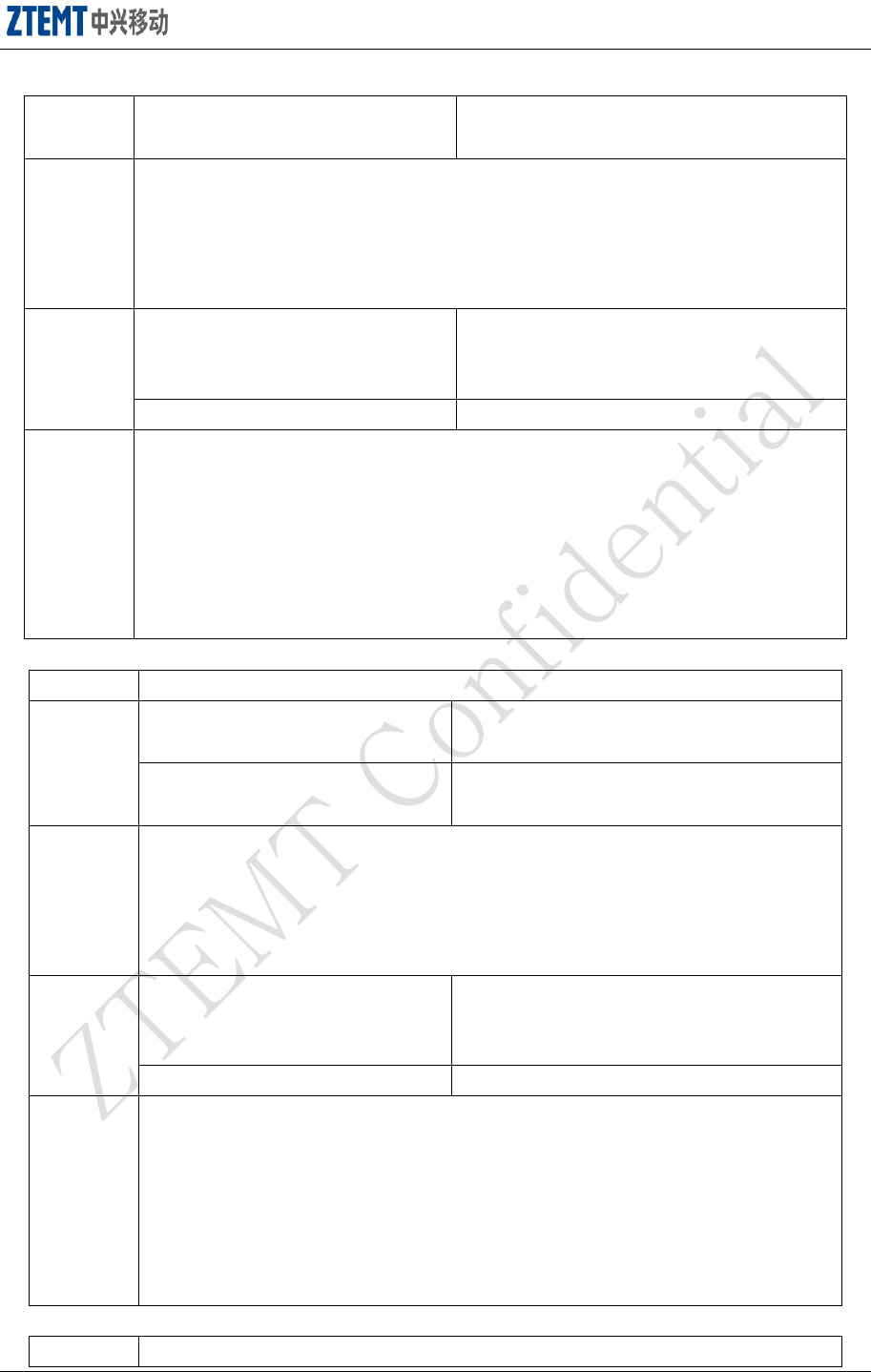
AT Command User Manual V1.1 Open▲
Page 36 of 52
AT$QCMIPNAI=”< NAI >”,<Y>
<CR><LF><CR><LF>OK<CR><LF>
parameter
<NAI>
the user entered ASCII NAI string
<Y>
0: not save the NAI to NV memory
1: save the NAI to NV memory
example
AT$QCMIPNAI?
user@domain,0
OK
AT$QCMIPNAI=”user@domain”,0
OK
note
CE MUST NOT save the NAI to NV memory if Y is set to 0
CE MUST use the user entered NAI only for the next MIP session if Y is set to 0.
Note: the device must use the user entered NAI for MIP reregistrations as well as the
initial MIP registration
CE MUST use the NAI stored in NV memory after the MIP session has deregistered
or expired if Y is set to 0
CE MUST save the NAI to NV memory if Y is set to 1
4.1.7 $QCMIPRT: Set user reverse tunneling flag
description
Set user reverse tunneling flag
format
AT$QCMIPRT?
<CR><LF>$QCMIPRT: <X>,<Y>
<CR><LF><CR><LF>OK<CR><LF>
AT$QCMIPRT=<X>,<Y>
<CR><LF><CR><LF>OK<CR><LF>
parameter
<X>
set the user reverse tunneling flag (0|1)
<Y>
0: not save the reverse tunneling flag to NV memory
1: save the reverse tunneling flag to NV memory
example
AT$QCMIPRT?
$QCMIPRT: 0,1
OK
AT$QCMIPRT=0,0
OK
note
CE MUST NOT save the reverse tunneling flag to NV memory if Y is set to 0
CE MUST use the user entered reverse tunneling flag only for the next MIP session
if Y is set to 0
CE MUST use the reverse tunneling flag stored in NV memory after the MIP session
has deregistered or expired if Y is set to 0
CE MUST save the reverse tunneling flag to NV memory if Y is set to 1
CE MUST return “ERROR” for any other AT$QCMIPRT string
4.1.8 $QCMIPMASS: Set ASCII Mobile Node AAA shared secret string
description
Set ACSII Mobile Node AAA shared secret string
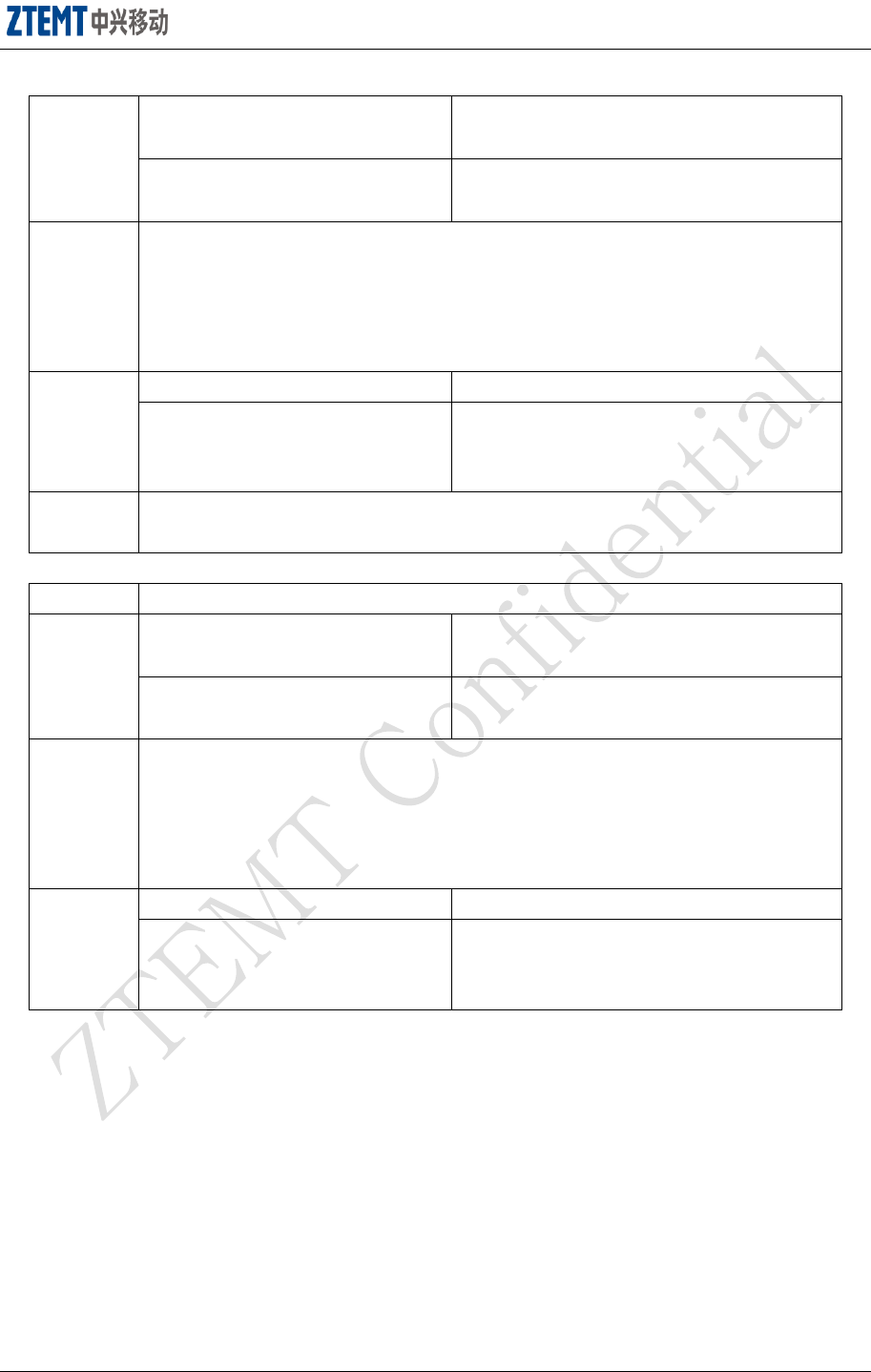
AT Command User Manual V1.1 Open▲
Page 37 of 52
format
AT$QCMIPMASS=”<X>”,<Y>
<CR><LF><CR><LF>OK<CR><LF>
AT$QCMIPMASS?
<CR><LF>$QCMIPMASS: (Set|Unset)
<CR><LF><CR><LF>OK<CR><LF>
parameter
<X>
ASCII Mobile Node AAA shared secret string
<Y>
0: not save the change to NV memory
1: save the change to NV memory
example
AT$QCMIPMASS =”sprint”,0
OK
AT$QCMIPMASS?
$QCMIPMASS: Set
OK
note
the Mobile Node AAA shared secret string MUST be enclosed between double
quotes
4.1.9 $QCMIPMASSX: Set Hex Mobile Node AAA shared secret
description
Set Hex Mobile Node AAA shared secret
format
AT$QCMIPMASSX=”<X>”,<Y>
<CR><LF><CR><LF>OK<CR><LF>
AT$QCMIPMASSX?
<CR><LF>$QCMIPMASSX: (Set|Unset)
<CR><LF><CR><LF>OK<CR><LF>
parameter
<X>
the user entered hex Mobile Node AAA shared secret of up to 16 bytes
<Y>
0: not save the change to NV memory
1: save the change to NV memory
example
AT$QCMIPMASSX=”aaa”,0
OK
AT$QCMIPMASSX?
$QCMIPMASSX: Set
OK
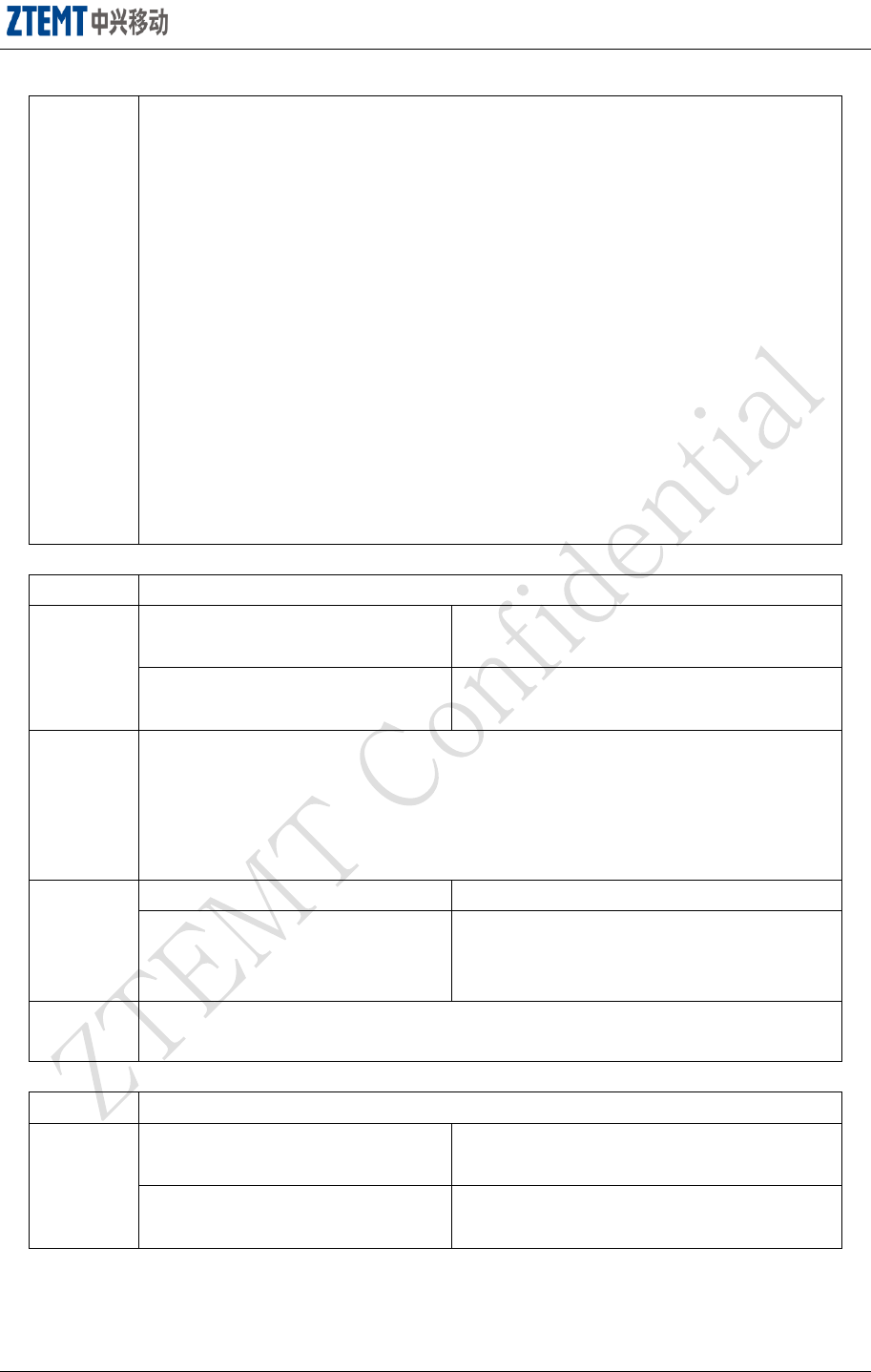
AT Command User Manual V1.1 Open▲
Page 38 of 52
note
CE MUST return “ERROR” if the user entered Mobile Node AAA shared secret
begins with “0x” for AT$QCMIPMASSX.
CE MUST return “ERROR” and not save a Mobile Node AAA shared secret that is
longer than 16 bytes for AT$QCMIPMASSX.
CE MUST return “ERROR” and not save a Mobile Node AAA shared secret that is
longer than the maximum allowed length when using AT$QCMIPMASS.
CE MUST return “ERROR” and not save a Mobile Node AAA shared secret that
contains any characters other than (0-9,A-F,a-f) for AT$QCMIPMASSX.
CE MUST NOT save the Mobile Node AAA shared secret to NV memory if Y is set
to 0.
CE MUST use the user entered Mobile Node AAA shared secret only for the next
MIP session if Y is set to 0.
CE MUST use the Mobile Node AAA shared secret stored in NV memory after the
MIP session has deregistered or expired if Y is set to 0.
CE MUST save the Mobile Node AAA shared secret to NV memory if Y is set to 1
4.1.10 $QCMIPMHSS: Set ASCII Mobile Node Home Agent shared secret
description
Set ASCII Mobile Node Home Agent shared secret string
format
AT$QCMIPMHSS=”<X>”,<Y>
<CR><LF><CR><LF>OK<CR><LF>
AT$QCMIPMHSS?
<CR><LF>$QCMIPMHSS: (Set|Unset)
<CR><LF><CR><LF>OK<CR><LF>
parameter
<X>
the user entered ASCII Mobile Node Home Agent shared secret string
<Y>
0: NOT save the reverse tunneling flag to NV memory
1: save the reverse tunneling flag to NV memory
example
AT$QCMIPMHSS=“1234”,0
OK
AT$QCMIPMHSS?
$QCMIPMHSS: Unset
OK
note
The Mobile Node Home Agent shared secret string MUST be enclosed between
double quotes
4.1.11 $QCMIPMASSX: Set hex Mobile Node Home Agent shared secret
description
Set hex Mobile Node Home Agent shared secret
format
AT$QCMIPMHSSX=”<X>”,<Y>
<CR><LF><CR><LF>OK<CR><LF>
AT$QCMIPMHSSX?
<CR><LF>$QCMIPMHSSX: (Set|Unset)
<CR><LF><CR><LF>OK<CR><LF>
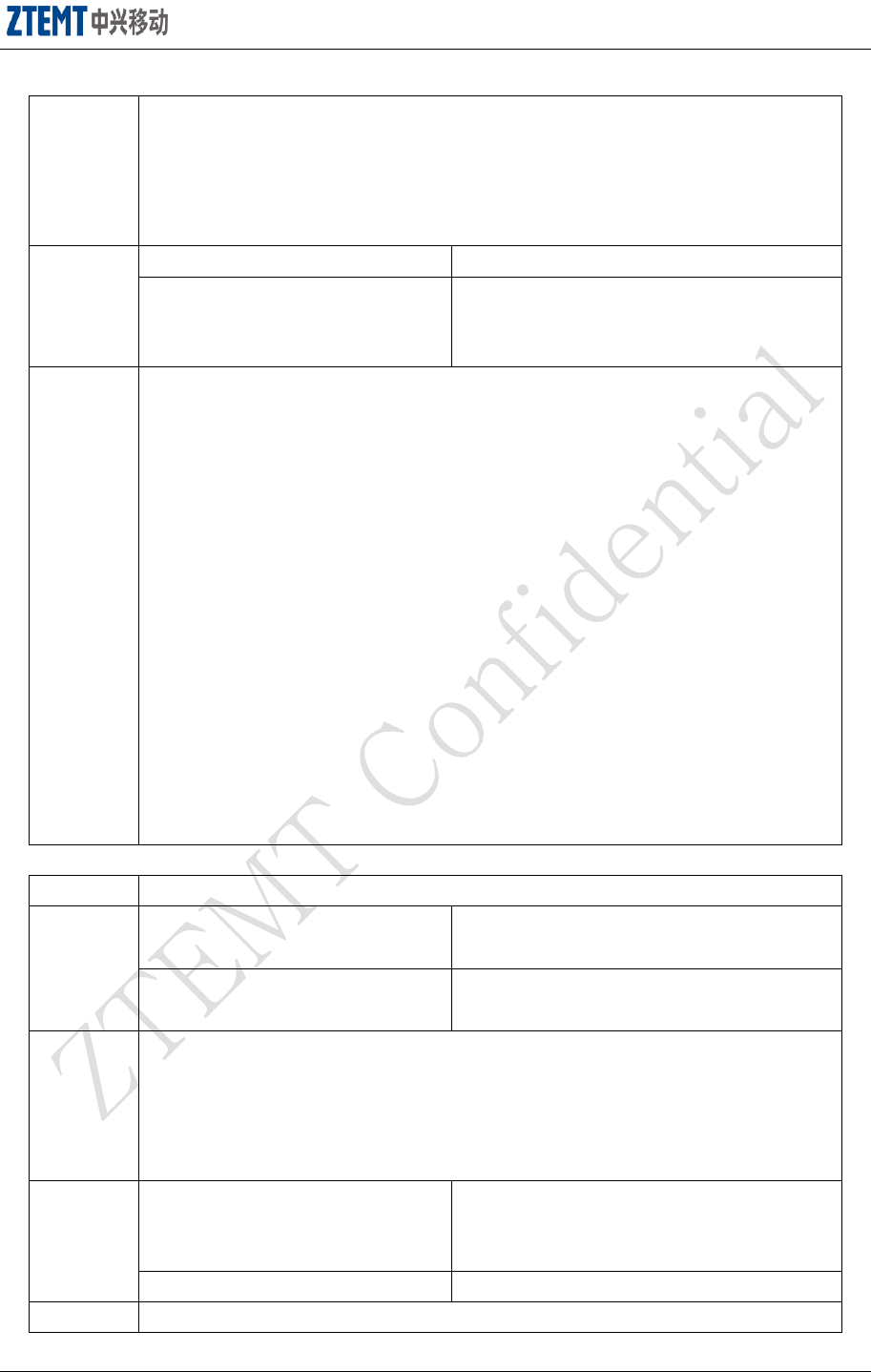
AT Command User Manual V1.1 Open▲
Page 39 of 52
parameter
<X>
the user entered hex Mobile Node Home Agent shared secret of up to 16 bytes
<Y>
0: not save the change to NV memory
1: save the change to NV memory
example
AT$QCMIPMHSSX = “aaaaaa”,0
OK
AT$QCMIPMHSSX?
$QCMIPMHSSX: Set
OK
note
CE MUST return “ERROR” if the user entered Mobile Node Home Agent shared
secret begins with “0x” for AT$QCMIPMHSSX
CE MUST return “ERROR” and not save a Mobile Node Home Agent shared secret
that is longer than 16 bytes for AT$QCMIPMHSSX
CE MUST return “ERROR” and not save a Mobile Node Home Agent shared secret
that is longer than the maximum allowed length when using AT$QCMIPMHSSX.
CE MUST return “ERROR” and not save a Mobile Node Home Agent shared secret
that contains any characters other than (0-9,A-F,a-f) for AT$QCMIPMHSSX
CE MUST NOT save the Mobile Node Home Agent shared secret to NV memory if
Y is set to 0
CE MUST use the user entered Mobile Node Home Agent shared secret only for the
next MIP session if Y is set to 0
CE MUST use the Mobile Node Home Agent shared secret stored in NV memory
after the MIP session has deregistered or expired if Y is set to 0.
CE MUST save the Mobile Node Home Agent shared secret to NV memory if Y is
set to 1
4.1.12 $QCMIPMASPI: Set Mobile Node AAA SPI integer value
description
Set Mobile Node AAA SPI integer value the change to NV memory
format
AT$QCMIPMASPI?
<CR><LF>$QCMIPMASPI: <X>,<Y>
<CR><LF><CR><LF>OK<CR><LF>
AT$QCMIPMASPI=<X>,<Y>
<CR><LF><CR><LF>OK<CR><LF>
parameter
<X>
the user entered Mobile Node AAA SPI integer value between (0-4294967295)
<Y>
0: not save the change to NV memory
1: save the change to NV memory
example
AT$QCMIPMASPI?
$QCMIPMASPI: 2,1
OK
AT$QCMIPMASPI=1234,0
OK
note
CE MUST return “ERROR” for any other AT$QCMIPMASPI string.
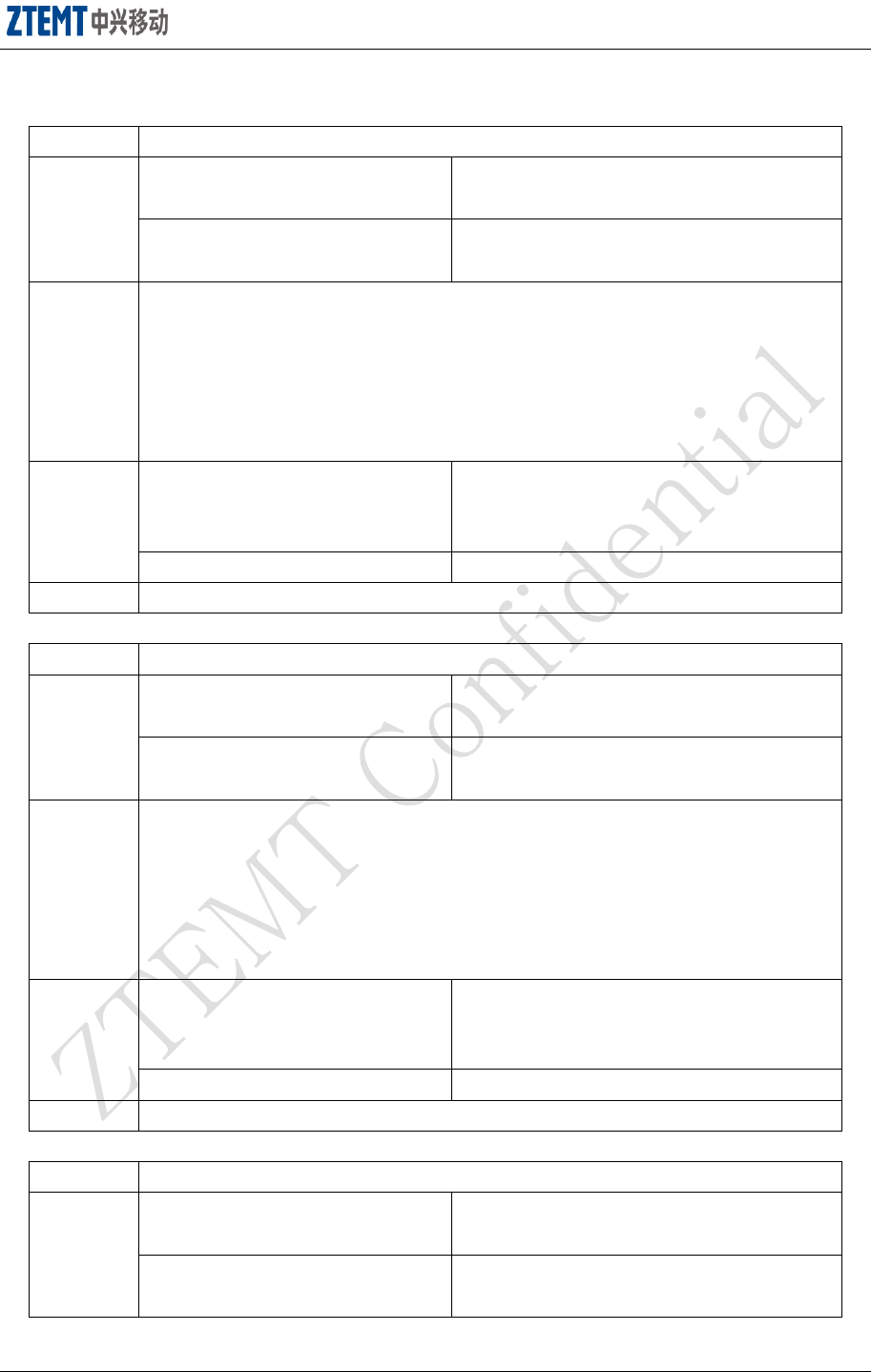
AT Command User Manual V1.1 Open▲
Page 40 of 52
4.1.13 $QCMIPMHSPI: Set Mobile Node Home Agent SPI integer value
description
Set Mobile Node Home Agent SPI integer value the change to NV memory
format
AT$QCMIPMHSPI?
<CR><LF>$QCMIPMHSPI: <X>,<Y>
<CR><LF><CR><LF>OK<CR><LF>
AT$QCMIPMHSPI=<X>,<Y>
<CR><LF><CR><LF>OK<CR><LF>
parameter
<X>
the user entered Mobile Node Home Agent SPI integer value between
(0-4294967295)
<Y>
0: not save the change to NV memory
1: save the change to NV memory
example
AT$QCMIPMHSPI?
$QCMIPMHSPI: 3,1
OK
AT$QCMIPMHSPI=1234,0
OK
note
CE MUST return “ERROR” for any other AT$QCMIPMHSPI string.
4.1.14 $QCMIPPHA: Set Primary Home Agent IP Address
description
Set Primary Home Agent IP Address
format
AT$QCMIPPHA?
<CR><LF>$QCMIPPHA: <X>,<Y>
<CR><LF><CR><LF>OK<CR><LF>
AT$QCMIPPHA =”<X>”,<Y>
<CR><LF><CR><LF>OK<CR><LF>
parameter
<X>
the Primary Home Agent IP Address string MUST be enclosed between double
quotes. Valid values for X are ( (0-255).(0-255).(0-255).(0-255))
<Y>
0: not save the change to NV memory
1: save the change to NV memory
example
AT$QCMIPPHA?
$QCMIPPHA:192.168.1.10,0
OK
AT$QCMIPPHA=”192.168.1.10”,0
OK
note
CE MUST return “ERROR” for any other AT$QCMIPPHA string.
4.1.15 $QCMIPSHA: Set secondary Home Agent IP Address
description
Set secondary Home Agent IP Address
format
AT$QCMIPSHA?
<CR><LF>$QCMIPSHA: <X>,<Y>
<CR><LF><CR><LF>OK<CR><LF>
AT$QCMIPSHA =”<X>”,<Y>
<CR><LF><CR><LF>OK<CR><LF>
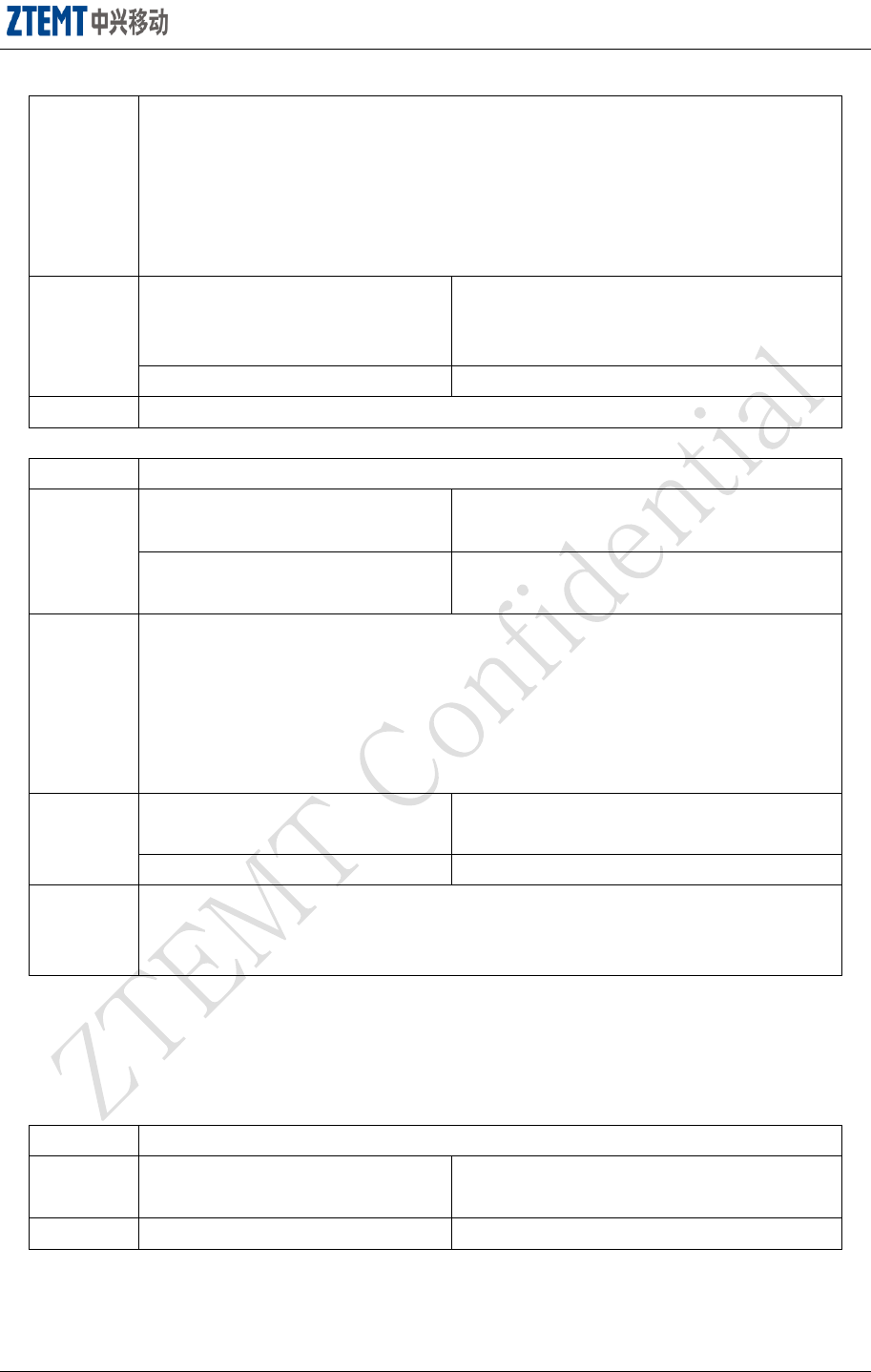
AT Command User Manual V1.1 Open▲
Page 41 of 52
parameter
<X>
the Secondary Home Agent IP Address string MUST be enclosed between double
quotes. Valid values for X are ( (0-255).(0-255).(0-255).(0-255)).
<Y>
0: NOT save the change to NV memory
1: save the change to NV memory
example
AT$QCMIPSHA?
$QCMIPSHA: 192.168.1.10,0
OK
AT$QCMIPSHA=“192.168.1.10”,0
OK
note
CE MUST return “ERROR” for any other AT$QCMIPSHA string.
4.1.16 $QCMIPHA: Set Home Agent IP Address
description
Set Home Agent IP Address the change to NV memory
format
AT$QCMIPHA?
<CR><LF>$QCMIPHA: <X>,<Y>
<CR><LF><CR><LF>OK<CR><LF>
AT$QCMIPHA =”<X>”,<Y>
<CR><LF><CR><LF>OK<CR><LF>
parameter
<X>
the Home Agent IP Address string MUST be enclosed between double quotes. Valid
values for X are ((0-255).(0-255).(0-255).(0-255)).
<Y>
0: NOT save the change to NV memory
1: save the change to NV memory
example
AT$QCMIPHA?
$QCMIPHA: 192.168.1.1,0
OK
AT$ QCMIPHA=”192.168.1.10”,0
OK
note
CE MUST return “ERROR” for any other AT$QCMIPHA string.
CE MUST use the IP Address in NV memory after the MIP session has deregistered
or expired if Y is set to 0
5 Sprint Specific AT Commands
5.1 CDMA AT Commands
5.1.1 ATD: Make a packet data call
description
Make a packet data call
format
ATD<number>
<CR><LF><CR><LF>OK<CR><LF>
example
ATD#777
OK
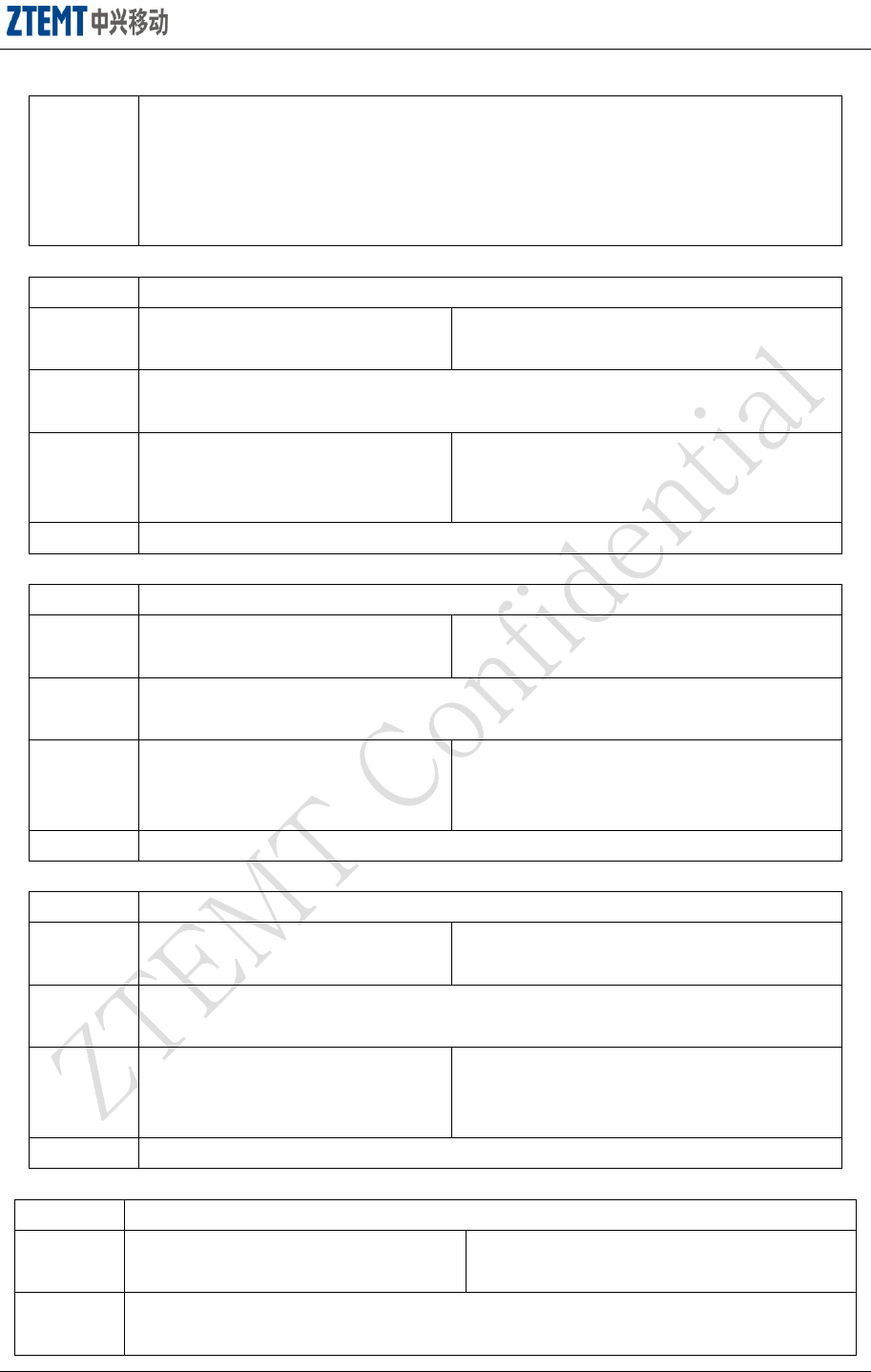
AT Command User Manual V1.1 Open▲
Page 42 of 52
note
CE MUST ignore any <number> and establish a packet data call.
Note: in the past only #777, which is configured in a NV item, would cause the
device to establish a packet data connection. As Sprint no longer allows any other
type of data connection with our devices, this requirement will in effect disable the
ability to use the device as a modem or fax
5.1.2 $MDN: Return the 10 digit mobile directory number
description
Return the 10 digit mobile directory number
format
AT$MDN?
<CR><LF>$MDN: <value><CR><LF>
<CR><LF>OK<CR><LF>
parameter
<value>
The 10 digit mobile directory number
example
AT$MDN?
$MDN: 1111111111
OK
note
CE MUST return “ERROR” for any other AT$MDN string
5.1.3 $MSID: Return Mobile Station ID
description
Return Mobile Station ID
format
AT$MSID?
<CR><LF>$MSID: <value><CR><LF>
<CR><LF>OK<CR><LF>
parameter
<value>
the 10 digit mobile directory number
example
AT$MSID?
$MSID: 0966661668
OK
note
CE MUST return “ERROR” for any other AT$MSID string.
5.1.4 $MIPERR: Return the last MIP error code received by the device
description
Return the last MIP error code received by the device
format
AT$MIPERR?
<CR><LF>$MIPEER: <value><CR><LF>
<CR><LF>OK<CR><LF>
parameter
<value>
the last MIP error code
example
AT$MIPERR?
$MIPERR: 0
OK
note
CE MUST return “ERROR” for any other AT$MIPERR string.
5.1.5 $ERI: Return the current Enhanced Roaming Indicator value
description
Return the current Enhanced Roaming Indicator value
format
AT$ERI?
<CR><LF>$ERI: <value><CR><LF>
<CR><LF>OK<CR><LF>
parameter
<value>
decimal as defined in the Sprint Enhanced Roaming Indicators document [9]
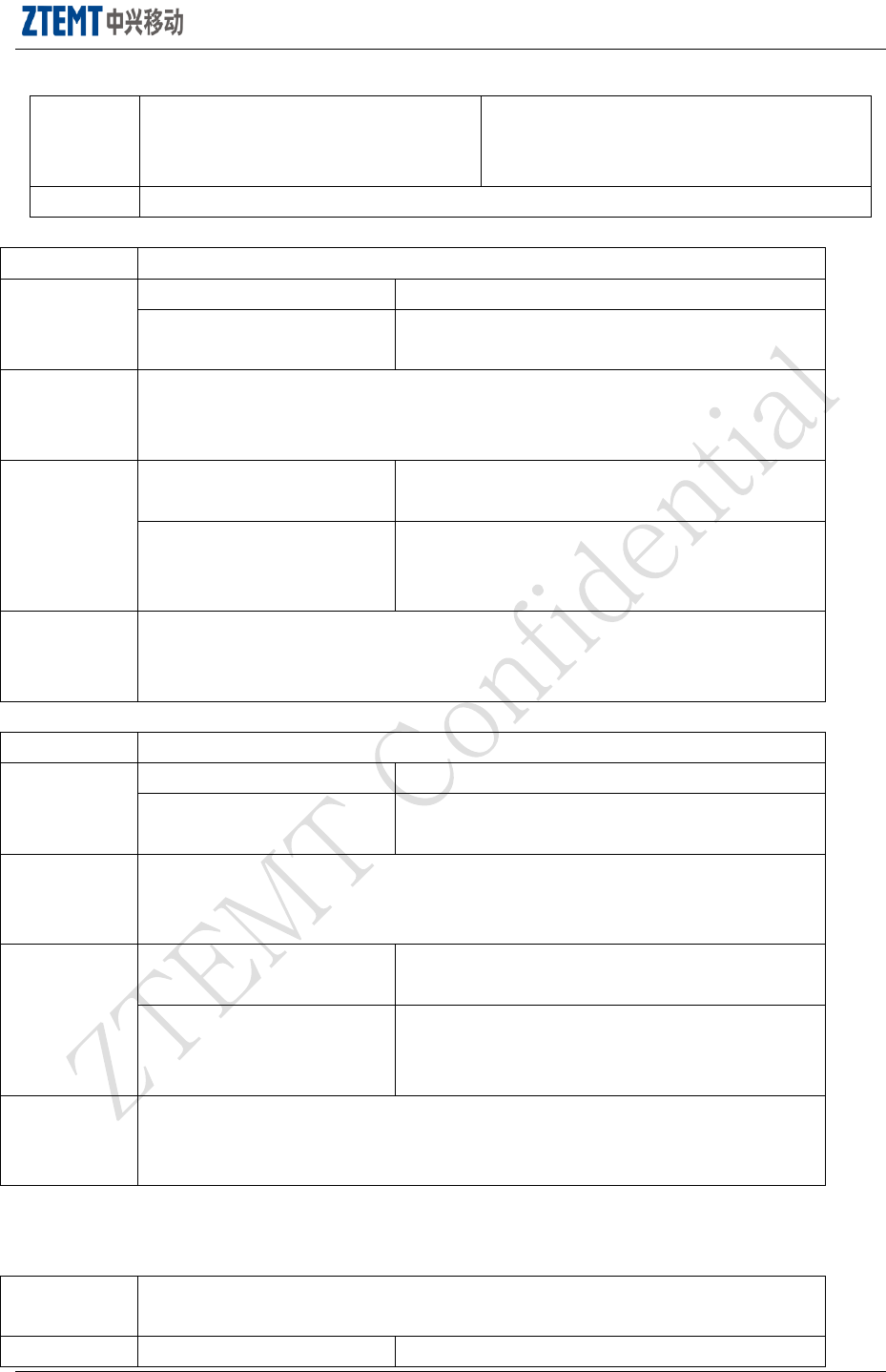
AT Command User Manual V1.1 Open▲
Page 43 of 52
example
AT$ERI?
$ERI: 0
OK
note
CE MUST return “ERROR” for any other AT$ ERI string
5.1.6 $ROAM: Set the device mode
description
Set the device mode
format
AT$ROAM=<N>
<CR><LF>OK<CR><LF>
AT$ROAM=?
<CR><LF>$ROAM: <N><CR><LF>
<CR><LF>OK<CR><LF>
parameter
<N>
0:set the device to Sprint only mode
1:set the device to automatic mode
example
AT$ROAM=1
OK
AT$ROAM?
$ROAM: 1
OK
note
CE MUST return "ERROR" for any other AT$ROAM string
CE MUST set the default value of AT$ROAM to the value defined in the Sprint
PRI Template Program Release Instructions and factory default template [6]
5.1.7 $RMGUARD: Set roam guard(Not implemented)
description
Set roam guard
format
AT$RMGUARD=<N>
<CR><LF>OK<CR><LF>
AT$RMGUARD=?
<CR><LF>$RMGUARD: <N><CR><LF>
<CR><LF>OK<CR><LF>
parameter
<N>
1:set roam guard to never ask
2:set roam guard to always ask
example
AT$RMGUARD=1
OK
AT$RMGUARD=?
$RMGUARD: 1
OK
note
CE MUST return "ERROR" for any other AT$RMGUARD string
CE MUST set the default value of AT$RMGUARD to the value defined in the
Sprint PRI Template Program Release Instructions and factory default template [6]
5.2 OMA-DM commands
5.2.1 +OMADM: Disable/Enable OMA-DM capabilities
description
Disable/Enable OMA-DM capabilities, save the OMA-DM setting through power
cycles
format
AT+OMADM=<N>
<CR><LF>OK<CR><LF>
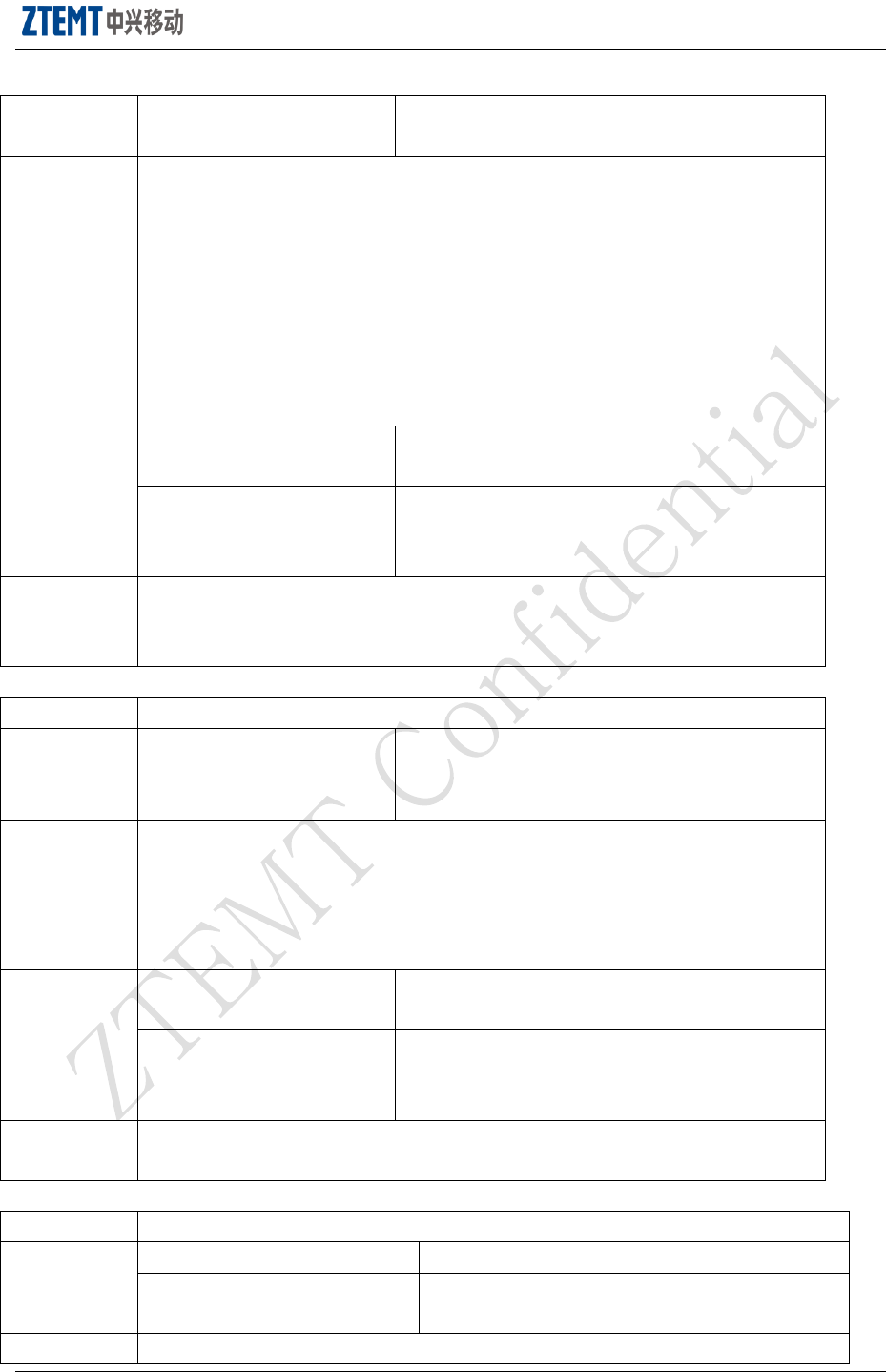
AT Command User Manual V1.1 Open▲
Page 44 of 52
AT+OMADM=?
<CR><LF>+OMADM: <N><CR><LF>
<CR><LF>OK<CR><LF>
parameter
<N>
0:disable OMA-DM capabilities, ignore network initiated OMA-DM WAP Push
messages. If the user attempts a client initiated OMA-DM session when
OMA-DM is disabled, the CE MUST perform a client initiated OMA-DM session
but will not enable OMA-DM capabilities
1:enable OMA-DM capabilities
2:launch a client initiated OMA-DM session
Note: if OMA-DM is currently disabled this AT command will launch a client
initiated OMA-DM session but will not enable OMA-DM capabilities
example
AT+OMADM=1
OK
AT+OMADM=?
+OMADM: 1
OK
note
CE MUST ignore network initiated OMA-DM WAP Push messages when
OMA-DM is disabled
CE MUST set the default value of AT+OMADM to 1
5.2.2 +OMALOG: Disable/Enable OMA-DM client logging
description
Disable/Enable OMA-DM client logging
format
AT+OMALOG=<N>
<CR><LF>OK<CR><LF>
AT+OMALOG=?
<CR><LF>+OMALOG: <N><CR><LF>
<CR><LF>OK<CR><LF>
parameter
<N>
0:disable OMA-DM client logging
1:enable OMA-DM client logging. CE MUST write the complete OMA-DM XML
transactions to a single file in the EFS for later retrieval when OMA-DM client
logging is turned on
example
AT+OMALOG=1
OK
AT+OMALOG=?
+OMALOG: 1
OK
note
CE MUST return "ERROR" for any other AT+OMALOG string
CE MUST set the default value of AT+OMADM to 0
5.2.3 +FUMO: Disable/Enable FUMO capabilities
description
Disable/Enable FUMO capabilities
format
AT+FUMO=<N>
<CR><LF>OK<CR><LF>
AT+FUMO=?
<CR><LF>+FUMO: <N><CR><LF>
<CR><LF>OK<CR><LF>
parameter
<N>
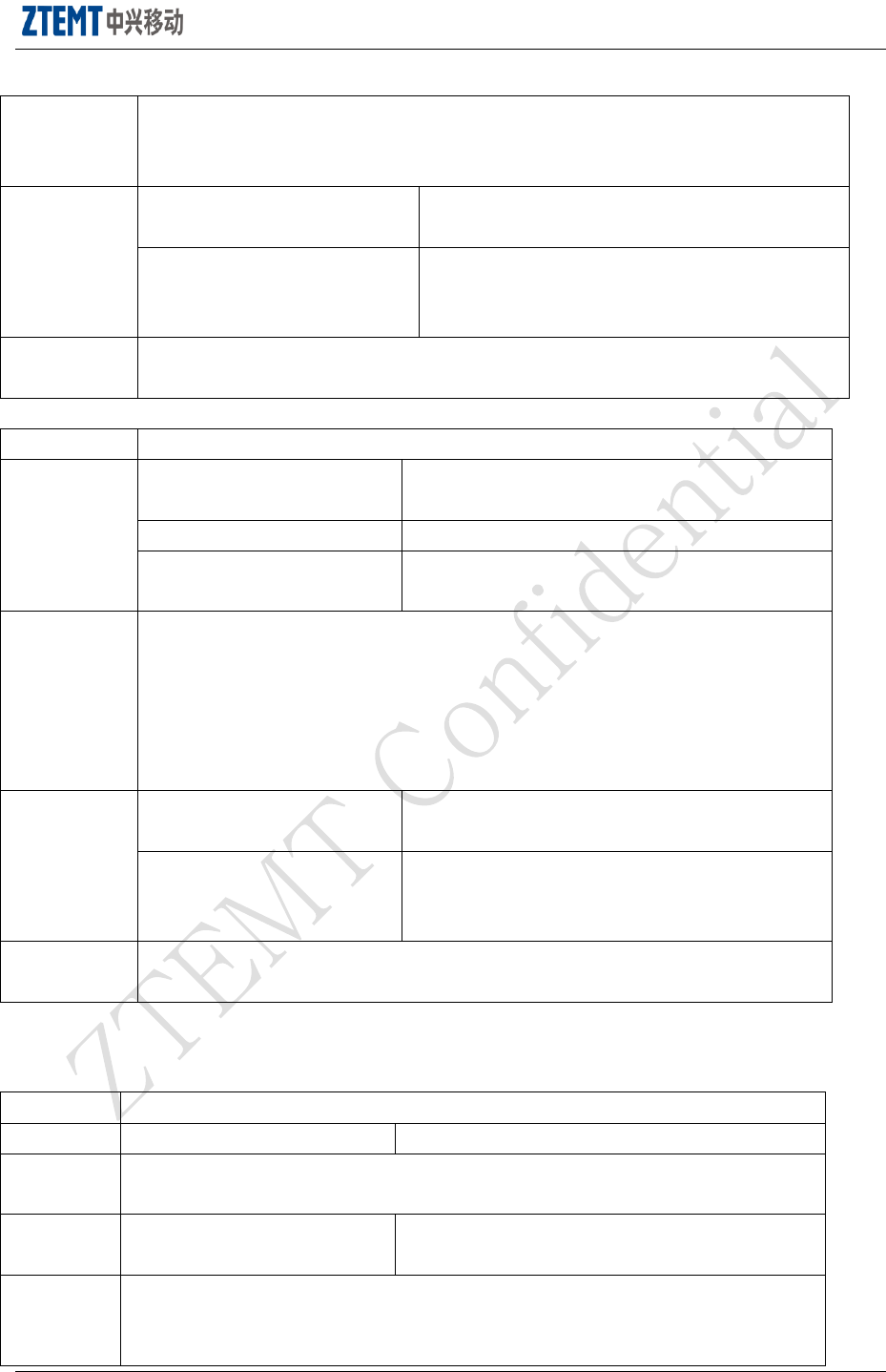
AT Command User Manual V1.1 Open▲
Page 45 of 52
0:disable FUMO capabilities
1:enable FUMO capabilities
2:perform a client initiated FUMO session, but will not enable FUMO capabilities
example
AT+FUMO=1
OK
AT+FUMO=?
+FUMO: 1
OK
note
CE MUST set the default value of AT+FUMO to 1
CE MUST return "ERROR" for any other AT+FUMO string
5.2.4 +PRL: Get CDMA PRL version of the device
description
Get CDMA PRL version of the device
format
AT+PRL?
<CR><LF>+ PRL: <VERSION><CR><LF>
<CR><LF>OK<CR><LF>
AT+PRL=<N>
<CR><LF>OK<CR><LF>
AT+PRL=?
<CR><LF>+PRL: <N><CR><LF>
<CR><LF>OK<CR><LF>
parameter
<N>
0: disable PRL update capabilities
1: enable PRL update capabilities.
2: perform a client initiated PRL update
3: set the device to check for PRL updates every 45 days
4: set the device to check for PRL updates every 90 days.
example
AT+PRL=1
OK
AT+PRL=?
+PRL: 1
OK
note
CE MUST set the default value of AT+PRL to 1
CE MUST return "ERROR" for any other AT+PRL string
5.3 Device reset commands
5.3.1 $RTN: Set the device to factory defaults
description
Set the device to factory defaults
format
AT$RTN=<N>
<CR><LF>OK<CR><LF>
parameter
<N>
the device MSL
example
AT$RTN=000000
OK
note
CE MUST set the device to factory defaults and power cycle the device if the correct
MSL is entered
CE MUST return "ERROR" if the MSL is not correct and not power cycle the device
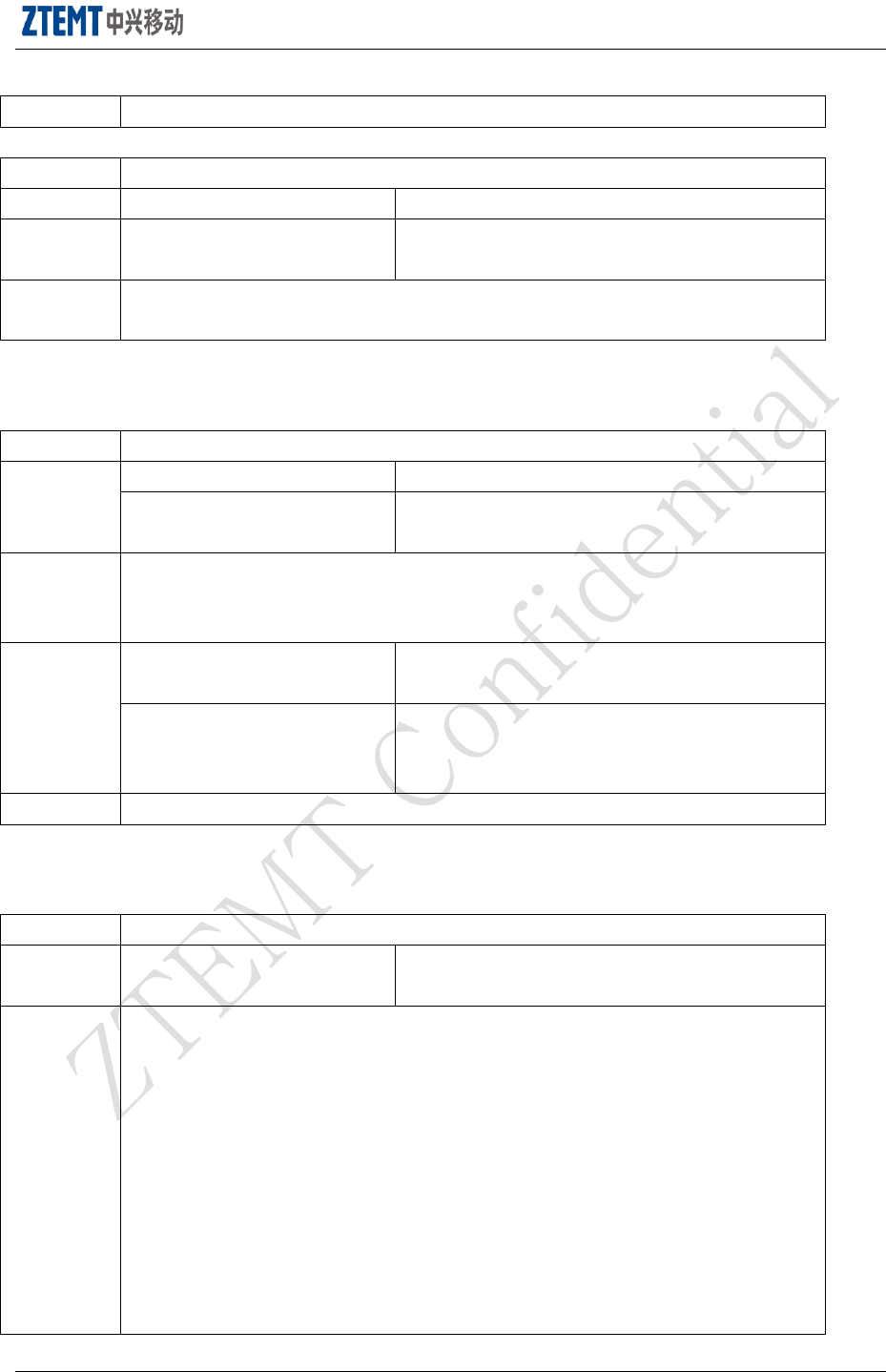
AT Command User Manual V1.1 Open▲
Page 46 of 52
CE MUST return "ERROR" for any other AT$RTN string
5.3.2 $RESET: Initiate a device power cycle
description
Initiate a device power cycle
format
AT$RESET
<CR><LF>OK<CR><LF>
example
AT$RESET
OK
note
CE MUST support "AT$RESET" which will immediately initiate a device power
cycle
5.4 LED commands
5.4.1 +LED: Disable/Enable all LEDs on the device(not supported)
description
Disable/Enable all LEDs on the device
format
AT+LED=<N>
<CR><LF>OK<CR><LF>
AT+LED?
<CR><LF>+LED: <N><CR><LF>
<CR><LF>OK<CR><LF>
parameter
<N>
1:disable all LEDs on the device
2:enable all LEDs on the device
example
AT+LED=1
OK
AT+LED=?
+LED: 1
OK
note
for data only devices
5.5 Debug commands
5.5.1 +SERVICE: Return the integer index of data service
description
Return the integer index of data service
format
AT+SERVICE?
<CR><LF>+SERVICE: <value><CR><LF>
<CR><LF>OK<CR><LF>
parameter
<value>
0: No Service
1: 1xRTT
2: EVDO Rev 0
3: EVDO Rev A
4: GPRS
5: UMTS
6: EDGE
7: WiMax
8: WiFi
9: LTE
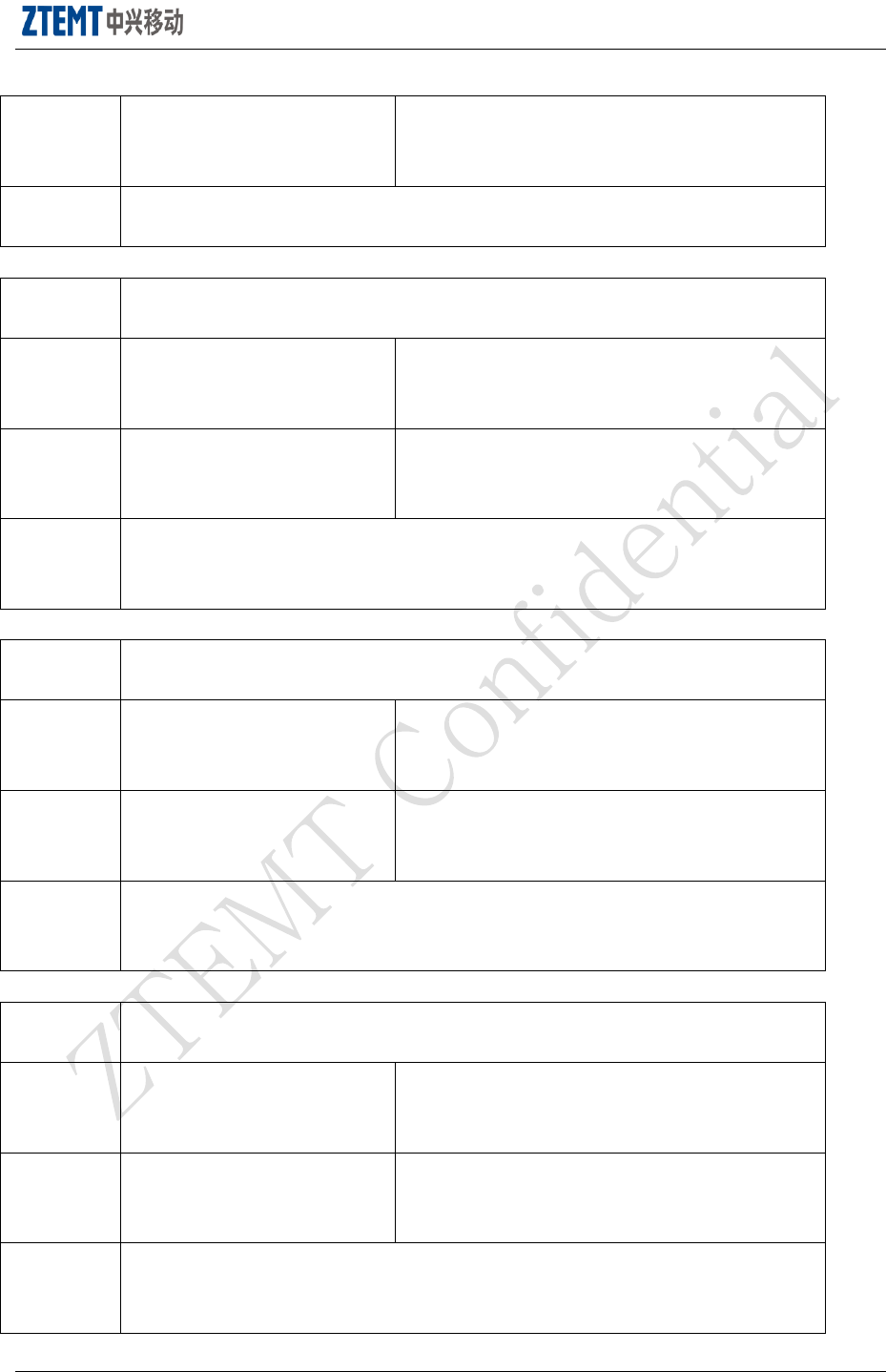
AT Command User Manual V1.1 Open▲
Page 47 of 52
example
AT+SERVICE?
+SERVICE: 3
OK
note
This command will return either the service of the active data session or the service
that will be attempted when a data session will be established.
5.5.2 $1XRXPWR: Return CDMA 1X channel, Pilot, and immediate RSSI
description
Return the CDMA 1X channel, Pilot, and immediate RSSI measurements in dBm for
each antenna on separate lines in the format
format
AT$1XRXPWR?
<CR><LF>$1XRXPWR: <antenna>,<Channel>,
<Pilot>,<RSSI><CR><LF><CR><LF>OK<CR>
<LF>
example
AT$1XRXPWR?
0,100,247,-85.5
OK
note
If the device does not support multiple antennas, only one value is returned. If the
device supports multiple antennas, the primary antenna is listed first followed by
additional antennas
5.5.3 $DORXPWR: Return the EVDO channel, Pilot, and immediate RSSI
description
Return the EVDO channel, Pilot, and immediate RSSI measurements in dBm for
each antenna on separate lines in the format
format
AT$DORXPWR?
<CR><LF>$DORXPWR: <antenna>,<Channel>,
<Pilot>,<RSSI> <CR><LF><CR><LF>OK<CR>
<LF>
example
AT$DORXPWR?
0,100,247,-85.5
OK
note
If the device does not support multiple antennas, only one value is returned. If the
device supports multiple antennas, the primary antenna is listed first followed by
additional antennas
5.5.4 $1XECIO: Return the CDMA 1X Channel, Pilot, and immediate Ec/Io
description
Return the CDMA 1X Channel, Pilot, and immediate Ec/Io measurements in dB for
each antenna on separate lines in the format
format
AT$1XECIO?
<CR><LF>$1XECIO: <antenna>,<Channel>,
<Pilot>,<Ec/Io><CR><LF><CR><LF>OK<CR>
<LF>
example
AT$1XECIO?
0,50,247,-85.5
OK
note
If the device does not support multiple antennas, only one value is returned. If the
device supports multiple antennas, the primary antenna is listed first followed by
additional antennas
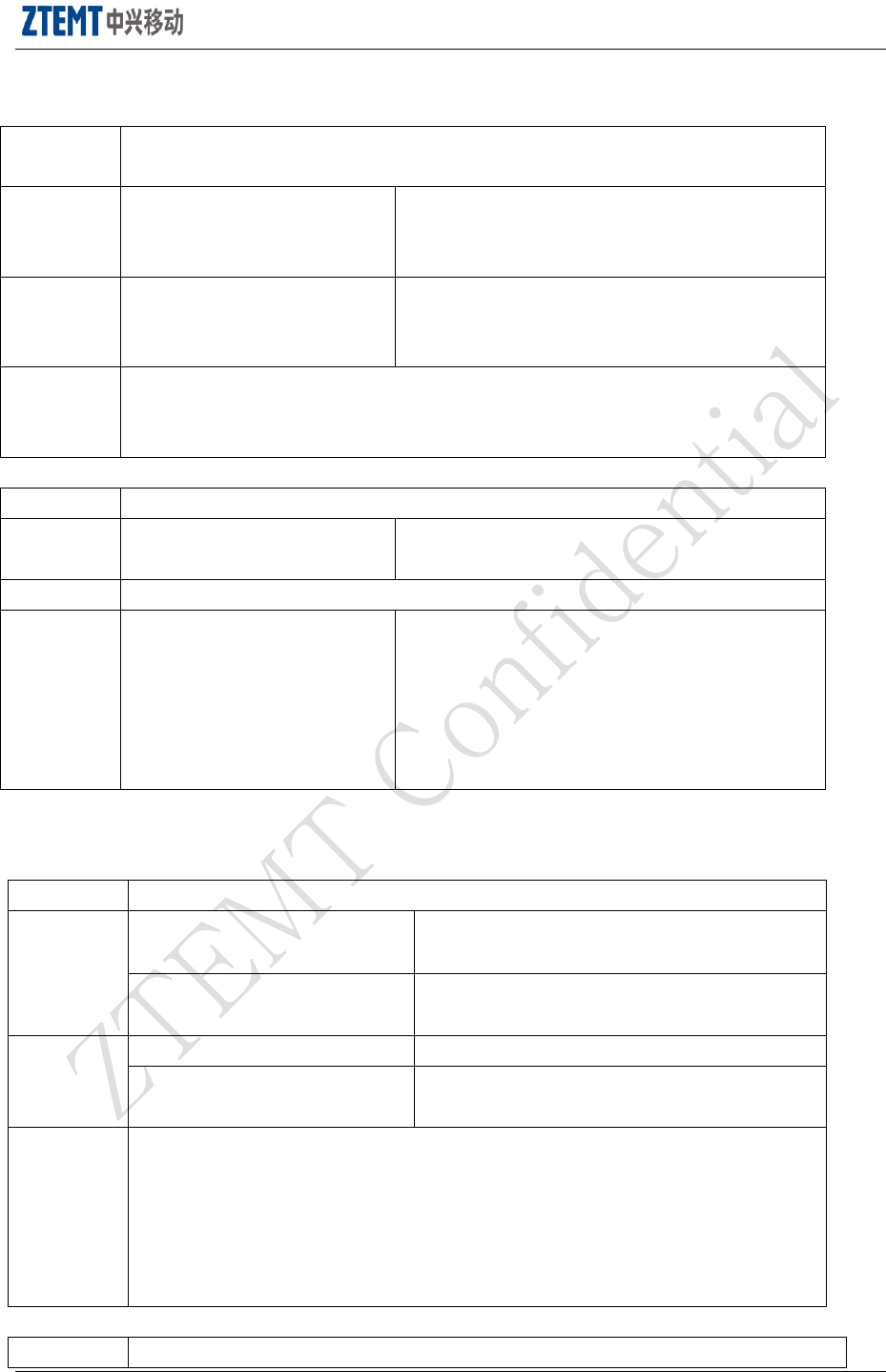
AT Command User Manual V1.1 Open▲
Page 48 of 52
5.5.5 $DOECIO: Return EVDO channel, Pilot, and immediate RSSI
description
return the EVDO channel, Pilot, and immediate RSSI measurements in dBm for each
antenna on separate lines in the format
format
AT$DOECIO?
<CR><LF>$DOECIO: <antenna>,<Channel>,
<Pilot>,<RSSI><CR><LF><CR><LF>OK<CR>
<LF>
example
AT$DOECIO?
0,100,247,-2.4
OK
note
If the device does not support multiple antennas, only one value is returned. If the
device supports multiple antennas, the primary antenna is listed first followed by
additional antennas
5.5.6 $DEBUG: Return the debug information
description
Return the debug information
format
AT$DEBUG?
<CR><LF><CR><LF><Fieldname>:<value>
<CR><LF><CR><LF>OK<CR><LF>
parameter
example
AT$DEBUG?
1x Engineering
State : Idle
SO : 3
….
OK
5.6 Location commands(only support MC2718)
5.6.1 $LOCATION: Enable/Disable the location service
description
Enable/Disable the location service
format
AT$LOCATION=<flag>
<CR><LF>OK<CR><LF>
AT$LOCATION=?
<CR><LF><flag><CR><LF><CR><LF>
OK<CR><LF>
example
AT$LOCATION=1
OK
AT$LOCATION=?
1
OK
note
CE MUST support "AT$LOCATION=0" which will disable location services
CE MUST support "AT$LOCATION=1" which will enable location services
CE MUST support "AT$LOCATION=?" which will return the status of location
services
The command will return 0 if locations services are disabled and return 1 if location
services are enabled
5.6.2 $PDE: Set PDE Server IP and Port
description
Set PDE Server IP and Port
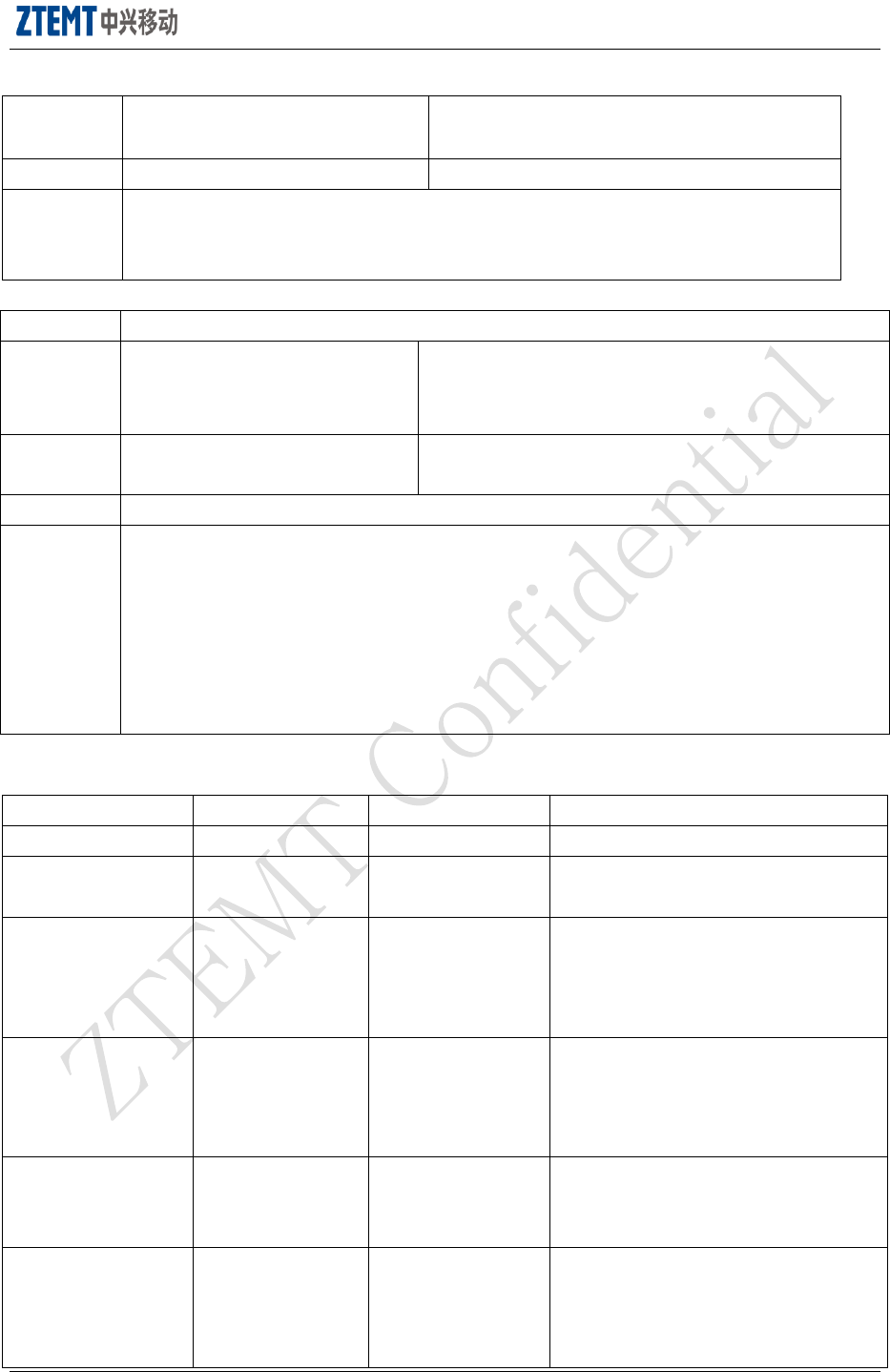
AT Command User Manual V1.1 Open▲
Page 49 of 52
format
AT$PDE=<IP>,<port>
<CR><LF>OK<CR><LF>
example
AT$ PDE=192.168.1.1,6000
OK
note
IP is the IPv4 address in dotted decimal format
(<0-255>.<0-255>.<0-255>.<0-255>)
Port is the numeric port (0-65535) for the PDE server
5.6.3 $GETLOCATION: Get the device current location in the specified format
description
Get the device current location in the specified format
format
AT$GETLOCATION
<CR><LF>MM/DD/YYYY, HH:MM:SS,
±DD.dddddd, ±DDD.dddddd, ±nnnn,nnnnnn, nnn,
±DDD.dd, nn<CR><LF>
example
AT$GETLOCATION
09/24/2009, 21:43:57, 39.012345, -104.012345, +312,
1234567, 1234567, 40, 359.93, 13
parameter
See table 3-1
note
CE MUST support "AT$GETLOCATION" which will return the device current location in
the specified format
CE MUST return the text "UNK" for any parameter which isn‟t known in the
AT+GETLOCATION return string
CE MUST return "ERROR" if the location position is not able to be retrieved.
CE will include the case where location services are turned off and the user issues the
AT+GETLOCATION command
Table 3-1 Location Field Description
Field
Format
Example
Comment
Date samp-GMT
MM/DD/YYYY
09/24/2009
24 hour time
stamp-GMT
HH:MM:SS
21:43:57
Latitude in decimal
degrees
+/-DD.dddddd
39.012345
Latitude North =+
Latitude South =-;
Max of 90.000000 degrees;
Latitude *180/2^25;
Longitude in
decimal degrees
+/-DDD.dddddd
-104.0125345
Longitude East is +,
Longitude West is -;
Max of 180.000000 degrees
Longitude*360/10^26
Elevation in meters
+/-nnnn
+321
In meters above [+]or below [-] sea
level with reference to the WGS-84
reference Ellipsoid
HEPE in meters
nnnnnn
123654
Inter valued,negative not allowed
HEPE=SQRT((LOC_UNCRTNTY_A*
LOC_UNCRTNTY_A))+
(LOC_UNCRTNTY_P*
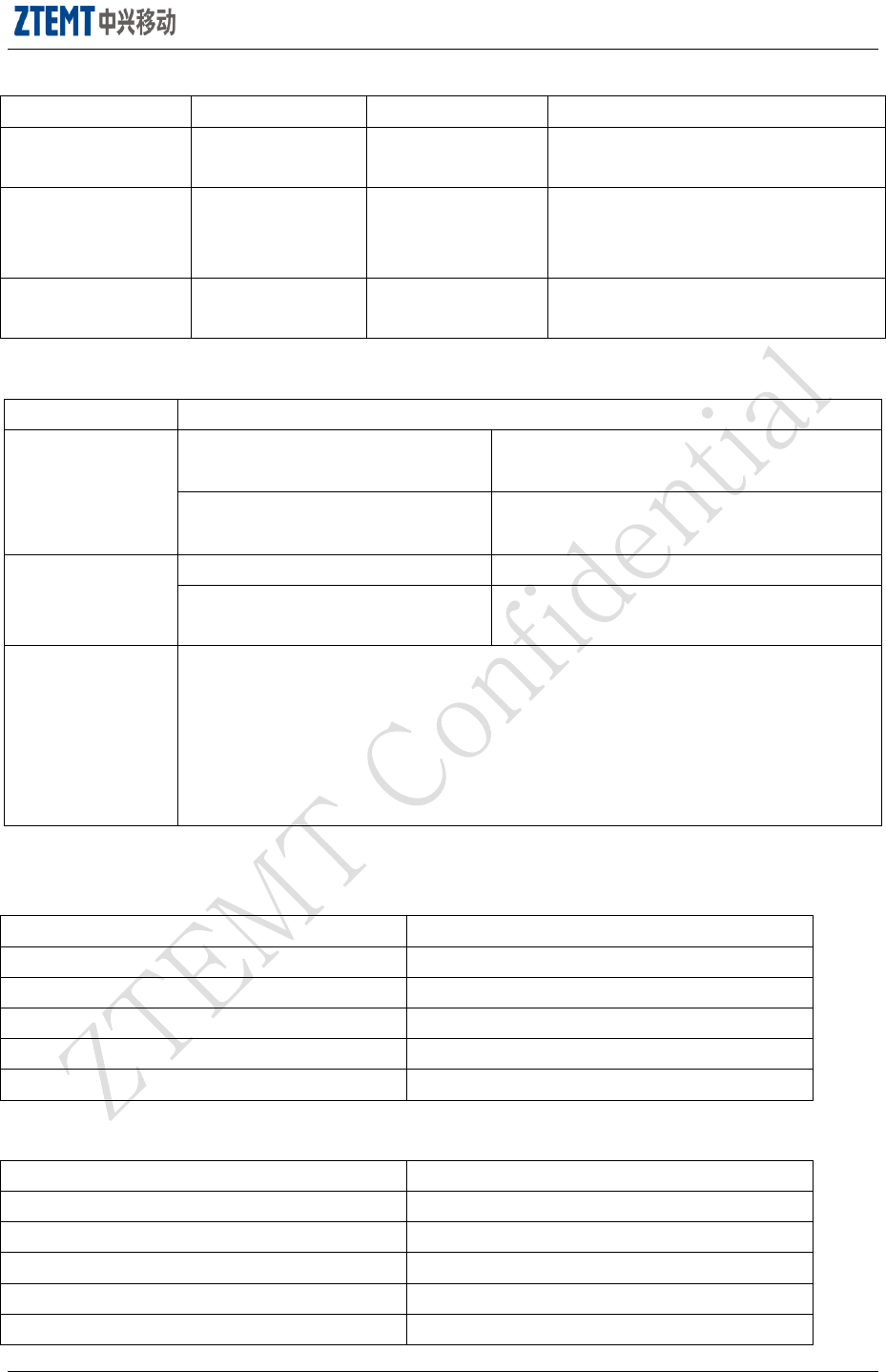
AT Command User Manual V1.1 Open▲
Page 50 of 52
LOC_UNCRTNTY_P))
Speed in meters per
second
nnn
40
Inter valued,negative not allowed
Bearing in decimal
degrees
=/-DDD.dd
359.93
In positive decimal degrees;negatives
not allowed
Bearing = Heading*360/2^10
#satellites used in
location fix
nn
13
Inter valued,negative not allowed
5.6.4 $LOCMODE: Set the GPS location mode
description
Set the GPS location mode
format
AT$LOCMODE=<mode>
<CR><LF>OK<CR><LF>
AT$LOCMODE=?
<CR><LF><mode><CR><LF>
<CR><LF>OK<CR><LF>
example
AT$LOCATION=4
OK
AT$LOCMODE=?
4
OK
note
Once the next AT$ LOCMODE has been executed the device needs to
return to the default location mode
CE MUST reset the location acquisition mode after a location acquisition
request has been executed, regardless of the execution was successful or
not
CE MUST return "ERROR" for any other AT$LOCMODE string
<mode> Parameter:
“AT$LOCMODE=1” to set the GPS location fix to MS-Assisted using the following values.
Sessin Type
Single Shot Fix
Operational mode
MS-Assisted
PDE IP Address and Port
Current device stored values
Quality of Service
16
Number of Fixes
1
Time Between Fixes
1
“AT$LOCMODE=2” to set the GPS location fix to MS-Based using the following values.
Sessin Type
Tracking
Operational mode
MS-Based
PDE IP Address and Port
Current device stored values
Quality of Service
16
Number of Fixes
9999
Time Between Fixes
1
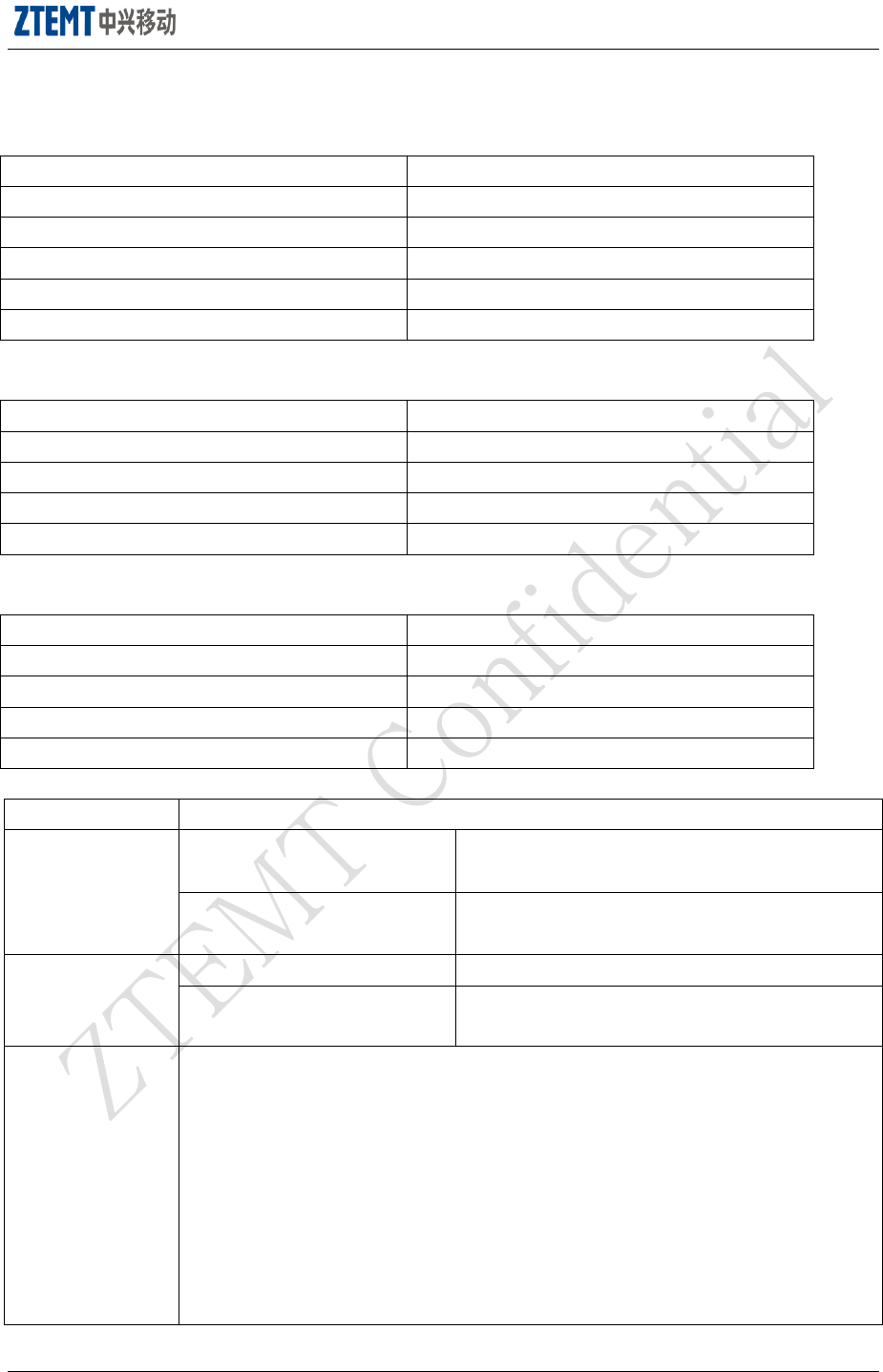
AT Command User Manual V1.1 Open▲
Page 51 of 52
“AT$LOCMODE=3” to set the GPS location fix to AFLT using the following values.
Sessin Type
Single Shot Fix
Operational mode
MS-Assisted
PDE IP Address and Port
Current device stored values
Quality of Service
0
Number of Fixes
1
Time Between Fixes
1
“AT$LOCMODE=4” to set the GPS location fix to Autonomous using the following values.
Sessin Type
Tracking
Operational mode
Autonomous GPS
Quality of Service
255
Number of Fixes
9999
Time Between Fixes
1
“AT$LOCMODE=?” Return the current value of the location mode
Return value
Meaning
1
MS-Assisted
2
MS-Based
3
AFLT
4
Autonomous
5.6.5 $NMEA: Enable/Disable the NMEA 183 standard stream
description
Enable /Disable the NMEA 183 standard stream
format
AT$NMEA=<flag>
<CR><LF>OK<CR><LF>
AT$NMEA=?
<CR><LF><flag><CR><LF>
<CR><LF>OK<CR><LF>
example
AT$NMEA=1
OK
AT$NMEA=?
1
OK
note
CE MUST support "AT$NMEA=0" which will enable the NMEA 183 standard
stream
CE MUST support "AT$NMEA=1" which will disable the NMEA 183 standard
stream
CE MUST support "AT$NMEA=?" which will return the NMEA 183 standard
stream setting
CE will return 0 if the stream is off and 1 if the stream is on.
CE MUST only return the following NEMA 183 sentences: $GPGGA, $GPGSA,
$GPGSV, $GPRMC, $GPVTG
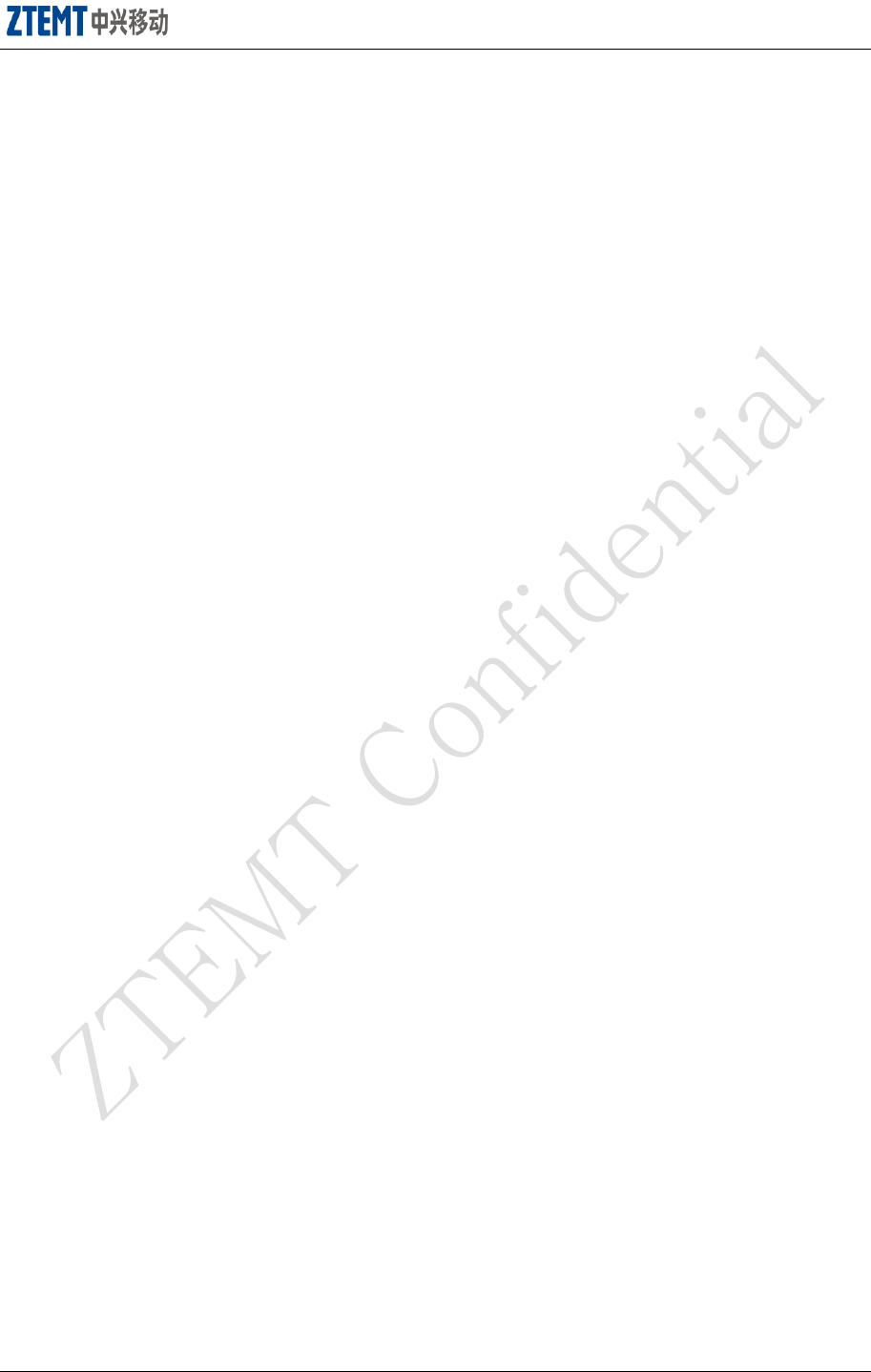
AT Command User Manual V1.1 Open▲
Page 52 of 52
FCC Regulations:
This device complies with part 15 of the FCC Rules. Operation is subject to the following two conditions:
(1) This device may not cause harmful interference, and (2) this device must accept any interference
received, including interference that may cause undesired operation.
This device has been tested and found to comply with the limits for a Class B digital device, pursuant to
Part 15 of the FCC Rules. These limits are designed to provide reasonable protection against harmful
interference in a residential installation. This equipment generates, uses and can radiated radio frequency
energy and, if not installed and used in accordance with the instructions, may cause harmful interference to
radio communications. However, there is no guarantee that interference will not occur in a particular
installation If this equipment does cause harmful interference to radio or television reception, which can be
determined by turning the equipment off and on, the user is encouraged to try to correct the interference by
one or more of the following measures:
-Reorient or relocate the receiving antenna.
-Increase the separation between the equipment and receiver.
-Connect the equipment into an outlet on a circuit different from that to which the receiver is connected.
-Consult the dealer or an experienced radio/TV technician for help.
Changes or modifications not expressly approved by the party responsible for compliance could void the
user„s authority to operate the equipment.
The antenna(s) used for this transmitter must not be co-located or operating in conjunction with any other
antenna or transmitter.
RF Exposure Information
This device meets the government‟s requirements for exposure to radio waves.
This device is designed and manufactured not to exceed the emission limits for exposure to radio frequency
(RF) energy set by the Federal Communications Commission of the U.S. Government.
This device complies with FCC radiation exposure limits set forth for an uncontrolled environment. In
order to avoid the possibility of exceeding the FCC radio frequency exposure limits, human proximity to
the antenna shall not be less than 20cm (8 inches) during normal operation.
When the module is installed in the host device, the FCC ID label must be visible through a window on the
final device or it must be visible when an access panel, door or cover is easily re-moved. If not, a second
label must be placed on the outside of the final device that contains the following text: “Contains FCC ID:
Q78-MC2718”